
RED SEA: DON’T OVERPLAY THE ISSUES
EGYPT: PRIVATE SECTOR $ POUR IN
BUENOS AIRES: WHAT NEXT?
PREPARING FOR COASTLINK
JANUARY/FEBRUARY 2024 VOL 1024 ISSUE 1 portstrategy.com Hydrogen Equipment Trials | Beware Data Scraping | Engine Innovation Builds


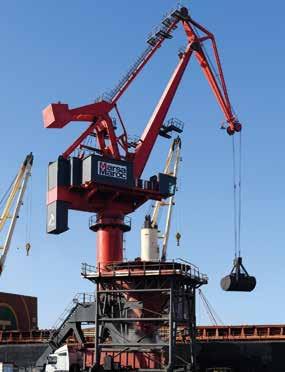



 MIKE MUNDY
MIKE MUNDY
2024 Promises an Interesting Cocktail of Coverage
The international magazine for senior port & terminal executives
EDITORIAL & CONTENT
Editorial Director: Mike Mundy mmundy@portstrategy.com
Features Editor: A J Keyes keyesj186@gmail.com
Consultant Editor: Andrew Penfold andypenfold@yahoo.com
Regular Correspondents: Felicity Landon; Stevie Knight; Ben Hackett; Peter de Langen; Charles Haine; AJ Keyes; Andrew Penfold; Oleksandr Gavrylyuk Johan-Paul Verschuure; Phoebe Davison
Production David Blake, Paul Dunnington production@mercatormedia.com
SALES & MARKETING
t +44 1329 825335 f +44 1329 550192
How much do we believe all the ‘noise’ surrounding the Red Sea Crisis? In true PS analytical style, we drill down into the facts and come up with a fresh take on the foreseeable economic impact. This edition of PS also contains a strong focus on investment hotspots and addresses a number of other issues of the moment, not the least of which is dealing with the so-called dark fleet and what the future holds for Buenos Aires, a long-running controversial subject!
Welcome to 2024 where PS has a lot lined up for you via the magazine, online and at various industry meets.
Geopolitical events are to the fore – ‘mad Vlad’, as the UK’s Sun newspaper aptly names President Putin, continues to wage his war of aggression against Ukraine, which to me, and doubtless many of you, seems to lack any meaningful purpose other than some flawed dream to rebuild the Soviet Union. Definitely ‘nuts stuff’ and the product of a deranged mind but nevertheless very important to react against for a number of fundamental reasons – not least to stop the contagion of Putin’s thinking spreading and to provide stability in the food and energy markets.
Clearly, the International Maritime Organization (IMO) agrees – our review of IMO’s latest thinking, on p54 highlights newly appointed Secretary-General, Arsenio Dominguez referencing the so-called dark fleet and calling on “Member States to uphold their responsibilities when it comes to implementing regulations.” The view is very clear that Member States are seen to have a role to play in conjunction with vessels evading safety conventions and operating without proper insurance cover, while breaking international sanctions to carry, for example, Russian, Iranian or Venezuelan oil cargoes.
The Red Sea crisis also comes into IMO’s focus – with the emphasis placed on the safety of seafarers.
We too add some interesting dimensions to this subject, Ben Hackett, regular writer of our Economist column, highlights how quickly much of the shipping sector has acted to avoid the threats in the Red Sea and how some ports will benefit from the introduction of more vessels using the Cape of Good Hope route. In key respects, he dubs the event, “a storm in a teacup.” Andrew Penfold, in the article Don’t Overplay the Issues, drills down into the economic impact of the crisis and suggests that there is too much ‘noise’ in this respect, in both the container and bulk shipping sectors, and that proper analysis suggests a limited impact.
In terms of port investment, there is a big story to tell in Egypt (p26), a positive story in Turkey along its Mediterranean coast where the ports of LimakPort Iskenderun and Mersin are strongly pursuing positive development after the problems posed by the major earthquake in the area (p28) and, admittedly on less of a positive note, we look at what the future holds for container operations in Buenos Aires under the new Milei Government (p40).
Looking ahead I would like to highlight the Safe Mooring Seminar PS is running in conjunction with Through Transport Club on 28 March in London. All critical aspects of safe berthing will be examined in this important day seminar. I hope to see you there and that generally PS keeps you well informed, in advance of your needs, in 2024.
Media Sales Manager: Arrate Landera alandera@mercatormedia.com
Marketing marketing@mercatormedia.com
Chief Executive: Andrew Webster awebster@mercatormedia.com
PS magazine is published bi-monthly by Mercator Media Limited, Spinnaker House, Waterside Gardens, Fareham, Hants PO16 8SD UK t +44 1329 825335 f +44 1329 550192 info@mercatormedia.com www.mercatormedia.com
Subscriptions
Subscriptions@mercatormedia.com Register and subscribe at www.portstrategy.com
1 year’s digital subscription with online access £244.00
For Memberships and Corporate/ multi-user subscriptions: corporatesubs@mercatormedia.com
©Mercator Media Limited 2024. ISSN 1740-2638 (print) ISSN 2633-4232 (online). Port Strategy is a trade mark of Mercator Media Ltd. All rights reserved. No part of this magazine can be reproduced without the written consent of Mercator Media Ltd. Registered in England Company Number 2427909. Registered office: c/o Spinnaker House, Waterside Gardens, Fareham, Hampshire, PO16 8SD, UK.

For the latest news and analysis go to www.portstrategy.com JANUARY/FEBRUARY 2024 | 3
PORTSTRATEGY INSIGHT FOR PORT EXECUTIVES
VIEWPOINT
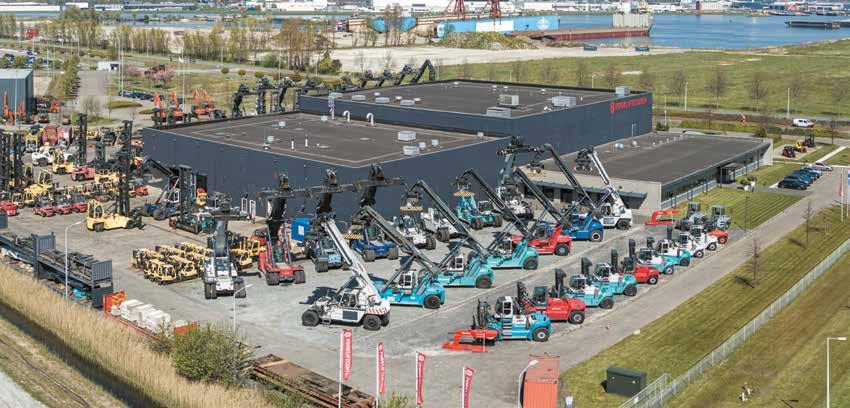

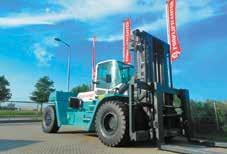
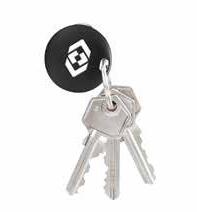
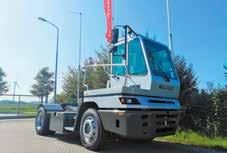
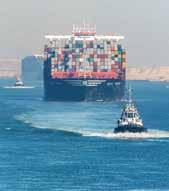
11
13
13
19

19
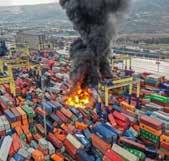
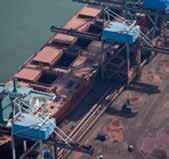




For the latest news and analysis go to www.portstrategy.com JANUARY/FEBRUARY 2024 | 5 Social Media links LinkedIn PortStrategy portstrategy YouTube The Congress is a meeting point that provides senior executives with the solutions they require to meet regulatory and operationalenvir challenges. Stay in touch at greenport.com Join leading port executives in Athens, Greece from 14-16 October 2019 www.greenport.com/congress Online portstrategy.com 5 Latest news 5 Comment & analysis 5 Industry database 5 Events Weekly E-News Sign up for FREEat: www.portstrategy.com/enews CONTENTS JANUARY/FEBRUARY 2024 is a proud support of Greenport and GreenPort Congress GreenPort magazine is a business information resource on how best to meet the environmental and CSR demands in marine ports and terminals. Sign up at greenport.com The Congress is a meeting point that provides senior executives with the solutions they require to meet regulatory and operational environmental challenges. Stay in touch at greenport.com Social Media links LinkedIn PortStrategy portstrategy YouTube The Congress is a meeting point that provides senior executives with the solutions they require to meet regulatory and operationalenvir challenges. Stay in touch at greenport.com Join leading port executives in Athens, Greece from 14-16 October 2019 www.greenport.com/congress Online portstrategy.com 5 Latest news 5 Comment & analysis 5 Industry database 5 Events Weekly E-News Sign up for FREEat: www.portstrategy.com/enews Social Media links LinkedIn PortStrategy portstrategy YouTube The Congress is a meeting point that provides senior executives with the solutions they require to meet regulatory and operationalenvironmental challenges. Stay in touch at greenport.com Join leading port executives in Athens, Greece from 14-16 October 2019 www.greenport.com/congress analysis www.portstrategy.com/enews
the cover Due to the Red Sea Crisis and vessels rerouting round the Cape of Good Hope, Suez Canal Container Traffic has dropped to its lowest levels since the 2021 blockage. Depending on how long the crisis continues this can have a serious impact on Egypt’s GDP, two per cent of which is attributed to the Canal. On a more positive note private sector dollars are pouring into boosting the country’s container terminal capacity – p26. NEWS FEATURE ARTICLES REGULARS 21 The New Yorker Red Sea Trigger to Intermodal? 21 The Analyst ‘Whole New Space to Occupy’ 23 The Economist Storm in a Teacup 23 The Strategist ESPO: “No Time to Lose” 54 Postscript Shadow Fleet Targeted 24 Don’t Overplay the Issues The Real Cost of the Red Sea Crisis 26 Private Sector $ Pour In Egypt Container Port Development 28 Down But Not Out Iskenderun Bounces Back 31 Privatisations Up and Downs Ownership Challenges in Greece 32 Hydrogen Equipment Trials Put to the Test in Valencia 35 ETS: Complex and Changing Potential to Cheat? 37 Beware Data Scraping Problems Identified 38 Bulk Shipping Outlook Shape of Things to Come 40 Buenos Aires: What Next? Still a Lack of Direction 41 Ro-Ro Terminal Bonanza Auto Trade Catalyst 42 Paranagua Prospects Bright Investment Pays Off 44 Preparing for Coastlink Amsterdam Talks 46 Data and Decarbonisation Reachstacker Design Trends 48 Engine Innovation Builds Race for Reduced Emissions JANUARY/FEBRUARY 2024 VOL 1024 ISSUE portstrategy.com Hydrogen Equipment Trials Beware Data Scraping Engine Innovation Builds EGYPT: PRIVATE SECTOR $ POUR IN RED SEA: DON’T OVERPLAY THE ISSUES BUENOS AIRES: WHAT NEXT? PREPARING FOR COASTLINK
Transforming Iloilo ICTSI Signs Concession
Rail Tender Valenci Rail Boost
Deals for RightShip Sudeste and Napier
Durres Powers On Volume Builds
On
17
17
19
11
East CT Gears UP Spending Big in Colombo
Konecranes Order TOS for Verbrugge Int.
Alicante Joins Party Integrates with PACECO POSEIDON
Up and Running Truck App for HHLA
PLA Upgrade VTS Contract Award
Hydrogen RTG First Kobe Mitsui Terminal Trial
Kalmar Demerger As Orders Roll In
15
15
17
17
Brand Refresh & Ambitions Konecranes “Moves What Matters”
Coal Transshipment System Bedeschi Deal
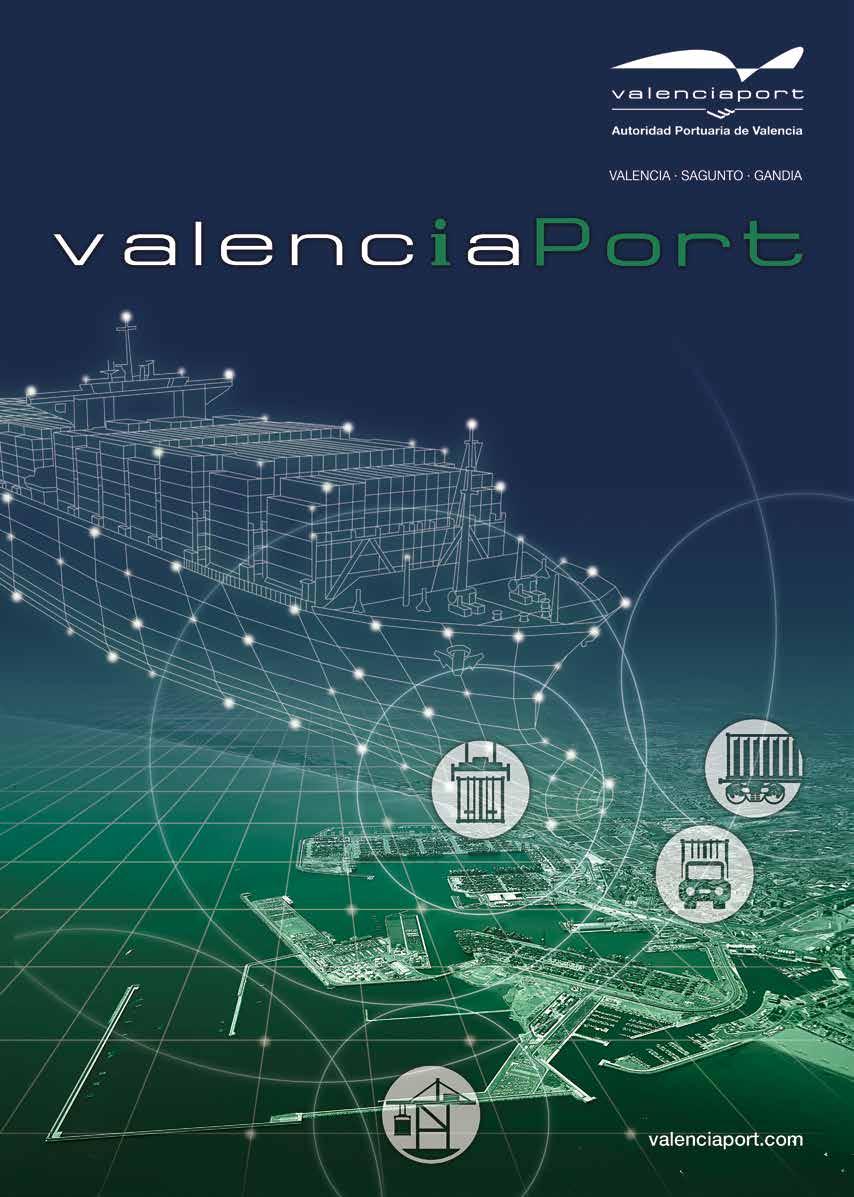
ICTSI CONCESSION BRINGS TRANSFORMATION TO ILOILO PORT…
International Container Terminal Services Inc. (ICTSI), reports the award of a new concession in the Philippines and commencement of works on the upgrade of its Rio Brasil Terminal in Brazil.
The Philippine Ports Authority (PPA) has awarded ICTSI a new 25-year concession contract to develop and operate the Commercial Port Complex (ICPC) in Western Visayas. This decision represents a significant step forward in transforming ICPC into a modern and efficient gateway for the region.
Visayas Container Terminal (VCT), the future name of the facility after handover to ICTSI – is a critical gateway for trade in the Western Visayas. However, capacity efficiency constraints have hampered its full potential. ICTSI’s involvement aims to tackle these challenges head-on, unlocking the port’s economic potential.
VCT has 627m of operational quay and 20ha of land for container and general cargo storage, warehousing, and other cargo-handling activities. Upon signing of the contract, ICTSI will focus on improving terminal productivity and service quality
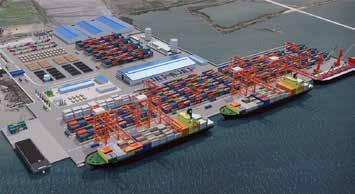
by investing in the development and rehabilitation of the terminal infrastructure and the deployment of modern cargohandling equipment.
Former Senator Franklin Drilon, a native of Iloilo, and long-term supporter of the port, outlined the importance of this decision: “With its impressive track record, ICTSI is well-positioned to efficiently manage the ports and address the longstanding congestion issues plaguing our ports, which have deterred potential investors.
The decision to partner with ICTSI is a significant step forward in transforming VCT into a modern, world-class port facility and accommodating more domestic and international shipments. This
will position Iloilo as a key driver of economic progress in the Philippines.”
Christian R. Gonzalez, Executive Vice President, ICTSI, notes: “We are elated and grateful to be entrusted with the redevelopment of the Iloilo Port. We recognise the port’s pivotal role in driving Iloilo’s economic and social growth. Our comprehensive proposal outlines significant investments in infrastructure upgrades, cargo-handling equipment, and operational efficiency measures, all aimed at transforming the Iloilo Port into a premier gateway.”
…AND UPGRADES RIO BRASIL TERMINAL
Also on ICTSI’s agenda, is the upgrade of its Rio Brasil Terminal spanning major structural modernisation and expansion works.
The expansion works involve a
Gantrex buys Liftcom
Gantrex Group, a company supported by Argos Wityu, has acquired Liftcom, as it continues to grow and expand its Port Crane Services (PCS) capabilities. Integrating Liftcom will reinforce the competitive position of Gantrex in the Dutch market and within Rotterdam, a port with over 100 ship-to-shore cranes and 300-yard machines spread over multiple terminals. This latest deal is expected to double turnover by 2026.
new methodology that uses moveable metal panels that are fabricated on site and a state-ofthe-art geo-positioning system (GNSS) for landing the foundation piles. On average, each section of
Port Auctions Coming
The National Water Transportation Agency (ANTAQ) in Brazil is planning to hold 19 port auctions in 2024, which is expected to generate approximately R$11.7bn in investments. Eduardo Nery, Director, ANTAQ, says that the initiatives include 16 concessions developed by the federal government (R$8.2bn in value) and three projects in Paranaguá, Paraná, where administration is decentralised, (expected to raise R$3.5bn in investments).
a planned new quay involves use of 380m3 of concrete. A total of 12 phases of development space are due to be created during Q1 2024 and once completed there will be an additional 6000m2 of new dock.
JAXPORT Deal Done
South-eastern US-based JAXPORT has approved a 30-year agreement with US marine terminal and logistics company Enstructure for the lease and development of 79-acres of waterfront land at the port’s Talleyrand Marine Terminal. Enstructure will develop a mixed-use facility from late 2025 when incumbent tenant, Southeast Toyota Distributors, relocates to the Blount Island Marine Terminal.
Port of Valencia Tenders Third Rail Line
The Port Authority of Valencia (PAV) is tendering to double track and construct a third railway line connecting the Poniente and Levante terminal facilities in the Port of Valencia. The tender has been confirmed for an amount of €12 million ($13 million), with a completion period of 18 months.
Once operational, the new line will allow the access of 750m-long freight trains to the Levante Railway Terminal on double mixed track and eliminate the singletrack section existing at present.
This expansion project aims to provide improved access to the APM Terminal’s container terminal while also accommodating more trains inside the port, facilitating convoys to the upcoming rail highway and also accessing Valencia Terminal Europa (VTE). .
This development is part of Valenciaport’s railway strategy, which is encouraging greater use of railroads, and which has seen train-handling cargo rise in recent years. Currently a total of eight per cent of all freight enters/ leaves Valencia’s port network via rail.
In another new development, the port of Valencia and Valencia Terminal Europa have signed an agreement governing the construction, operation, and maintenance of a new photovoltaic infrastructure.
BRIEFS
RNLI Marks 200
A 200-year photo history of the Royal National Lifeboat Institution (RNLI), timed for the RNLI’s 200th anniversary on March 4, 2024 is being released. The commemorative publication, 200 Years of Lifesaving at Sea is noted as offering “over 100 fascinating images….. to the brave folk who sailed and continue to sail towards danger, rather than away from it.” To date the RNLI has saved over 144,000 lives.
For the latest news and analysis go to www.portstrategy.com JANUARY/FEBRUARY 2024 | 7 PORT & TERMINAL NEWS
8 Artist’s rendition of ICTSI’s vision for the Visayas Container Terminal
Any colour, but always green.
Electric RTGs, available with busbar or cable reeling drum and hybrid machines with Liduro energy management are ideal for reducing your carbon footprint.
www.liebherr.com
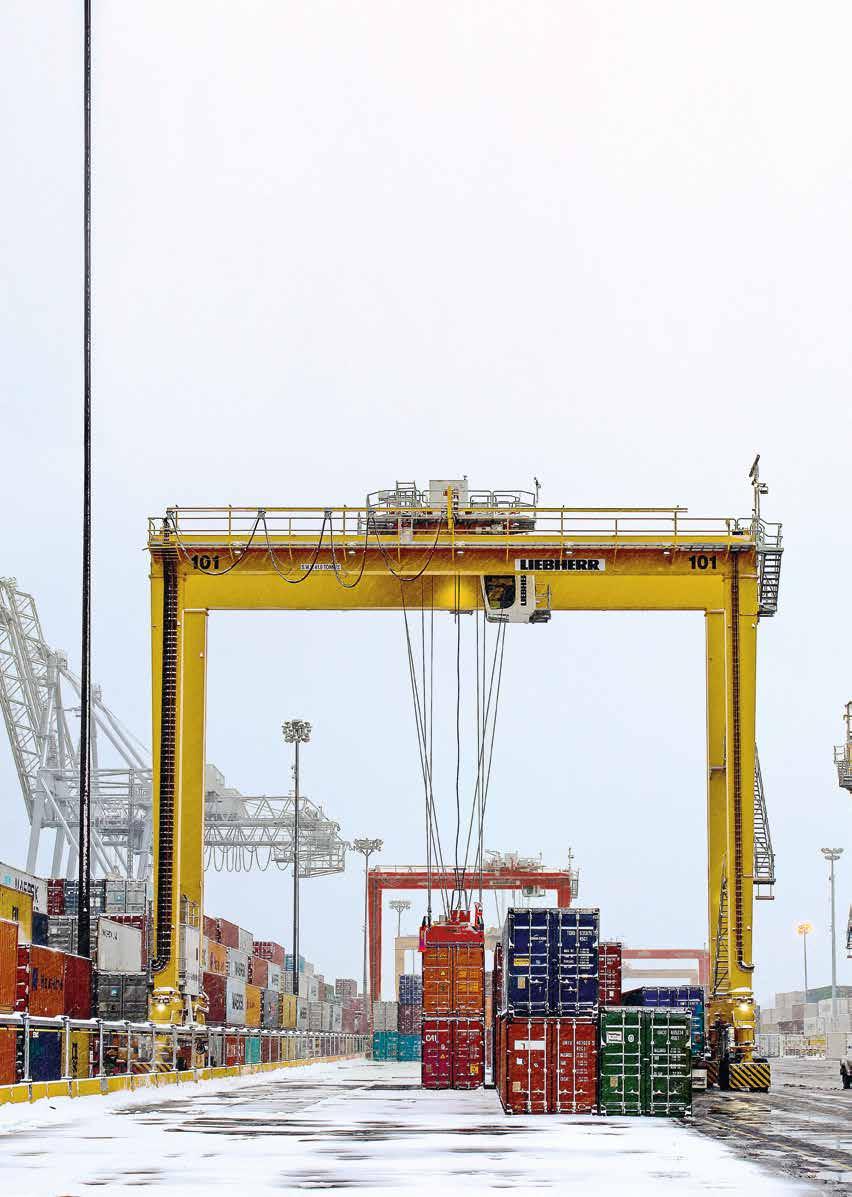 Liebherr Container Cranes Ltd.
Liebherr Container Cranes Ltd.

RIGHTSHIP SECURES TWO NEW PROJECTS
Leading environmental, social and governance (ESG) focused digital maritime platform specialist, RightShip, has confirmed two new port deals. The first is for Itaguai, Brazil, with the second deal for Napier Port, New Zealand.
The new partnership with Port of Sudeste, located in Itaguai, Rio de Janeiro, will see the port start utilising RightShip’s Maritime Emissions Portal (MEP), in what represents a first for the Latin American region.
MEP is a unique digital solution that combines AIS vessel movement data with RightShip’s vessel insights. Its primary objective is to calculate ships’ emissions and identify areas of opportunity to reduce environmental impact. MEP, according to Rightship, provides crucial support and access to unparalleled maritime datasets. This helps ports and terminals to effectively measure and manage their emissions, thereby supporting decarbonisation strategies that align with global, regional, and national targets.
Port of Sudeste recently announced aims to reduce its scope one and two GHG emissions from operations by 50.4 per cent by 2033 compared to the base year 2021. With scope three emissions representing one of the main challenges for the ports and terminals sector in reaching net zero, the addition of MEP now provides Porto Sudeste with a tool to monitor and reduce these three emissions as part of its broader
8 Yilport’s Puerto Bolivar terminal in Ecuador has received four new ship-to-shore gantry cranes and one additional rubber-tyred-gantry (RTG) unit (taking the terminal’s total to 18 RTGs overall), which boosts capacity to around one million TEU per annum. The new STS cranes are supporting the Phase II expansion project, which is increasing the berth length to 1410m, of which 780m is for dedicated container activities. Operations are due to commence before the end of Q1 2024. Yilport has previously reported that its total investment in its Puerto Bolivar terminal will be in the order of US$750 million. US$150 million of this investment is being provided by way of a loan from the US International Development Finance Corporation.
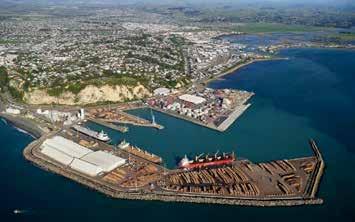
decarbonisation strategy.
MEP employs an energybased modelling approach linked to UNEP and UNFCCC guidelines to calculate vessel-based emissions. Emissions are calculated in four separate operational modes across defined points of interest specified by the Port of Sudeste, making this platform a genuinely tailor-made solution for every port.
In operation since 2015, Porto Sudeste is a key Brazilian mining development. Through the port, the iron ore produced in Brazil reaches markets throughout Southeast Asia. This terminal is designed to load solid bulk iron ore, of which it can handle up to 50 million tons per year. The port is controlled by two international companies: Mubadala, a global investment company in various segments of the economy, and Trafigura, a leading multinational in the oil, metals, and mineral trade
Similarly, RightShip has
announced that it has signed a deal whereby New Zealand’s Napier Port will implement the company’s innovative RightPort risk solution. This agreement will make Napier the first port in the region to adopt this technology, which aims to enhance maritime safety and sustainability.
RightPort is a transformative digital solution that screens inbound vessels against risk-based criteria tailored to a port’s requirements. It enables ports and terminals to streamline their pre-arrival processes, reduce administrative workload, and improve communication with vessels. RightPort also connects users to a global network of ports, allowing them to access feedback reports and vessel insights from other ports and terminals.

BRIEFS
SC Ports Looks Deep
The South Carolina Ports Authority plans to deepen the ship channel leading to its North Charleston terminal to 52ft as part of its plans to expand capacity from 500,000 TEU per annum to 2.5 million TEU within the next 10 years. A request has been made to the US Army Corps of Engineers to begin a feasibility study for dredging the channel by an additional five feet.
BEST Deal for MSC
Reports in Spain are indicating that Mediterranean Shipping Co (MSC) is acquiring a 50 per cent stake in the BEST container facility in Barcelona, currently operated under longterm concession from Hutchison Ports. APM Terminals (APMT) is an operator in Barcelona, but the forthcoming end of the 2M Alliance between MSC and Maersk Line may have prompted MSC to seek alternate terminal options at the port for its own vessels. BEST is currently expanding to 3.34 million TEU capacity per annum.
Ceres Rebrand
Seattle-headquartered Carrix has announced that its recent acquisition, Ceres Terminals, is being rebranded as SSA Marine. Carrix completed the acquisition of the Ceres Terminals portfolio, consisting of operations in 18 locations, at the end of Q3 2023, for an undisclosed amount and cited the appeal of further entry into markets in the US Gulf and Atlantic as a key rationale for the deal.
ESPO Approval
The European Parliament has offi cially adopted the Berendsen report, a path to port reform – see p23.
For the latest news and analysis go to www.portstrategy.com JANUARY/FEBRUARY 2024 | 9 PORT & TERMINAL NEWS
8 Napier Port in New Zealand is the second port, after Port of Sudeste, in Itaguai, Brazil, that has recently signed a new deal with RightShip of Singapore for ESG focused digital maritime platform support

Protect Lives and Equipment
Minimize the risk of downtime and damages with Fogmaker’s fire suppression system!
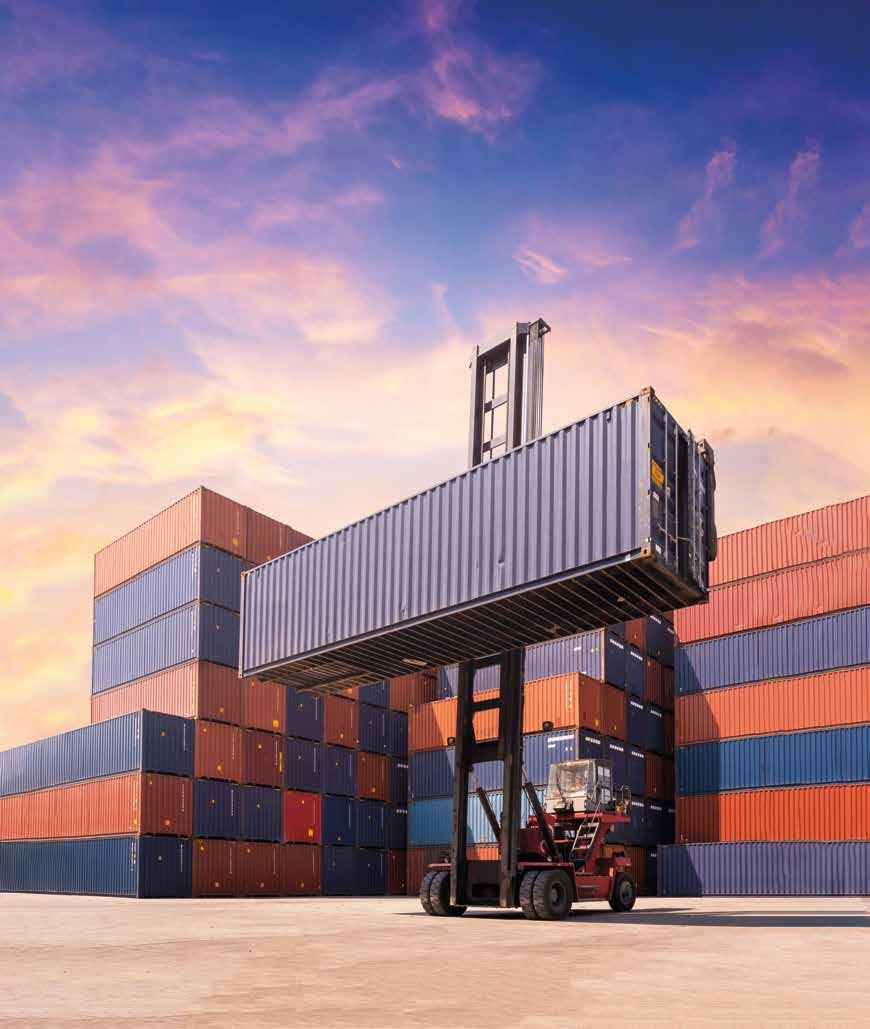


The Fogmaker fire suppression system is tailormade for each type of material handling equipment.
High-pressure water-based mist chokes fires quickly and cools the area to prevent reignition. Fogmaker’s system is automatic, independent of electricity, and always ready!
www.fogmaker.com
Future!
PFAS-Free for the

DURRES POWERS AHEAD
Durres Container Terminal, at the Port of Durres, Albania, is capturing major new cargo volume which is being facilitated by ongoing terminal system enhancements.
Based on available information provided by the Durrës Port Authority (APD), a total of 184,017 TEU were handled in 2023, representing an increase of 38 per cent over the total recorded for 2022.
The trade itself was also balanced, with 92,100 TEU confirmed as import activity, with exports reaching 91,917 TEU. Indeed, it is export demand that has been a significant driver of this growth, with an additional 51,052 TEU exiting the terminal in 2023 compared to the same 12-month period of 2022.
It is also clear that investment in new and improved systems and improved terminal performance by the terminal’s
8 Liebherr Container Cranes ltd is supplying the new APMT Rijeka Gateway terminal with 15 electric rubber tyred gantry cranes (ERTGs) and two rail mounted gantry cranes (RMG), all of which, according to Liebherr, utilise the latest advancements in technology, allowing for seamless remote operation and control. Liebherr’s ERTGs are powered by electric busbar technology with drivein auto-connect functionality, with a mobile lithium-ion battery that helps ensure emission free operations. All the equipment uses the Liebherr Remote Operator Stations (ROS), enabling crane control from a convenient office setting, which improves safety and productivity but enables a future transition to a fully automated operation.

management company, Mariner Adriatic (part of Hili Company) is paying an important role in this uptick.
Mariner Adriatic highlights the implementation of the Navis N4Saas terminal operating system, Navis’s cloud-based solution, as a major positive step. It also reports other terminal
efficiency measures including the installation of an automated gate system and a comprehensive upgrade to the Customer Access Portal.

Serbia Targets Greece
When opening the recent Serbia-Greece business forum, Aleksandar Vucic, President of Serbia, has confirmed Serbia’s interest in securing an equity stake of between five and 10 per cent in either the port of Piraeus or Thessaloniki. He said that the aim is to support a desired growth in Serbia’s exports, especially involving automobile production and mining. It is not known whether existing investors in these ports are in favour.
CTW Connects
Eurogate Container Terminal Wilhelmshaven (CTW) is implementing Portchain Connect to simplify berth alignment processes with shipping lines. CTW is expecting to increase the quality and speed of ships berthing through digital handshakes and secure data sharing. Portchain Connect gives the terminal a real-time schedule and move count updates directly from carrier systems to allow better overall alignment.
Salalah Increases
The Port of Salalah in Oman has received the first four of 10 new ZMPC ship-to-shore (STS) cranes from China as its container terminal modernisation and expansion project gathers momentum. A further six cranes are expected during Q2 2024, replacing four lower specification units, as part of the overall increase in annual capacity from five to six million TEU by the end of Q1 2025. Crane outreach is a mammoth 75m.
East Container Terminal, Colombo, Gears Up
Container capacity at the East Container Terminal (ECT) at the Port of Colombo, Sri Lanka, is set to get a significant boost.
The Sri Lanka Ports Authority (SLPA) has confirmed that the facility is to get three new ship-to-shore (STS) gantry cranes, which are part of an order that includes 40 Automated RailMounted Gantry (ARMG) units. The total cost for the Chinesemanufactured equipment is US$282 million, which is being met solely by SLPA.
The new STS gantry cranes have an outreach of 72m, which can reach 26 containers across a vessel, with a maximum load capacity under the spreader of 65 tonnes and up to 75 tonnes using a lifting beam. The investment is part of ECT’s expansion to 2.4m TEU capacity per annum by the end 2025.
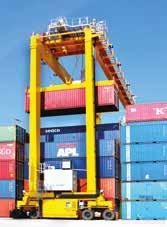
BRIEFS
Piraeus Excluded
The European Union (EU) has launched a new European Ports Alliance to combat the growing problem of drug trafficking but has excluded a major port. Piraeus was not included in the participants to launch the initiative, with this assumed to be due to its Chinese majority ownership. This new project was jointly initiated by the government of Belgium, the current (rotating) president of the EU.
For the latest news and analysis go to www.portstrategy.com JANUARY/FEBRUARY 2024 | 11 PORT & TERMINAL NEWS
8 The Mariner operated Durres Container Terminal has captured major new cargo volume facilitated by ongoing terminal system enhancements
Images
automated-rtg.jpg
Liebherr-ros-desks.jpg Liebherr Remote Operator Stations
Liebherr-
A cabinless Liebherr RTG LiebherrA busbar
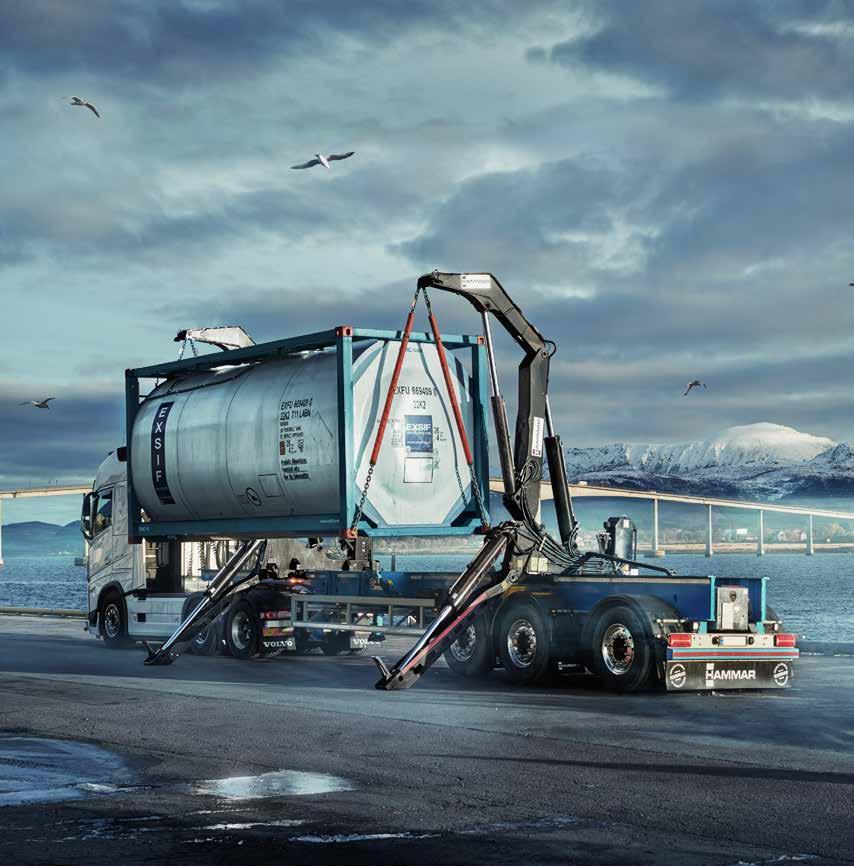
ELEVATING LOGISTICS 50 YEARS AND BEYOND
Hammar is the world leading manufacturer of Sideloaders, self-loading vehicles for containers and more. A competetive quality solution for container logistics, special transports and terminal handling.
+ Made in Sweden since 1974, delivered to more than 122 countries world-wide
+ Lift, transport and transfer up to 50 tonnes
+ Increase safety and efficiency with grounded containers
+ One vehicle, one driver, anywhere, anytime
www.hammarlift.com | info@hammarlift.com | +46 33 29 00 00 Read our anniversary brochure https://bit.ly/H50ENG

NEW GENERATION TOS INVESTMENT BY VERBRUGGE INTERNATIONAL…
Investment is proceeding apace in state-of-the-art Terminal Operating Systems, with a number of different suppliers announcing a range of interesting developments and new agreements.
In the Netherlands, logistics service provider, Verbrugge International BV, has selected specialist software solutions from Konecranes across three of its locations in the country. Booked in November 2023, the new system is being implemented at both container and non-container operations during 2024 and 2025.
Verbrugge International is requesting Konecranes to simplify its port and inland terminal operations that involve handling dry bulks, general cargo, ro-ro and project cargo, in addition to containers.
The clear aim is to see better productivity and overall improved operational efficiencies, as David Trueman, Managing Director for Konecranes’ TBA Doncaster software unit in Port Solutions explains: “Konecranes’ [CommTrac and Autostore] TOS will give
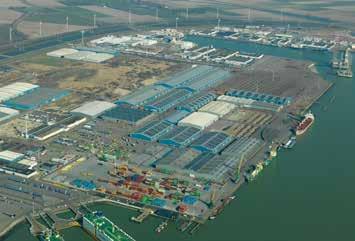
Verbrugge International true multi-cargo handling capabilities for seamless management of diverse cargo types accessible from anywhere at any time. We are pleased to have Verbrugge as our first CommTrac customer in mainland Europe following our recent successes in the US, Canada and Australia.”
This new deal will also see an integration of Konecranes’ software solutions with Verbrugge’s finance systems and real-time data sources like
8 Verbrugge International BV represents the first Benelux order for Konecranes terminal software solutions for containerised and non-containerised cargo operations
weighbridges for better data visibility flow.
As the stories adjacent and below indicate, however, Verbrugge is not alone in investing in new TOS and affiliated technology. The port of Alicante, Spain, Northport, Malaysia and terminal operator Gulftainer are all busy with investments in this sector.
….AS ALICANTE JOINS THE PARTY
The Port of Alicante (Spain) has confirmed the integration of 1MillionBot Marítimo with PACECO POSEIDONs TOS (Terminal Operating System). It is a move that the port says represents a “new chapter in the efficiency and automation of container terminals.”
CPu Take Up
According to the Port of Antwerp-Bruges, 60 per cent of daily container collections from deep-sea terminals are using the new Certified Pick up (CPu) data platform. The process integrates the activities of many areas of the port community, including ship agents, terminal operators, transportation service providers (across road, rail and barge) and Customs. The port is expecting to see additional users migrate to CPu as 2024 progresses.
1MillionBot Maritime is an advanced platform for intelligent virtual assistants and has been specifically designed to adapt to the complex needs of the port logistics environment.
The port explains that the application of artificial intelligence through 1MillionBot Marítimo has
PCS for Prodevelop
The Spanish Port Authority of Avilés has selected Prodevelop to develop and maintain a new Port Community System (PCS). The Valencia-based digital transformation solution provider will take responsibility for the implementation of PCS modules covering the areas of water and power supply, fuel supply, and other vessel service requests, using a continuous improvement model, based on the Deming cycle that guarantees efficiency and adaptability.
resulted in increases in efficiency and safety because stevedores now record their operations using only their voice, thereby ensuring that there is no diversion away from critical tasks. This project received financial support through the Ports 4.0 fund of Puertos del Estado (Spanish Port System).
FAITH in AI
The FAITH project has kicked off. The initiative is targeting the development of reliable and ethical Artificial Intelligence (AI) solutions in a range of areas, including transport. Fundación Valenciaport is a partner in the project that is being co-funded by the Horizon Europe programme of the European Climate, Infrastructure, and Environment Executive Agency (CINEA). It is scheduled to develop 14 largescale pilot programmes before it ends in January 2028.
Northport, Malaysia
At Northport, Malaysia, part of the MMC Group, the company is partnering with supply-chain execution software expert, Kaleris, to implement the Navis N4 TOS to accelerate productivity, efficiencies and improve environmental benefits.
The Navis N4 system is an integral part of a solutions application that connects operational visibility to execution workflows to deliver smarter decisions, thereby resulting in faster moves for peak performance. In terms of day-to-day operations, deployment of the new TOS is part of a turnkey solution from Kaleris and will help speed vessel turnaround and minimise container re-handling at the terminal.
Gulftainer Signs With SAP
International stevedore Gulftainer is taking a step towards its digital ambition of becoming more innovative and resilient.
Peter Richards, CEO, Gulftainer notes: “We are confident that the implementation of ‘RISE with SAP’ in our business ecosystem will propel us towards new levels of efficiency, sustainability and excellence in the supply chain and logistics sectors.” The adoption of RISE with SAP will enable greater access to machine learning and robotic process automation (RPA).
BRIEFS
Sibelco Sees Green
Klaveness Digital has agreed a new deal with industrial materials specialist, Sibelco, to integrate its CargoVale emissions tracking capabilities into the company’s supply chain management network. Introduction of this system will enable Sibelco to target improved environmental sustainability and operational efficiency in its maritime logistics, while tracking greenhouse gas (GHG) emissions from maritime transport activities.
For the latest news and analysis go to www.portstrategy.com JANUARY/FEBRUARY 2024 | 13 DIGITAL NEWS
WE ARE THE EXCLUSIVE DEALER FOR SEVERAL TRIPLE A BRANDS IN THE PORT EQUIPMENT INDUSTRY. OUR CLOSE CONNECTIONS WORK TO YOUR BENEFIT: YOU HAVE ACCESS TO SHORT SUPPLY LINES AND A WIDE RANGE OF PRODUCTS. WHETHER YOU’RE BUYING, LEASING OR RENTING, GPE OFFERS DIFFERENT FINANCING OPTIONS.
THANKS TO OUR NETWORK OF LOGISTICS EXPERTS, YOU’RE ALWAYS SURE YOUR MACHINE WILL ARRIVE PUNCTUALLY, NO MATTER WHERE IN THE WORLD YOU NEED IT.






STRATEGY Port Policy Port Sector Reform Value & Business Strategy Public Private Partnerships (National) Port Master planning Institutional & Regulatory Change Organisational Reform & Alignment VALUATION Feasibility Business Case Value Creation & Protection Financial Modelling & Analysis Project Structuring & Packaging Risk Valuation, Allocation, Mitigation TRANSACTION Financial Solutions Transaction Strategy Transaction Management Documentation & Contracts Tendering & Negotiated Solutions FINANCE Due Diligence Project Financing Financial Structuring Procurement of Finances Investment/Divestment Merger & Acquisition MTBS is the leading international in port business solutions Unlocking value in the maritime & transport industry MTBS.NL
EXCLUSIVE DEALERSHIPS BETTER TOGETHER
Hamburg port operator, Hamburger Hafen und Logistik AG (HHLA) has commenced its transition away from conventional trucker cards to full time use of a digital application.
Developed through the company’s HHLA Next innovation unit, HHLA has introduced its Passify app at Container Terminal Tollerort.
The Passify app means truck drivers undertake identification by authenticating themselves through the new app instead of using physical plastic cards.
HHLA says the new process brings a significant advantages in terms of security and data protection, but also meets all necessary criteria to be ISPS approved.
“We have already been running the first successful tests with Passify at our terminals in Hamburg since summer 2023. The first trucking companies have already been able to test the application and provide their feedback. The switch to
HHLA PASSIFY TRUCK APP IS UP AND RUNNING
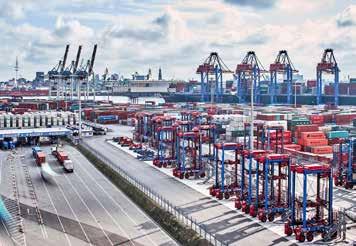
Passify that has begun at CTT will significantly increase security at our facilities in Hamburg,” explains Maren Baumgarten, who is responsible for the project at HHLA.
The Passify app is expected to be implemented at HHLA’s other
8 The transition to its new Passify app at Container Terminal Tollerort will improve efficiencies and security, according to HHLA
container terminals, Altenwerder and Burchardkai, as 2024 progresses.
CARBON MEASURING SYSTEM FROM SEA
A new Carbon Exposure solution that enables users to effectively measure and integrate their carbon exposure calculation with emissions targets has been launched.
The producer of the product is Sea, which is a technology spin-off from the Clarksons group, although it operates fully independently. The key functionalities of the Carbon Exposure solution include:
5 Voyage carbon planning: Voyages can be planned based on variables such as cargo
Harbour Lab Deal
Harbor Lab has confirmed it is collaborating with Great Eastern Shipping Co. Ltd. to optimise port cost management. The two companies said that this “pioneering” arrangement is the first time there will be an integration between a Voyage Management System (Veson) and an Accounting System (SAP). It will create efficient, seamless, end-to-end port call management processes covering from fixing to voyage end and invoice payment.
type, cargo volume, laycan, load & discharge port, ballast & laden speed, and vessel name or IMO numbers.
5 Carbon exposure intelligence: A comprehensive vessel comparison table is provided, including CII and EEOI ratings plus ballast, laden, and total CO2 emissions. Transparency in conjunction with EU ETS cost estimates is also available, alongside the Voyage EEOI, which gives the user a holistic view of the environmental impact of their voyage
APMT Haz Portal
APM Terminals (APMT) has developed a new online option to help shipping companies manage hazardous cargo documents more efficiently. Dubbed as the Hazardous Documentation Vault (HazDV), this new global tool is able to reduce the number of steps needed to execute necessary safety activity. With autocompletion and drop-down fields using standardised IMDG terminology, improvements in clarity and speed are expected.
decisions. Finally, the user will then be recommended the most environmentally friendly vessel from the comparison, in terms of CO2 emissions.
5 Carbon target tracking: The industry-first Carbon Tracker Dashboard helps users assess their expected and actual environmental performance against the company’s set targets. Intelligence and visualisation of how specific voyages contribute to emissions enables users to identify areas of improvement.
Simulator Upgrades
CM Labs has introduced key updates to its port equipment simulation training experience. The Montreal-based vendor has confirmed updates to the Reach Stacker and Empty Container Handler (ECH) packages, which include enhancing the realistic machine feel and behaviour of the machine learning experience, such as the addition of inching pedals, different camera positioning, and spreader reference lines.
PLA Upgrades Vessel Traffic Service Systems
The Port of London Authority (PLA) has confirmed it has awarded a contract to Kongsberg Norcontrol Ltd (KNC) to replace its Vessel Traffic Services (VTS) equipment.
A VTS is a key component of ensuring safety and efficiency of navigation are maintained, as well as helping to protect the environment, by ensuring operators have detailed information about traffic activity on the River Thames.
This announcement is a key part of the PLA’s Thames Vision 2050’s Marine Centre Transformation Programme that is targeting delivery of a future-proofed Port Control Centre, utilising the appropriate technology and resilience to support continued growth expectations for the cargo facilities located on the River Thames. Steven Clapperton, Director of Marine Operations, PLA, underlines: “This is a multi-million-pound scheme and will provide London VTS with state-of-the-art equipment, enhancing and improving our operational performance. It will be delivered into a brand new operations centre, ready to accommodate the expected growth of trade on the river which is forecast to rise from 55 million tonnes per year to 78 million tonnes by 2050.”
BRIEFS
PoAB Drone Update
The Port of Antwerp-Bruges’
Unmanned Aerial System Traffic Management (UTM) DronePortal is being updated by Unifly and SkeyDrone. The latest improvements include extending coverage to Bruges, plus providing optimised automated approvals, enhanced integration support with drone operations, and User Interface (UI)/User Experience (UX) enhancements. Launched in mid-2021, the drone has completed over 5000 flight authorisations.
For the latest news and analysis go to www.portstrategy.com JANUARY/FEBRUARY 2024 | 15 DIGITAL NEWS


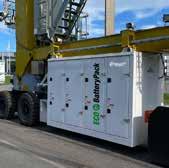




Converting a conventional RTG into an electrical one (E-RTG) means to shut down the diesel generator and to power the RTG with electrical power only – the emission saving, sustainable basis for automation. This is possible with electric power solutions, including E-RTG auto-steering and positioning systems, developed by Conductix-Wampfler: Plug-In Solution, Drive-In Solution, Hybrid Solution, Full-Battery Solution and Motor Driven Cable Reel Solution with CAP - Cable Auto Plug-In.
We move your business!
www.conductix.com
We add the “E” to your RTG Electrification of Rubber Tyred Gantries
E-RTG with Drive-In L Solution and ProfiDAT® E-RTG with Motor Driven Cable Reel Solution and CAP - Cable Auto Plug-In E-RTG with ECO BatteryPack Hybrid Solution
Kobe International Container Terminal (KICT), operated by Mitsui O.S.K. Lines, Ltd. has announced it is to trial the operation of a hydrogen-fuelled rubber tyred gantry (RTG) crane converted from a diesel engine powered unit.
Kobe-Osaka International Port Corporation claims that this cargo handling machine is the first in the world to convert a diesel engine generator to a hydrogen engine generator. The process to move from a diesel generator to hydrogen is outlined in the schematic provided by the companies involved in this project.
Partners in this project are Kobe-Osaka International Port, Shosen Koun Co., Ltd. Mitsui Engineering & Shipbuilding Co., Ltd. iLabo Co., Ltd. (hydrogen engine manufacturer), Iwatani Corporation (hydrogen supply, transport, and fuelling) and Universal Energy Laboratory Corporation (consultants).
The development of carbon
HYDROGEN POWERED RTG TRIALS IN KOBE MITSUI TERMINAL

neutral ports (CNPs) is high on the agenda in Japan, with the aim of upgrading different
port functions to gain the benefits of decarbonisation via seeking to improve the
KALMAR DEMERGER RATIONALE EXPLAINED…
Kalmar separating from Cargotec could unlock shareholder value by allowing both companies to independently pursue sustainable and profitable growth opportunities. That is the clear message being put forward by the Cargotec board of directors.
As a result of this process, two listed companies are being created:
5 Kalmar - a technology forerunner in container handling and heavy logistics with strong market positions, geared to grow by making the industry electrified and more sustainable.
Big SLPA Spend
The Sri Lanka Ports Authority (SLPA) is receiving 12 new Ship-to-Shore (STS) gantry cranes and 40 Automated Rail-Mounted Gantry (ARMG) cranes. All equipment is being supplied directly from Chinese manufacturers and represents total spending of US$282 million by SLPA. The STS units can handle 26 containers across a ship and a maximum load capacity under the spreader of 65 tonnes.
5 Hiab - an industry pioneer in on-road load handling with a strong track record of profitable growth and attractive M&A potential.
Jaakko Eskola, Chair of the Board, Cargotec, provides further insight
into the rationale: “The planning and evaluation of the demerger has progressed well. The Board of Directors with the support of certain major shareholders, has after careful consideration decided to propose the separation
….AS NEW ORDERS ROLL IN
Kalmar has confirmed a new deal to supply Star Container Services B.V. with 12 Kalmar empty container handlers, which are scheduled to be deployed at the Rotterdam Maasvlakte terminal..
Smiths Joins METEOR
Threat detection and screening technology specialists, Smiths Detection, is to participate in an EU Horizon programme (METEOR) that is developing portable screening technology for cross-border containers. The METEOR initiative is planning to deliver a vapour based portable scanner for the non-intrusive inspection of large-volume shipments, including containers. The new technology will automatically provide fast and high-quality detection.
The company has also announced it is supplying four Kalmar reach stackers, two Kalmar empty container handlers, eight Kalmar Essential terminal tractors and the Kalmar Insight performance
PTP is Electric
Port of Tanjung Pelepas (PTP) is to acquire 48 electric rubber-tyred gantries (RTGs) from Mitsui E&S Co. Ltd. PTP, a JV between the MMC Group and APM Terminals, confirms the new e-RTG cranes are part of an equipment modernisation strategy, with delivery expected by Q3 2025. The port is aiming to reduce its emissions by 45 per cent by 2030. Currently, 85 per cent of its existing RTG fleet is already electrified.
environment through adoption of hydrogen and other clean fuel alternatives.
of Kalmar from Cargotec by means of partial demerger to increase shareholder value.”
The Demerger is subject to approval by the annual general meeting of Cargotec being held on May 30, 2024. This will then lead to a planned completion date of June 30, 2024.
management tool to longstanding Brazilian partner Super Terminais, for operations in Manaus in northern Brazil. Delivery is expected during Q3 2024.
BRIEFS
BlueBARGE is Go
The BlueBARGE project is go and with a clear focus on the design and development of an energy barge that will support anchored ships with renewable generated electricity. A key innovation of BlueBARGE is the introduction of a hybrid concept that will combine the higher energy density of lithium (Li-ion) batteries with the innovative vanadium redox flow battery (VRFB) solution, which introduces increased safety and service life.
For the latest news and analysis go to www.portstrategy.com JANUARY/FEBRUARY 2024 | 17 EQUIPMENT NEWS
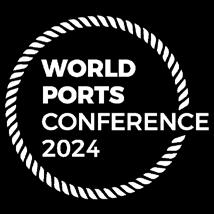

8 – 10 October 2024
Hamburg, Germany
REGISTRATION NOW OPEN
Managing risk - building resilience - unlocking opportunities 2024 will be a pivotal year for ports and their communities. Geopolitical instability is on the rise. Physical and digital security is under threat, at sea and on shore.
Shipowners, supply chain providers and cargo owners must adapt rapidly. The energy transition towards low- and zero-carbon fuels must be balanced against national energy security concerns.
#IAPH2024 will offer attendees insights on these topics, revealing how ports – from developing and developed nations – are building secure and sustainable solutions to these shared challenges, in a deeply interconnected world. ©
Silver sponsor: Bronze sponsors:
For more information on attending, sponsoring or speaking contact the events team:
visit: worldportsconference.com contact: +44 1329 825335 or email: wpc@mercatormedia.com
#IAPH2024
Copyright of Hamburg Port Authority, Andreas Schmitd-Wiethoff
Host sponsor:

NEW BRAND IDENTITY AND AMBITIONS FOR KONECRANES AND…
Konecranes has released a new brand identity as it targets becoming a “world leader in material handling solutions.”
This news comes on the back of an updated strategy, new ambitions and financial targets, linked to revised values identified after gaining the input of thousands of employees on a global basis.
These are all noble sentiments, but what do they actually mean? Well, the company appears keen to affirm its critical role in the handling of materials and goods
essential for people, while preserving resources and reducing emissions.
Anders Svensson, President and CEO, Konecranes, explains: “Our new brand promise, “Konecranes moves what matters,” summarises the significant impact we are making together with our customers and other stakeholders. We truly are shaping next-generation material handling solutions for a smarter, safer and better world.”
“Moves what matters” replaces Konecranes’ previous brand
promise, “Lifting Businesses,” which was first introduced in 2006. The company logo and “C” symbol remain, but with an updated meaning to describe its broadened role in global material handling.
“Be it the fruit on your table, the tissue paper in your house or the steel in your office building, chances are we have had a role in moving it safely, reliably and sustainably. We move what is needed where it matters most, and drive change in our industry,” Svensson confirms.
…MAJOR ORDER FOR ELDORADO BRASIL
Konecranes has confirmed successful completion of a largescale order for Eldorado Brasil’s new cellulose terminal in the Port of Santos, Brazil, with the provision of two gantry cranes and seven fork lift units. The project also included joint planning and consulting on terminal layout.
Eldorado Brasil’s new terminal in Santos is designed to process three million tons of pulp bales per annum. This equates to around 8300 tons daily, arriving to the facility by rail and truck with around 90 per cent of the cargo subsequently being exported to 45 different countries.
The seven Konecranes SMV 16-1200 C 16-ton forklifts use a special clamp designed to lift pulp bales without pallets and have several safety enhancement features including shock absorbers and safety lights and cameras. Special sensors optimise oil usage and reduce waste.
The two Konecranes gantry cranes are tailor-made with a

customised open winch, a spreader clamp for pulp bales and the option to attach a container spreader when needed. A variety of Smart Features ensure smooth and accurate movement, and braking energy is recycled. Radio controls and a Remote Operating Station (ROS) allow full crane control with maximum operator safety.
Konecranes is also providing Eldorado Brasil with TRUCONNECT ® Remote
8 Eldorado Brasil’s cellulose terminal offers a state-of-the-art digital ecosystem that brings the highest levels of efficiency and safety to lifting in the pulp and paper industry through new equipment, including a fl eet of Konecranes SMV 16-1200 C 16-ton forklifts
Monitoring, which collects near real-time diagnostics to optimize the performance, maintenance, and eco-efficiency of all the equipment. This data is available 24/7 through the online customer portal yourKONECRANES.
BEDESCHI CONFIRMS COAL TRANSSHIPMENT HANDLING SYSTEM FOR INDONESIA
Bedeschi S.p.a. has finalised a new contract for a coal transshipment system to be delivered to Indonesia.
The project scope includes two receiving hoppers with associated belt feeder extractors, one coal blending mixer, belt conveyors
and one slewing luffing telescopic ship-loader.
The system is controlled by multiple leveling sensors to monitor the quantity of coal in the hoppers and optimise the blending performances. The tailor-made equipment will be
constructed in the Guangdong district in China before subsequent delivery to Indonesia. Bedeschi is a Padova, Italy-headquartered specialist supplier of bulk handling and other systems majoring on turn-key solutions.
BRIEFS
Huisman ASCs
Netherlands-based Huisman has secured an order from Hutchison Ports ECT Rotterdam (ECT) for a series of Automated Stacking Cranes (ASCs). The new units will be welded and pre-assembled in the Czech Republic, before final assembly at its second European facility at Schiedam, in the Netherlands. Commissioning and testing will take place at the ECT Delta terminal.
Targeting Asia
Hyster-Yale Group has announced a strategic partnership with PortxGroup for exclusive distribution for Hyster® products in several important Asian countries. As a result, logistics solutions provider, PortxGroup, will be the sole Hyster dealer serving port facilities in Thailand, Malaysia, Indonesia, and South Korea.
Taylor Acquires Ferrari
Mississippi-based Taylor Group has acquired 85 per cent of the shares in CVS Ferrari. Founded in 1973, CVS manufactures mobile container handling and heavy cargo handling equipment comprising reach stackers and highcapacity forklifts. The shares are being acquired from investment company, NEIP III, and BP (formerly Battioni & Pagani).
Deeper Burgas
Cosmos Van Oord, a joint venture of Cosmos Shipping and Van Oord, has been awarded a dredging project to support the construction of a new deep-water berth at terminal BurgasWest, at the Port of Burgas. Dredging of the port area will be completed in 2024 and to a depth of 15.5m.
For the latest news and analysis go to www.portstrategy.com JANUARY/FEBRUARY 2024 | 19 EQUIPMENT NEWS
Sustainability without compromise
As part of our Konecranes ecolifting solutions, Konecranes Flow Drive brings concrete benefits to your everyday operations and maintains high overall productivity. It cuts down fuel consumption by up to 40% (customer proved) and it enhances the driver experience, increasing active operation time.
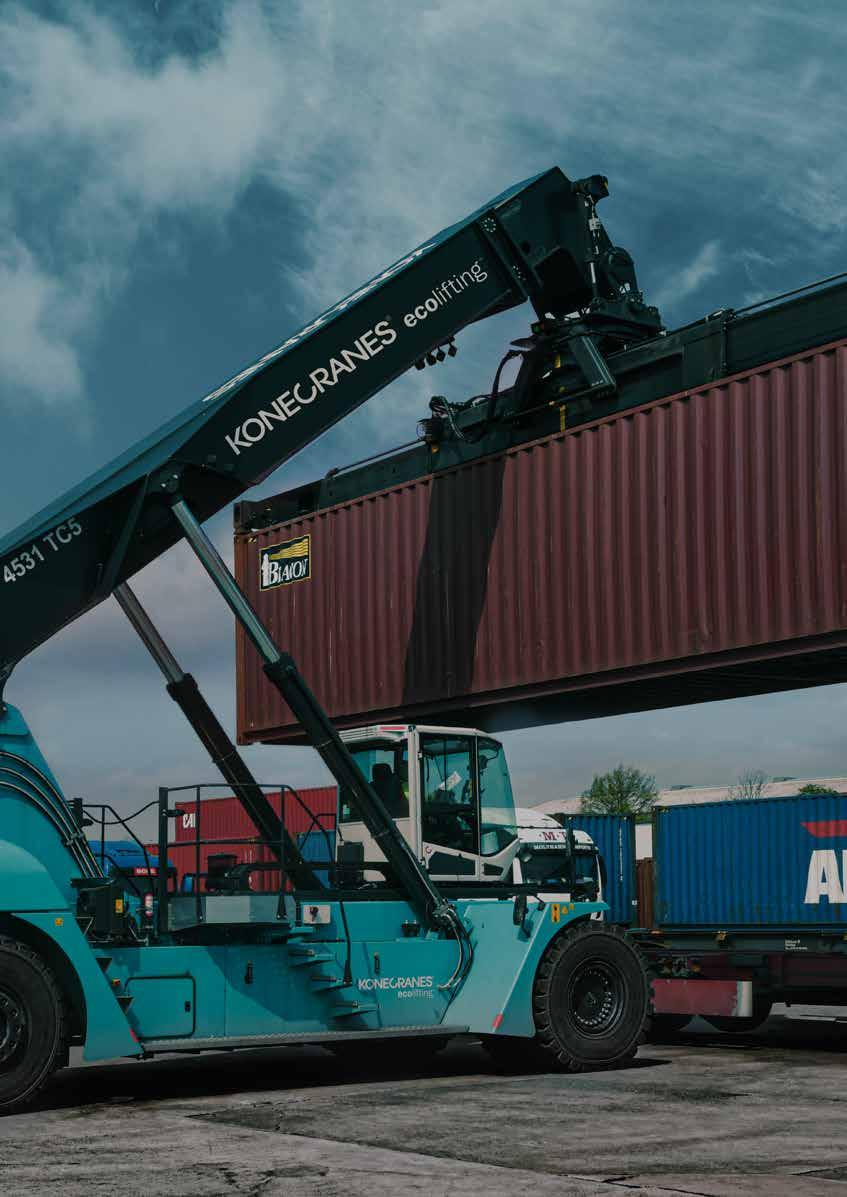
Dynamic at low speed, yet full power at high speed, with reduced wear and noise, it increases productivity with greater intervals between refuelling and combines full performance with ease of reach stacker driving.
www.kclifttrucks.com/ecolifting


THENEWYORKER
BARRY PARKER
In a slight re-wording of a popular aphorism, I can say with certainty that “We live in unpredictable times.” One need only watch the news about the hostilities in the Red Sea, the prices on the widely quoted container freight indices ratcheting upwards, and the multi-colored maps showing vessel diversions to understand why a new “supply chain crisis” might be looming on the horizon. Many port planners are implementing measures from exercises in “lessons learned” going back to 2021, with follow-ups into 2022.
As the trade flows are set to shift again (so it seems at the time of writing- three weeks into the New Year), it’s best to be prepared. There’s more going on than just planning for lengthier voyages. In watching the numerous webinars, You Tube broadcasts, podcasts and conference calls from logistics providers and analysts, I am sensing that potential solutions for cargo shippers

RED SEA TRIGGER TO INTERMODAL TRANSFERS?

involve routings that might necessitate intermodal transfers.
With flows from Asia to Europe the most impacted by the lengthier (and more expensive, if the indices reflect reality) voyages around Africa, some logisticians are contemplating routings across the Pacific, then overland by surface mode, and then back on vessels going trans-Atlantic into Europe. Variations on this, for higher valued items, include an airfreight leg into the States and then an ocean move across the
THEANALYST
PETER DE LANGEN
X-Press Feeders has recently decided to deploy green methanol-powered ships on its feeder network in Europe, with Evergreen committing to using X-Press Feeders services. The ships will operate out of and receive methanol in Rotterdam and serve feeder markets in Scandinavia - with plans to expand the green feeder services to other destinations in Europe once new methanol powered vessels are delivered to X-press. This decision is a first in container shipping and shows the traction of reducing the footprint of container shipping. A few aspects of the decision deserve attention.
First, the fact that the ships will be deployed serving Scandinavia & the Baltic, demonstrates again
Likewise, the “lessons learned” from the pandemic years certainly include encouraging port stakeholders to be nimbler in supporting intermodal transfers. If the hostilities and vessel diversions continue (again- at time of writing, the political and military “experts” on TV don’t see a cessation right away), and cargo interests take the suggestions of the logistics pundits to heart, then handoff s between modes could feature more prominently.
Atlantic. These may be stopgap measures; it’s impossible to predict the course of the Gaza war; a longer war could make such routings longer lasting.
The planners reading this have been there before; the need for ports to deal with surges in activity generally became apparent over the past few years. By the way, planners already knew this but 2021 and 2022 provided a jolting reminder.
Most of the initial attention throughout the marketplace (and here in this article) has been on containerised cargo flows, but movements of refined petroleum products and some petrochemical trade flows may also be impacted; shifting around to meet new realities.
Though I am hoping that the “experts” are wrong- and that the shooting stops, being prepared for changes in cargo moves is never a bad thing.
FUEL TRANSITION CREATES A ‘WHOLE NEW SPACE TO OCCUPY’

that this region is the center of gravity of clean fuel initiatives, probably because of a mix of policies and the presence of innovative companies and cargo owners willing to pay for green shipping.
Second, while one could have thought that green feeders most likely would be first deployed by the large shipping lines with dedicated feeder vessels, that has
8
not been the case. That is surprising since common feeder companies do not have direct contracts with beneficial cargo owners. X-Press feeders provides some information that suggests that the additional costs of using the green fuel between Rotterdam and the Baltic are around 100 euro per container,
while the CO2 emissions are reduced with about 268kg per container. How that bill is split between X-Press feeders, Evergreen, beneficial cargo owners and potentially others is not disclosed.
Finally, the move involves X-Press and Evergreen as first movers, but also OCI Global, that will provide the green methanol, as well as Rotterdam as a port. The fuel transition created a whole new ‘opportunity space’ for companies and ports to occupy. OCI Global, as a relative newcomer has managed to develop a strong position as fuel supplier, while Rotterdam, as an established bunker port has managed to transition ahead of others as a bunker port for green fuels.
For the latest news and analysis go to www.portstrategy.com JANUARY/FEBRUARY 2024 | 21
8 The Galaxy Leader seized by Iranian-backed Houthis
Green feeders are coming
Hosted by:
Book now and save 15%
The short sea shipping and sustainable logistics network
2024 Programme and Topics
Short Sea Shipping - how the market is adapting Advancing supply chain resilience with modal shift Smart operations - Digitalisation, Automation, & Innovation
Ports - Enabling the Energy Transition


Delegate place includes 2-day conference attendance including lunch & refreshments
Technical Visit
Electronic documentation
Conference Dinner (Premium Package) Presentation download (Premium Package)
• Green corridors - collaboration to drive sustainable growth
Sponsors:
Supporters:

Gold Sponsor


Coastlink is a neutral pan-European network dedicated to the promotion of short sea shipping and intermodal transport networks. Learn from and network with international attendees representing shipping lines, ports, logistics companies, terminal operators, cargo handlers, and freight organisations.
For more information on attending, sponsoring or speaking contact the events team: visit: coastlink.co.uk contact: +44 1329 825335 or email: info@coastlink.co.uk
#Coastlink
Media partners: GREENPORT




INSIGHT FOR PORT EXECUTIVES MOTOR
MARINE TECHNOLOGY THE
SHIP
APRIL
24 25 TO
Port of Amsterdam 2024 The Netherlands



BEN HACKETT THEECONOMIST
STORM IN A TEACUP
The war in the Middle East has brought knee jerk reactions to the dangers to ships using the Red Sea, primarily bound for the Suez Canal. Is it really such a disaster?
The Houthi attacks on shipping traversing the Bab-el-Mandeb straight at the southern end of the Red Sea are being treated as a major crisis for shipping and beneficial cargo owners much in the same way that acts of piracy off the coasts of Somalia, West Africa and Indonesia were perceived in the early stages.
Shipowners, be they container, dry bulk or tanker, will always assess the risks and costs and quickly find an alternative route for destinations in Europe and the North American East Coast. The first, and quickest to react by abandoning the Suez Canal option or the Egyptian SUMED oil pipeline, were the container carriers, with an estimated 80 plus per cent opting for the Cape


of Good Hope (COGH) route, followed by the bulk carriers and most recently by the oil companies. It is all a matter of transit time, vessel supply and logistics management.
As ship owners were faced with the additional fuel cost of the COGH and loss of time they added additional capacity and extra speed to ensure that after a couple of weeks the logistics
THESTRATEGIST
MIKE MUNDY
Mid-January saw the European Sea Ports Organisation (ESPO) welcome the European Parliament’s recognition of and support for the vital role Europe’s ports play in the European economy and society. This followed the European Parliament officially adopting the Berendsen report which aims to provide the foundation stones for “building a comprehensive European Port Strategy.”
ESPO further noted that in its view, “The voted text demonstrates a good understanding of the challenges ports are facing and the high investment needs ports have to be able to play the more comprehensive and critical role they have nowadays.”
It adds: “On top of being the Union’s gateways to the world,
diversions (and clearly ‘then some’) just as freight rates had fallen to a low.
8 Some ports will benefit from the new Red Sea induced supply chain arrangements
supply chain would return to normal without the Suez passage. Fortunately (if that is the right word) with the global economy to a significant extent flat lining spare capacity has been readily available to reactivate. Ship operating companies were quick to pass on the costs of the
This then raises the question as to who suffers? Clearly not the carriers other than in the initial act of reaching the decision to divert and to find additional capacity in order to ensure that fixed day services continue for container services. Cargo owners are losers as freight rates rocketed (no pun intended). The Suez Canal Authority is another loser, having reportedly lost over 40 per cent of its revenue so far and this will increase as diversions continue. The SUMED pipeline is another loser.
Ports on the other hand will likely see additional income as more vessels are introduced to the Asia-Europe services. Industry and retailers will have to dig into their inventories for a couple of weeks until the new service networks are fully functional.
ESPO UNDERLINES “THERE IS NO TIME TO LOSE” IN IMPLEMENTATION OF NEW STRATEGY
logistic nodes and industrial clusters, Europe’s ports are hubs of energy.” And that: “As has been demonstrated over the last two years, ports play a critical role in ensuring Europe’s energy security and are at the same time facilitators and even accelerators of the energy transition. Ports,” ESPO underlines, “need large public and private investments to take on all these responsibilities and to continue to develop.”
Citing two building blocks of the new European Port Strategy ESPO highlights the merit in the proposal to review the current Foreign Direct Investment Regulation and the focus on putting the competitiveness of Europe’s ports to the forefront.
In the former context, ESPO argues that the review should, “oblige all EU Member States to
implement a foreign direct investment screening system and carry out screenings in a more harmonised manner. This,” it further emphasises, “must enhance the necessary level playing field within Europe and contribute to more legal certainty for potential investors aiming to invest in European ports.” Generally, ESPO welcomes that the report “underlines the importance of a more stable investment climate.”
A key element of boosting competitiveness is seen by ESPO as Parliament’s acknowledgment and call for support for the role of ports in energy transition and in particular developing hydrogen infrastructure in ports and speeding up permitting procedures. Equally, Parliament’s
call to avoid carbon and business leakage, avoid excessive administrative burden, boost hinterland connections and the call to provide dedicated port envelopes under the Connecting Europe Facility are seen as a beneficial outcome.
Overall, the review and downstream reform of the European ports industry as viewed by the European Parliament gets a positive vote from ESPO. It does, however, additionally make the important point that as well as generating new legislation it is important that this is implemented in a timely way just as it is important in conjunction with past relevant legislative measures where today there remains room for improvement. “There is no time to lose,” stresses ESPO.
For the latest news and analysis go to www.portstrategy.com JANUARY/FEBRUARY 2024 | 23
DON’T OVERPLAY THE ISSUES!
Non-specialist headline news sources have gone overboard on the impact of the Houthi-led Red Sea crisis. Andrew Penfold takes a penetrating look at the cost impacts and other factors that will shape the outcome of any long-term loss of this routeing
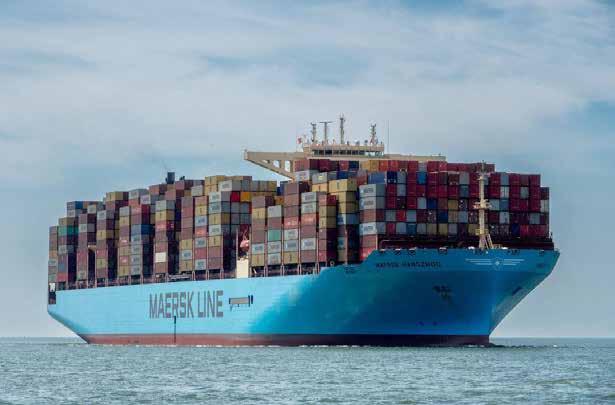
Much has been made of the inflationary impact of closing the Red Sea for container and bulk transit. In reality the impact of such a long-term closure will be quite limited – although the reorganising needed will certainly have a widely disruptive impact. We should be very careful about simply accepting that such developments would push up inflation significantly and push the OECD – especially Europe – into renewed recession. This kind of background noise is very useful for retailers in their permanent quest to raise prices and improve their bottom lines.
CONTAINER COST IMPACT
Table A summarises the actual price/cost impact on a typical consumer goods shipment from Shanghai to Rotterdam – in this case a 40-foot container with a cargo of training shoes. In the middle of last year, the headline westbound rate was placed at around US$1800. The immediate impact of diversion away from the Red Sea and via the Cape was to increase freight rates to around US$3800 – certainly a very sharp increase.
However, let’s look at the actual impact on retail pricing for a pair of trainers. If a 40-foot container can load around 6500 pairs of shoes, then the actual impact of freight charges per pair of shoes will increase from 28 cents to 58 cents. If the shoes retail at around US$120 this results in a price increase of just 0.49 per cent. This is a negligible adjustment that will have no immediate impact on economic growth and inflation. Of course, this is only one commodity grouping and there will be specific, more focused, effects in some instances. However, as an example of consumer goods this is highly representative.
WHAT ABOUT BULK CARGOES?
Lower value cargoes – dry bulk, crude oil, LNG – will also be impacted. The diversion costs via the Cape need to be factored-in, although the lack of a Suez transit charge modifies the comparison. Table B looks at a typical VLCC voyage from the Persian Gulf to Rotterdam.
The voyage costs of the diversion – when fully built-up –result in an increase in costs from around US$2.3m to US$2.7m. With crude oil prices at around US$75 per barrel this equates to a CIF price increase of around 17 cents per barrel. Once again, the actual underlying cost impact for wholesale delivered commodities is very limited. The various assumptions used in this overview calculation can be adjusted or disputed but it is clear that, by itself, the cargo diversion will not induce a significant inflationary kick to the world’s economies.
NOT JUST TRANSPORT COSTS
The actual impact can be seen to be limited and the broader hype around this subject is clearly overstated but there are other considerations:
5 Increased tonne-mileage demand from the diversion will require additional shipping capacity. It is fortunate – for the container lines, at least – that the fleet of Megamax and other large vessels is passing through a period of unprecedented expansion. The tonnage will be there to absorb the longer haul lengths in this sector. Other trades are more finely balanced, and this may well result in the upturn in freight rates being sustained – although the impact should still be limited. There also remains scope to increase trading speeds
RED SEA DIVERSION: COST ANALYSIS 24 | JANUARY/FEBRUARY 2024 For the latest news and analysis go to www.portstrategy.com
8 The Bab-alMandab Strait near Yemen has now been designated a no-go area by major container lines with longer but safer routings preferred
‘‘
The Red Sea so-called crisis presents a great opportunity for wholesalers and retailers to increase their prices. Ignorance of the true position offers an open goal
to meet such short-term needs, although there will be an impact on carbon emissions from this approach.
5 There will be short term disruptions as a new equilibrium is reached and this ‘bullwhip effect’ could well see further short term increases in freight rates as a result of shortterm mismatches of supply and demand.
5 In the container sector, readjustment of transshipment strategies – for example a shift in focus from Egyptian Mediterranean ports to Algeciras/Tangiers will require reorganisation but there is sufficient available capacity to manage such moves. New opportunities will emerge such as using Nqura (South Africa) for transshipping Latin American and Caribbean containers. Equipment shortages may be a factor, with more containers required for a given trade if diverted via the Cape. Fortunately, there is an oversupply of containers at present.

5 Voyage times will be longer and, with higher interest rates there will be a negative impact on inventory costs. Even here, the actual cost impacts on a CIF basis will be limited.
5 There will be short term disruptions in the ports, but these will be insignificant in comparison with the type of chaos that was eventually managed during the Covid pandemic.
5 One of the big losers will be Egypt. It is estimated that Suez Canal revenue accounts for at lease three per cent of the country’s national income. Given the precarious position of the economy this will be a major issue.
5 In the bulk sector, specifically, there has been a rapid readjustment, with the flow of (particularly) liquid goods (oil and LNG) showing limited disruption and there has been little impact in retail petrol prices in Europe or in the broader LNG-electricity sector. This has been achieved by means of careful redeployments and adjustments in vessel speeds, the latter having been held recently at low levels. In contrast to the disruption following the (partial) sanctioning of Russian gas supplies the impact can be said to be minimal. Already we are seeing a readjustment in freight rates and vessel deployments as a new equilibrium is reached. The major shipping lines – certainly in the container sector – have
RED SEA DIVERSION: COST ANALYSIS
A: CONTAINERISED GOODS
Freight Cost Cape Diversion Impact on Shipments from China to Rotterdam
Assumptions:
40’ high cube container
Retail price per pair of trainers: USD120
Typical freight rate Shanghai to Rotterdam mid 2023 $1,800.00
Typical freight rate Shanghai to Rotterdam Jan 2024 (Cape diversion) $3,800.00
Cargo: 6500 boxes of trainers per FEU
of trainers Jan-2024 (Cape diversion) $0.58
rapidly redeployed their services and the overall impact on freight rates has been limited. It is indeed fortunate from the consumer viewpoint that the attempted hijacking of the Asia Europe container trades has coincided with a period of acute (and worsening) over-tonnaging in the container sector. With massive new capacity in the largest size ranges being introduced into the container fleet every week, the increased container tonne-milage engendered from the Cape routing has been easily absorbed. Although rates remain higher than before the disruption, there are signs of rate decline in this sector and, more importantly, renewed stability. The Covid disruption of 2022-2023 was a good training ground for large scale redeployments.
ULTIMATE IMPACT?
It’s too early to assess the ultimate impact of the Red Sea crisis but what is clear is that much hype has been generated on this subject. The direct cost impact will be limited, and the disruption impact should be manageable. It’s also clear that this presents a great opportunity for wholesalers and retailers to increase their prices. Ignorance of the true position offers an open goal for such interest groups. This is the real risk.
B: CRUDE OIL
8 Table A: The Actual Price/ Cost Impact on a Typical Consumer Goods Shipment from Shanghai to Rotterdam
For the latest news and analysis go to www.portstrategy.com JANUARY/FEBRUARY 2024 | 25
per
Freight costs per
Retail cost impact
Calculation: Freight costs
pair of trainers Mid-2023 $0.28
pair
of higher freight 0.49%
Freight Cost Cape Diversion
Persian Gulf to Rotterdam Assumptions Crude oil price FOB per barrel $75.00 Voyage length Arabian Gulf to Rotterdam via Suez - nm 6436 Voyage length Arabian Gulf to Rotterdam via Cape - nm 11169 Trading speed - 11 knots (264nm per day) Voyage duration via Suez – days 24.38 Voyage duration via Cape – days 42.31 Time Charter cost per day $37,500.00 Calculation Charter costs via Suez – USD $914,205 Charter cost via Cape – USD $1,586,506 Bunker consumption - 55 tonnes IFO per day IFO price per tonne $480.00 Bunker costs via Suez – USD $643,600.00 Bunker costs via Cape – USD $1,116,900.00 Canal charge via Suez – USD $815,000.00 Canal charge via Cape – USD $0.00 Voyage costs via Suez $2,372,804.55 Voyage costs via Cape $2,703,405.68 Freight cost via Suez per barrel - USD $1.19 Freight cost via Cape per barrel - USD $1.35 Wholesale Price Impact CIF Rotterdam via Suez per barrel - USD $76.19 CIF Rotterdam via Cape per barrel - USD $76.35 Additional wholesale cost – USD $0.17 Percentage increase 0.22%
Impact on VLCC Crude Shipments from
8 There have been several attacks on bulk carriers including a vessel belonging to Star Bulk Carriers, as per the vessel featured here
8 Table B: A typical VLCC voyage from the Persian Gulf to Rotterdam
PRIVATE SECTOR $ POUR IN
Port infrastructure development in Egypt continues to be focused on the private sector playing a big part in the country helping meet national economic goals. But is there a danger of over-capacity occurring as a result of this strategy?

Ports in Egypt are being developed to boost economic growth. There are a wide range of plans and capacity is set to be increased substantially in the short term. However, what is driving this activity, and will it ultimately meet the desired objectives?
The country has ports on two coastlines, Alexandria, Damietta, and Port Said in the Mediterranean Sea and Ain alSokhna in the Red Sea. Collectively, these facilities handle around 90 per cent of Egypt’s total trade activity, according to the Egyptian Centre for Strategic Studies (ECSS) in June 2023.
There are currently both short-term and medium-term plans in place by the Ministry of Transport in Egypt to enhance and develop container port capacity by investing in new berths, dredged navigational channels and larger storage yards. These initiatives comprise key components of the government’s “Transforming Egypt into a Global Trade Hub” report which outlines future plans across the port sector.
This aim is part of a strategic national plan, as Dean Davison, Head of Maritime Advisory, Infrata, explains: “Egypt has a clear initiative. It wants to develop its port industry as a global maritime hub and this will be achieved by leveraging its facilities to connect two coasts and in doing so link both East and West.”
Egypt has a longstanding, existing network of port facilities handling both domestic and transshipment containers, collectively seeing around 7.5 million TEU per annum.
For the domestic market – that is, cargo that is destined for or originated in Egypt – it is handled at a range of locations, including at Alexandria (Alexandria International Container Terminals (AICT), Alexandria Old Port and El Dekheila, Alexandria Container & Cargo Handling Company (ACCHCO)), Damietta and West Port Said, with transshipment also undertaken at East Port Said (Suez Canal Container Terminal - SCCT) and Ain Sokhna. Damietta also handles this traffic.
PRIVATE PLAYERS PROMINENT
International terminal operators and shipping lines are prominent in the port sector in Egypt. For example, Hutchison Ports has been operating the one million TEU per annum AICT facility at the Mediterranean Port of Alexandria since it opened in 2007.
Likewise, DP World has a 100 per cent ownership stake in El Sokhna Container Terminal, with a capacity of around 950,000 TEU per annum, while APM Terminals retains a 55 per cent share in a joint-venture that includes China Cosco Shipping (20 per cent) and the Suez Canal Authority (10.3 per cent) at the Suez Canal Container Terminal (SCCT) at Port Said by the Mediterranean entrance to the Suez Canal.
As part of the Egyptian government’s plans and strategic aims, an increase in foreign, private investment is targeting further development of container cargo-handling activities in the country.
Table 1 provides a summary of known, new, and planned developments at a range of different ports in Egypt. There are clearly a wide-range of different large-scale projects, all of which are supported by a range of private companies, with global terminal operating companies clearly leading the way.
In August 2019, Hutchison Ports signed an MOU with the Egyptian government to develop a new US$730 million terminal in the port of Abu Qir, with an estimated two million TEU capacity when fully built-out and an 18m water depth. The terminal features a 60ha yard, with a further 100ha of land exclusively reserved for yard expansion. The new facility has recently handled its first vessel, with eight ship-to-shore cranes and 35 RTGs on hand.
Also, CMA CGM is the operator of a new largescale container facility in the Port of Alexandria, at Pier 55, which will eventually see total capacity of 1.5 million TEU per annum. Construction work commenced in 2022.
HUTCHISON SPENDING TO REACH US$1.5BN
In addition, CK Hutchison Holdings Ltd, owner of Hutchison Ports, has confirmed it is spending a further US$700 million in two other major port projects, which will bring its total investment in the country to more than US$1.5bn.
The new B100 container terminal in Alexandria is being complemented by a new 30-year operation at the Red Sea port of Ain Sokhna, which also includes Cosco Shipping Ports taking a 25 per cent stake. CMA CGM is reported to be the third shareholder with a 25 per cent stake.
Kamel el-Wazir, Egypt’s Transport Minister, put the project into perspective: “When developed, the terminal in Ain
8 Port investments in Egypt by Hutchison Ports will reach US$1.5bn, including at the new Abu Qir terminal – it is one of a number of privately-financed container handling ports in the country
EGYPT: CONTAINERPORT DEVELOPMENT 26 | JANUARY/FEBRUARY 2024 For the latest news and analysis go to www.portstrategy.com
Sokhna Port will be the largest container terminal in Egypt, with a length of 2600m, a total area of 1.6 million m2 and a capacity of 3.5 million TEU.”
Damietta is another port seeing further investment and capacity increases, with the private sector playing a key role in the process. The Damietta Alliance Container Terminal (DACT) is a joint-venture between Hapag-Lloyd Damietta GmbH (39 per cent), Eurogate Damietta GmbH (29.5 per cent) and Contship Damietta Srl (29.5 per cent) and is expected to be operational in 2025. The 3.3 million TEU annual capacity will eventually be served by 16 STS cranes.
Financing for the project is via a US$455 million agreement reached with a consortium of multilateral development banks comprising he European Bank for Reconstruction and Development (EBRD), International Finance Corporation (IFC), Asian Infrastructure Investment Bank (AIIB), Deutsche Investitions und Entwicklungsgesellschaft (DEG) and Proparco.
A similar largescale development is being undertaken just along the Mediterranean coast, at SCCT, located at East Port Said. Financial supporter of the project, the IFC, confirms: “The existing terminal is currently operating with a berth length of 2400m. The expansion aims to increase the terminal’s capacity by an additional capacity of 2.1 million TEU resulting in a total installed capacity of 6.6 million TEU. For the purpose of this expansion, the General Authority of Suez Canal Economic Zone (SCZone) granted the Company a concession agreement entailing the design, building, management and operation of a container terminal with an additional quay wall length of 955 meters and a yard adjacent to the current terminal. The Project costs are estimated at approximately US$489 million. The construction was expected to start at the end of 2023, with initial operations anticipated in the second half of 2025.”
‘‘
The big question is will there be enough demand to match the new terminal capacity coming on-stream, albeit that much of this will be phased?
Terminal operator, APM Terminals, has been present at this facility since 2004 and says it currently handles around four million TEU per annum, but needs the additional capacity, as it explains in support of the expansion: “This project reinforces SCZONE’s consistent support of Egypt’s economic strategy, which aims to develop Egyptian ports to maximize their role in global maritime trade and to exploit various investments to create job opportunities. This is exactly what the project offers, as it aims to expand the existing container terminal in Port Said East Port, with cumulative investments estimated at US$500 million, providing 1000 direct and indirect job opportunities, especially for the residents of Port Said and North Sinai cities.”
Another largescale port deal in Egypt involves the AD Ports Group, which has signed a 30-year concession agreement with the Red Sea Ports Authority to develop and operate a multipurpose terminal at Safaga Port. It is investing US$200 million CAPEX in superstructure and equipment. The company has also agreed terms for expanded access to multipurpose terminals, cruise routes, and logistics capabilities in Safaga, Ain Sokhna, Port Said, Hurghada, Sharm El Sheikh and Al Arish.
OVER-DEVELOPMENT FEARS?
There are clearly a wide-range of port-related projects underway in Egypt, across both its Mediterranean and Red Sea coasts. If the aim of the government in the country is to
EGYPT: CONTAINERPORT DEVELOPMENT
develop a port network across its two coasts, then it is well on its way to being successful.
In August 2019, Hutchison Ports signed an MOU with the Egyp@an government to develop a new US$730 million terminal in the port of Abu Qir, with an es@mated two million TEU capacity when fully built-out and an 18m water depth. The terminal features a 60ha yard, with a further 100ha of land exclusively reserved for yard expansion. The new facility has recently handled its first vessel, with eight ship-to-shore cranes and 35 RTGs on hand.
Also, CMA CGM is the operator of a new largescale container facility in the Port of Alexandria, at Pier 55, which will eventually see total capacity of 1.5 million TEU per annum. Construc@on work commenced in 2022
There have been a number of fiscal incentives and a robust governance framework that appeals to foreign investors. Thus far the process seems to be working with Abu Dhabi Ports now joining other port operators and investors, and with the model in place now generally enhancing the quality of port infrastructure.
HUTCHISON SPENDING TO REACH US$1.5BN
In addi@on, CK Hutchison Holdings Ltd, owner of Hutchison Ports, has confirmed it is spending a further US$700 million in two other major port projects, which will bring its total investment in the country to more than US$1.5bn
The new B100 container terminal in Alexandria is being complemented by a new 30-year opera@on at the Red Sea port of Ain Sokhna, which also includes Cosco Shipping Ports taking a 25 per cent stake CMA CGM is reported to be the third shareholder with 25 per cent stake
Yet the big question is will there be enough demand for all of this modern terminal capacity supply? Egypt is a populous country and with 104.2 million people it is currently the 14th largest globally, albeit that over 70 per cent of its population is based in the northern part of the country, within 20 km of the capital city, Cairo. According to the United Nations, the population of Egypt is expected to be 111.7 million by 2025 and 120.8 million by 2030, with longer-term growth continuing until it reaches as 160 million people by 2050.
This helps to support future port demand requirements, but is this growing population and ability to target the East Mediterranean transshipment market sufficient to support all of the port expansion in the country?
At a simplistic level, total port container capacity is expected to increase from around 10 million TEU in 2023 to around 19 million TEU by 2025. This compares to a total throughput for Egypt at the start of 2024 of around 7.5 million TEU – or in other terms, an estimated utilisation of around 80 per cent. That is a lot of container space being generated to fill.
There is a need for more container space and due to inviting private investment into the country, there are a range of different port capacity projects underway. However, it will be challenging for demand to keep pace with port supply, even allowing for a growing population and excellent geographic positioning at both ends of the Suez Canal targeting transshipment activity.

8 Maersk will invest US$500 million at the Suez Canal Container Terminal in East Port Said adding 1000m of quay and raising the number of ship-toshore cranes to 30
8 Table 1: Summary of New Contaoiner Port Developments in Egypt
For the latest news and analysis go to www.portstrategy.com JANUARY/FEBRUARY 2024 | 27
Table 1 provides a summary of known, new, and planned developments at a range of different ports in Egypt. There are clearly a wide-range of different large-scale projects, all of which are supported by a range of private companies, with global terminal opera@ng companies clearly leading the way
Port Terminal Shareholders (where disclosed) Quay Length Full Capacity of Project –TEU OperaCons StarCng Alexandria B100 Terminal Hutchison Ports 1800m Up to 2.0 million TBC B55 CMA CGM 2000m 1.5 million Phased capacity ongoing Abu Qir New Terminal at Naval Base Hutchison Ports joint-venture with Egyp@an Government 1200m 2.0 million Q1 2024 DamieHa DamieQa Alliance Container Terminal Hapag Lloyd (39%) / Eurogate (29%) / Contship Italia (29%) 1670m 3.3 million 2025 East Port Said Suez Canal Container Terminal AP Moller (55%) / China Cosco Shipping (20%) +955m added to 2400m 2.1 million H2 2025 Ain Sokhna Sokhna New Container Terminal Hutchison Ports* / CMA CGM* / Cosco (25%) 2600m 1.7 million Q4 2024 / Q1 2025 Safaga Port Safaga Terminal AD Ports 1000m 450,000** Q2 2025 Notes: * = share has not been disclosed ** = container capacity is part of wider capability to also handle five million tonnes of dry/general cargo, one million tonnes of liquid bulks and 50,000 CEU of ro-ro
Table 1: Summary of New Contaoiner Port Developments in Egypt
Notes: * = share has not been disclosed ** = container capacity is part of wider capability to also handle five million tonnes of dry/general cargo, one million tonnes of liquid bulks and 50,000 CEU of ro-ro
CONTAINER OPERATIONS: MERSIN & ISKENDERUN
DOWN BUT NOT OUT
In early 2023 a major earthquake occurred in the region where the Turkish ports of Mersin and Iskenderun are located. AJ Keyes looks at what happened, the implications for these two ports and what has been learnt
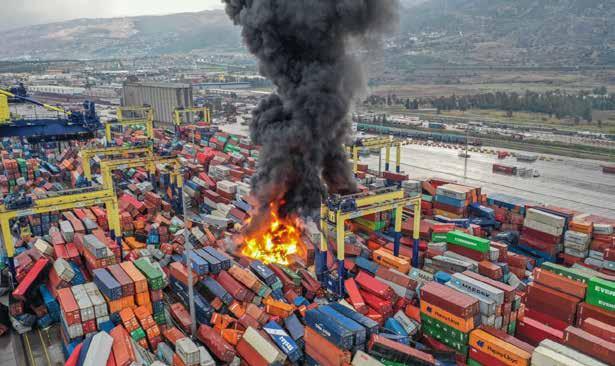
Almost 12 months ago, an earthquake measuring 7.8 on the Richter scale occurred on the border between Turkey and Syria, resulting in widespread damage, including to Turkish ports, causing carnage and operational challenges. Ports in this location on the Mediterranean coast of the country are the largescale facilities at Mersin and LimakPort Iskenderun.
Fortunately for Mersin, it was not impacted by the earthquake, but LimakPort Iskenderun was not as lucky. There was significant structural damage and a severe fire that took three days to put out, with a reported 3670 containers damaged. The stack involved subsequently toppled over.
Figure 1 provides an overview of the layout of LimakPort Iskenderun and it can be seen that there are two different berths where containers are handled. From looking at the damage subsequently occurring, notably the fire behind Berth 3-4, which offers 550m of quay and four cranes, this is a major area of the port immediately out of action. At the same time, concerns over damage that may have occurred at Berths 1-2, meant a quay line of 370m and three more cranes were also out of action, along with all rubber-tyred gantries (RTGs) in the container stacks.
Overall, the sudden loss of LimakPort Iskenderun meant that the facility’s annual capacity of one million TEU per annum was immediately unavailable.
“AT LEAST THREE MONTHS”
Despite recovery efforts commencing with immediate effect, this activity was hindered by damage caused by the earthquake. As a result, management at LimakPort Iskenderun reported that it would be “at least three months for operations to return to normal.”
At the same time and to ensure a flow of goods and freight
continued in the region, shipping lines had to instigate plans to offset supply chain disruption, as AP Moller Maersk explains: “In order to keep logistics operations moving, the majority of cargo was diverted to the nearby Port of Mersin before continuing its onward journey via inland services. However, this has now resulted in the terminal becoming heavily congested and nearing maximum capacity.”
Maersk Line was not the only shipping line using Iskenderun Port, with Cosco, CMA CGM, Evergreen and One Network Express (ONE) also regular callers. Collectively, the average monthly activity through the port was approximately 40,000 containers before the earthquake according to the operator.
With the shift of containers, mainly to Mersin, immediately after the earthquake occurred, the higher number of boxes suddenly arriving meant congestion occurring at this Turkish
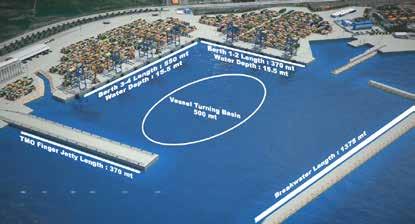
28 | JANUARY/FEBRUARY 2024 For the latest news and analysis go to www.portstrategy.com
8 Docks collapsed and fires ravaged Iskenderun after the major earthquake in Turkey in February 2023
8 Figure 1: Configuration of LimakPort Iskenderun
‘‘
LimakPort Iskenderun was quick to resume operations and Mersin has initiated a major capacity expansion
port was no surprise. Indeed, Mersin’s container yard saw heavy congestion and truck gate restrictions, resulting in vessel waiting time hitting five days according to several shipping lines.
Despite the significant damage seen at LimakPort Iskenderun, container ships returned in number just two months after the earthquake. Initially, smaller feeder vessels commenced calls as ongoing repair work continued, using one berth supported by mobile cranes, but by May 2023 larger ships were starting to return to schedule, a trend confirmed at the time by Kuehne & Nagel.
These timescales were clearly quicker than the management had initially anticipated.
The ability of the port to commence operations in such a short space of time is impressive, especially when damage across the wider region is considered, even in February 2024.
The southern province of Hatay — the region of Turkey that took the brunt of last year’s devastating and deadly earthquake - is still in a state of disrepair. Exactly one year to the day that the earthquake occurred saw local media reports that “hundreds of people are still unaccounted for and thousands more remain displaced in tents and makeshift shelters.”
This location is just 37 miles from LimakPort Iskenderun and underlines just how close the port itself is from locations where some of the worst damage occurred.
POSITIVITY IN MERSIN – ISKENDERUN SHIPS RETURN
The sudden short-term surge in Mersin highlighted how quickly congestion could occur at the port. However, this threat is planned to be alleviated. At the end of 2023, the joint venture partnership of PSA International, Akfen and IFM launched the US$455 million East Med Hub 2 (EMH2) Project at Mersin International Port Management (MIP).
EMH2 is expected to increase the annual capacity of MIP’s Mersin terminal from 2.6 million TEU to 3.6 million TEU. The quay will be expanded by 380m generating a new total length of 880m with a draft of 18 meters.
handled a seasonal spike ahead of the fes7ve period at the end of 2023 when more than 30 vessels called in some weekly periods.
CONTAINER OPERATIONS: MERSIN & ISKENDERUN
Source: Base data from Alphaliner
Source: Base data from Alphaliner
As a result, the facility will be able to handle two Ultra Large Container Ships (ULCS) of up to 400m LOA simultaneously. MIP confirms its intention to complete the first phase by Q1 2025, with full completion by the end of Q1 2026. There will be four additional STS cranes installed and eight new automated rail-mounted gantry cranes (aRMGs).
There is no doubt that the major earthquake in Turkey a year ago caused major challenges for the transport network in the affected area. However, based on ships calling, Iskenderun appears to have recovered quickly and the movement of boxes to Mersin aTer the incident further reinforced the need for Mersin to add capacity – which is now underway.
There will also be a new logistics park covering 200,000m2, following an agreement between MIP and Mersin Tarsus Industrial Zone.
For Iskenderun, it is possible to track ship calls before, during and after the earthquake to better understand the impact of the terminal damage and subsequent return to working.
Figure 2 provides a summary of weekly container ship calls to the port for 2023, courtesy of data from Alphaliner. It can clearly be seen that when the earthquake occurred and in the immediate weeks thereafter, the number of vessels recorded was zero. However, the quick reinstatement of the infrastructure helped to see more ships return and during Q2 2023 the number of container ships using the port on a weekly basis was back up to between 17 and 25. The port even handled a seasonal spike ahead of the festive period at the end of 2023 when more than 30 vessels called in some weekly periods.
There is no doubt that the major earthquake in Turkey a year ago caused major challenges for the transport network in the impacted area. However, based on the number of ships calling on a weekly basis as 2023 progressed, once the port had reopened, Iskenderun appears to have recovered quickly. Equally notable, it is likely that the sudden loss of capacity and the need to move boxes to Mersin provided an added inducement for Mersin to add major new capacity.

8 The joint venture partnership of PSA International, Akfen and IFM are advancing the US$455 million East Med Hub 2 (EMH2) Project at Mersin with the first phase expected to be complete by Q1 2025
8 Figure 2: Weekly Container Ships Calls at Iskenderun in 2023
For the latest news and analysis go to www.portstrategy.com JANUARY/FEBRUARY 2024 | 29 Figure 1 provides a summary of weekly container ship calls to the port for 2023, courtesy of data from Alphaliner. It can clearly be seen that when the earthquake occurred and in the immediate weeks thereaTer, the number of vessels recorded was zero. However, the quick reinstatement of the infrastructure helped to see more ships return and during Q2 2023 the number of container ships using the port on a weekly basis was back up to between
25. The
even
17 and
port
Figure 1: Weekly Container Ships Calls at Iskenderun in 2023
0 5 10 15 20 25 30 35 40 1 3 5 7 9 11 13 15 17 19 21 23 25 27 29 31 33 35 37 39 41 43 45 47 49 51 Number of Calls Week in 2023



Green Ports and Shipping Congress will identify and prioritise the areas that ports-based organisations and shipping companies need to collaborate on to reduce emissions.
Green Ports & Shipping Congress will cover a range of topics including:
• Maritime Digitalisation
• Green Shipping Corridors
• Future marine low and zero-carbon fuels
• Bunkering infrastructure including multi-fuel bunkering transition
• Safety standards and regulations
• Green Technologies including carbon capture, storage, and utilisation
• Green Finance - bridging the gaps in collaboration
• Incentivised Shipping – how ports can incentivise shippers to make green changes
• Collaborative projects
• Voyage planning and optimisation
• Onshore Power Supply
• The role of ports and shipping in the transport of zero carbon fuels


Media partners: PORTSTRATEGY INSIGHT FOR PORT EXECUTIVES GREENPORT INSIGHT FOR PORT EXECUTIVES MOTORSHIP MARINE TECHNOLOGY THE Visit www.greenseascongress.com
It is a must-attend event for policy makers, ports and terminal operators, shipping companies, shippers and logistics companies, fuel & propulsion providers, classification societies and associated decarbonisation clusters.
Media Supporters
further information about speaking, sponsoring or attending as a delegate, contact the Events team on +44 1329 825335
Secure your space now and save 15% Supporters: International Windship Association
Sponsors
For
or email info@greenseascongress.com
ini:a:ve.
State-owned China COSCO Shipping first secured the right to operate parts of Piraeus in 2008, during the middle of the Global Financial Crisis, which severely impacted the Greek economy . It acquired 51 per cent of the port's Greek state-owned operator in 2016, then increased its stake to 67 per cent in October 2021
Piraeus is a big player in the East Mediterranean container port market. The port’s piers offer a total length of 1150m and a maximum water depth of 18m, with a combined capacity of 7.2 million TEU per annum and serving ships up to 16,000 TEU in size.
PRIVATISATION UPS AND DOWNS
As Figure 1 shows, in the period from 2009, the first full year of COSCO opera:ons, total container volume amounted to 577,000 TEU and rose to an es:mated 1.44m TEU in 2023. The la\er figure is based on H1 2023 being up by +4.9 per cent over the comparable period of 2022. This is equivalent to growth of 3.8 per cent per annum over the period.
Buying a controlling interest in the Port of Piraeus was one of China’s first international moves to build its influence in the port industry, while Thessaloniki now has its own controlling Tsar. AJ Keyes looks at how the new owners are faring
The Port of Piraeus is the largest container port in Greece and a major port facility in the East Mediterranean region comprising cargo terminals and a ship repair operation. It is also China’s gateway into Europe and the Middle East under Beijing’s Belt and Road infrastructure-building initiative.
State-owned China COSCO Shipping first secured the right to operate parts of Piraeus in 2008, during the middle of the Global Financial Crisis, which severely impacted the Greek economy . It acquired 51 per cent of the port’s Greek stateowned operator in 2016, then increased its stake to 67 per cent in October 2021.
Piraeus is a big player in the East Mediterranean container port market. The port’s piers offer a total length of 1150m and a maximum water depth of 18m, with a combined capacity of 7.2 million TEU per annum and serving ships up to 16,000 TEU in size.
As Figure 1 shows, in the period from 2009, the first full year of COSCO operations, total container volume amounted to 577,000 TEU and rose to an estimated 1.44m TEU in 2023. The latter figure is based on H1 2023 being up by +4.9 per cent over the comparable period of 2022. This is equivalent to growth of 3.8 per cent per annum over the period.
Piraeus – fantastic financial performance but worker related concerns ‘‘
Yet it is the period when COSCO took a controlling share of Piraeus, in 2016, when container port volumes were ramped up, rising from 746,412 TEU to over 1.41 million TEU by 2019 – and maintaining around the 1.4 million TEU total thereafter.
The Chinese shipping giant says it directly employs over 2000 people at the port and creates about 10,000 jobs overall.
Evangelos Kyriazopoulos Greek Secretary General for Maritime Affairs and Ports endorsed this statistic, confirming that in 2021, “ COSCO created 4279 direct and indirect jobs, equal to 0.12 per cent of total employment in the country, thus providing income to more than 11,000 citizens.” In round numbers, this contributes more than €1.4bn to the national economy.
While this may be true, there are concerns. Local residents in Piraeus feel that while jobs have been created, they are not “good jobs,” which is a longstanding comment from Giorgos Gogos, Secretary of Dockworkers Union of Piraeus Ports Authority (P.P.A.). He tells how some operations in the port rely on workers who are employed through contractors and receive no safety training – and it has resulted in accidents, with one well-publicised fatality occurring in Q4 2021 when a stevedore was struck by a container crane.
Nevertheless, the port authority is reporting further financial success. In a recent interview with Chinese media, Savvas Sanozidis, Board Secretary, PPA, confirmed a “fantastic financial performance.” In 2023, PPA’s pre-tax revenue rose to US$79.20 million and dividends rose to the highest ever, jumping 65 percent to US$27.45 million, he said.
Regardless of the financial figures generated, there is still
Yet it is the period when COSCO took a controlling share of Piraeus, in 2016, when container port volumes were ramped up, rising from 746,412 TEU to over 1.41 million TEU by 2019 – and maintaining around the 1.4 million TEU total thereaaer.
Figure 1: Total Container Traffic at the Ports of Piraeus and Thessaloniki, 2000-2023e in TEU
Source: www.dataand.com
more work to be done by COSCO in the local community.
“COSCO has not lifted the local economy as much as the community hoped,” Gogos has been quoted as saying, endorsing the level of unhappiness that remains.
RUSSIAN TSAR OF THESSALONIKI
Greece’s second largest container port, Thessaloniki, has also transitioned into foreign ownership. The Thessaloniki Port Authority (ThPA) was privatised in March 2018 and is now operated by South Europe Gateway Thessaloniki (SEGT) Ltd. The controlling shareholder of SEGT Ltd is Belterra Investments Ltd., which is owned by Russian billionaire, Ivan Savvidis, who effectively controls 71.85 per cent of the company’s shares.
Savvidis is one of Russia’s wealthiest oligarch’s and a former member of the Russian Parliament, but also reportedly had close links to Russian president, Putin. Savvidis has been regularly dubbed as the “Russian Tsar of Thessaloniki” in the press in Greece.
SEGT paid US$287 million for the port, but the full cost of the deal will reach US$1.36bn as it includes a need to invest an estimated US$450 million in the first seven years of the project, as well as additional longer-term investment in upgrading infrastructure over the 34-year concession period, as the port seeks to strengthen its role as a key link for serving the wider Balkan region.
A Pier 6 container terminal extension of 440m and dredging to get 16.5m water depth is planned and is essential for the port to target larger and more frequent ships from Asia. There has been an increase in container traffic in Thessaloniki since the privatisation, with the 2016 total of 344,216 TEU rising by 3.9 per cent by the end of 2023 (based on an estimated 2023 total). This is in-keeping with overall growth in the country, but achieving further growth is reliant on improved infrastructure.
Piraeus and Thessaloniki serve different roles in Greece, of transshipment and transit markets, respectively. Both are privatised and under the control of potentially challenging organisations from China and Russia, respectively. Piraeus is further along the privatisation road, so it is hard to make a direct comparison to Thessaloniki, but for both ports potential remains for disruption and unhappiness at a local level, even if the national government seeks to portray a positive outcome of foreign involvement.
CONTAINERPORT DEVELOPMENT: GREECE
8 Figure 1: Total Container Traffic at the Ports of Piraeus and Thessaloniki, 2000-2023e in TEU
For the latest news and analysis go to www.portstrategy.com JANUARY/FEBRUARY 2024 | 31 Source: www.dataand.com
0 200,000 400,000 600,000 800,000 1,000,000 1,200,000 1,400,000 1,600,000 2000 2001 2002 2003 2004 2005 2006 2007 2008 2009 2010 2011 2012 2013 2014 2015 2016 2017 2018 2019 2020 2021 2022 2023e
Piraeus
Thessaloniki
APRIL Port of Amsterdam
2024 The Netherlands
Hosted by:

Hotel Jakarta Amsterdam, The Netherlands

Sponsors:
Supporters:

Gold Sponsor


A neutral pan-European network dedicated to the promotion of short sea feeder shipping plus the sustainable intermodal and logistics networks through the ports that support the sector.
Chairman: Nick Lambert, Co-Founder & Director, NLA International Ltd
visit: coastlink.co.uk
contact: +44 1329 825335
email: info@coastlink.co.uk #Coastlink
Media





GREENPORT INSIGHT FOR PORT EXECUTIVES MOTORSHIP MARINE TECHNOLOGY THE
partners:
24 25 TO
The short sea shipping & sustainable logistics network Conference Programme
DAY ONE – Wednesday 24th April 2024
THE SHORT SEA SHIPPING AND SUSTAINABLE LOGISTICS NETWORK
08:30 Coffee & Registration
09:00 Chairman’s Welcome
Nick Lambert, Co-Founder and Director, NLA International Ltd
SESSION 1: EMERGING OPPORTUNITIES FOR SHORT SEA SHIPPING – HOW IS THE MARKET ADAPTING TO ECONOMIC & MARKET PRESSURES TO SUSTAIN FUTURE GROWTH
09:10 Welcome Address
Port of Amsterdam
09:25 Gold Sponsor Address
Andima Ormaetxe, Director for Operations, Commercial and Logistics, Port of Bilbao
09:35 Keynote Presentation
Johan-Paul Verschuure, Director, Rebel Ports & Logistics
Shortsea market is making waves: sanctioned volumes, shift to unaccompanied/Lo-Lo, impact of carbon taxing on routings, deep-sea operators entering.
09:50 Keynote Presentation
Kari-Pekka Laaksonen, Group CEO, Samskip
Preparing for a sustainable future begins with action today.
10:05 Is the short sea fleet ready to address the call for green and sustainable growth?
Sabine Kilper, Senior Research Analyst, Toepfer Transport Gmbh
The current state of the short sea market, orderbook, latest newbuilding trends and key drivers of the green fleet renewal in European short sea shipping.
10:20 Q&A
10:40 Coffee & Networking
11:15 PANEL DISCUSSION: Green corridors – collaboration to drive sustainable growth
Panel Moderator: Richard Ballantyne OBE, Chief Executive, British Ports Association
Panellists include:
Eleni Bougioukou, Innovation Manager - Energy and Sustainability, Port of Tyne Katrina Ross, Policy Director, Commercial and Governance, UK Chamber of Shipping
12:30 - 14:00 Lunch & Networking
SESSION 2: ADVANCING SUPPLY CHAIN RESILIENCE & EMBRACING THE BENEFITS OF MODAL SHIFT
14:00 Keynote Presentation
Marijn Moesbergen, Cocoa Sourcing Lead, Cargill
Almar van Herk, Senior Business Development Manager, KOTUG International B.V.
14:15 Speaker Invited*
To be confirmed
14:30 The role of modal shift in the supply chain
Alexandra Herdman, Senior Policy Manager, Logistics UK
Whether domestic or international, making supply chains efficient and safe is the main objective of Logistics UK. One way to achieve this is to move more goods by rail and water, showcasing the vital role modal shift can play in building resilience into the supply chain.
14:45 Delivering more resilient supply chains and end to end sustainability through short sea shipping
Maria Matuszek, Commercial Manager, Associated British Ports ABP is the UK’s leading Ports Group, operating over 21 ports and showcasing how to deliver more resilient and sustainable supply chains.
15:00 Q&A
15:20 Day 1 Wrap-Up – Chairman (Pre-Port Tour)
15:30 Coffee & Networking
*invited
Book Online at coastlink.co.uk/buy or scan form to +44 1329 550192 For further information please call +44 1329 825335 or email info@coastlink.co.uk
16:00
-18:30 Port Tour aboard ‘Het Wapen van Amsterdam’ - the largest salon boat still sailing in Amsterdam and its surroundings. The vessel dates from 1948 and has served for over 50 years on the Thuner and Brienzersee lakes, with Interlaken as its home port. Enjoy a tour through the Amsterdam port area while enjoying the Evening Drinks Reception aboard, hosted by the Port of Amsterdam.
19:30 Conference Dinner at Restaurant ‘Kanteen 25’
Sponsored by the Port of Amsterdam
DAY TWO – Thursday 25th April 2024
08:45 Arrival: Coffee
Conference Chair: Nick Lambert, Co-Founder and Director, NLA International Ltd
Sponsored by
SESSION 3: PORTS AS ENABLERS – FACILITATING THE ENERGY TRANSITION FOR SHIPPING & THE SUPPLY CHAIN
09:15 Chairman’s Opening
09:25 Keynote Presentation
Pavan Chhabra, Head of Hubs - Europe, Maersk
09:40 Port of Amsterdam taking the lead in the energy transition
Maurice Delattre, Area Manager, Port of Amsterdam
Providing some concrete examples on the port’s approach of creating an ecosystem for renewable energies, international cooperation to facilitate the development of green value chains and sharing insights on the progress of our ongoing strategic projects.
09:55 Energy transition: A challenge and an opportunity for ports
Patrick Walison, Senior Consultant, Royal HaskoningDHV
This contribution focuses on the challenges, opportunities and impact of the energy transition on ports and shipping, specifically related to offshore wind and hydrogen.
10:10 The Port of Bilbao’s contributions and new tools to improve and assess supply chain processes for a responsible business model
Andima Ormaetxe, Director for Operations, Commercial and Logistics, Port of Bilbao Port of Bilbao’s contribution and new tools to improve and assess supply chain processes for a more environmentally responsible business model.
10:25 Q&A
10:45 Coffee & Networking
11:15
PANEL DISCUSSION – Shore Power – Overcoming the barriers to infrastructure and delivery
Panel Moderator: Kerrie Forster, Chief Executive Officer, The Workboat Association Panellists include:
Johan-Paul Verschuure, Director, Rebel Ports & Logistics
Arjan Meijer, Area Sales Manager, Cavotec
James Evans, Head of Operations, Portsmouth International Port
Geraint Evans, Chief Executive, UK Major Ports Group
12:30 Lunch & Networking
14:00 PANEL DISCUSSION – Smart operations & logistics - What’s next in Digitalisation, Automation, and Innovation to drive efficiency?
Panel Moderator: Lars Robert Pedersen, Deputy Secretary General, BIMCO Panellists include:
Mark Wootton, Deputy Director, Royal HaskoningDHV
Rob Tonissen, Business Manager, Routescanner
Mo Dualeh, EMEA Sales Manager, TBA Group
Port of Antwerp-Bruges invited*
15:20 Conference Wrap up – Chairman *invited
Book Online at coastlink.co.uk/buy or scan form to +44 1329 550192 For further information please call +44 1329 825335 or email info@coastlink.co.uk
Conference Fee
Premium Package
£660GBP/ €790euro
per delegate
Standard Package
£620GBP/ €745euro
per delegate
Fee Includes
• Conference attendance including lunch & refreshments
• Electronic documentation
• Technical Visit 24 April 2024
• Conference Dinner 24 April 2024 (Premium Package)
• Presentation download (Premium Package)
Booking Online coastlink.co.uk/buy or complete and scan the booking form below to info@coastlink.co.uk. On receipt of your registration, you will be sent confirmation of your delegate place
Contact Us
For further information on exhibiting, sponsoring, or attending the conference, contact the Events team on: +44 1329 825335 or info@coastlink.co.uk
Venue
Hotel Jakarta, Javakade 766, Amsterdam 1019 SH, The Netherlands
BOOKING FORM
BOOK ONLINE OR COMPLETE THIS FORM AND SCAN TO info@coastlink.co.uk
Please tick all that apply :
(Please copy this form for additional delegates)
Please register me for the Coastlink Conference 2024. I will attend the following:
Conference dinner (24th April 2024)
Technical Visit (24th April 2024)
Members of supporting associations will receive a discount I am a member of
HOW TO PAY *UK registered companies will be charged the standard rate UK VAT
Bank Transfer: Mercator Media Ltd, HSBC Bank plc, GBPaccount, Sort Code: 40-21-03, Account number: 91894919
SWIFT/BIC8: HBUKGB4B BRANCH BIC11: HBUKGB4131C, IBAN: GB61 HBUK 4021 0391 8949 19
Bank Transfer: Mercator Media Ltd, HSBC Bank plc, EURaccount, Sort Code: 40-12-76, Account number: 70235247
SWIFT/BIC8: HBUKGB4B BRANCH BIC11: HBUKGB41CM1 IBAN: GB35HBUK40127670235247
Prepayment is required in full for entry to the conference. Full terms & conditions are available at mercatormedia.com/our-business/terms-and-conditions
Credit/Debit
Name
Mr/Mrs/Ms/Dr/Other Company
Title Country Telephone Fax Email Signature Company Address Company VAT No. SPACE AT THE CONFERENCE IS LIMITED – RESERVE YOUR PLACE TODAY! Book online at coastlink.co.uk/buy or scan booking form to info@coastlink.co.uk Registered in England. Company Number 2427909. Mercator Media Ltd reserve the right to alter the timing, content or speeches of this conference at any time. Full terms & conditions are available at mercatormedia.com/our-business/terms-and-conditions Signature Credit Card Billing Address Security Code Name on Card Expiry Date
Number
charge my card (delete as appropriate) Mastercard/Visa/Amex
Family Name First
Title
Job
Card
Please
by bank transfer
I have paid
Card: Complete the form with your card details (3 Numbers on the reverse/ AMEX 4 numbers on front)
Visit coastlink.co.uk
Cost
Cost
Please fax form. Do not send by email as we cannot guarantee the security of card information.
Further information call +44 1329 825335 or email info@coastlink.co.uk. Book online at coastlink.co.uk/buy
APRIL Port of Amsterdam 2024 The Netherlands 24 25 TO
HYDROGEN EQUIPMENT TRIALS
Trials of a hydrogen powered reach stacker and terminal tractor are underway in the Port of Valencia, marking a double first for the operation of this type of equipment. Mike Mundy reports
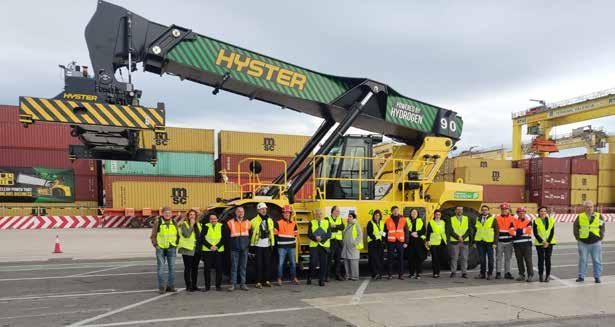
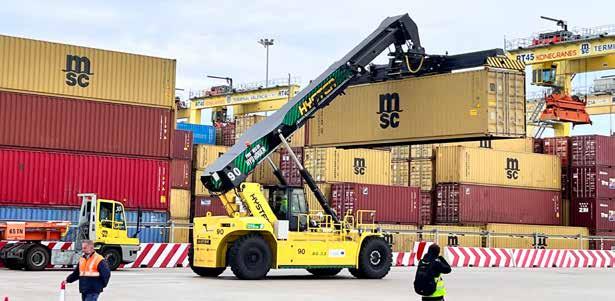
Now in service under normal operational conditions at the port of Valencia is a hydrogen powered reach stacker at the MSC Terminal Valencia and a hydrogen powered terminal tractor at the Grimaldi operated Valencia Terminal Europa. Introduced in late 2023, well known cargo handling equipment supplier Hyster is the force behind the development of the reach stacker and the ro-ro tractor was developed by ATENA, a research and technology hub based in the Campania Region of Italy. Both units are acknowledged to be highly innovative and the first of their kind to be put into operational service, albeit on a test basis. Prolonged testing – for up to a year – will enable performance assessment of the machines in their own right and in comparison to conventional diesel powered units.
Developed as part of the H2PORTS project, a clean hydrogen partnership involving the Port Authority of Valencia, the Valenciaport Foundation and a range of other participants
including the two terminal operators referenced above, the expectation is that the fuel cell powered Hyster reach stacker will offer a performance comparable to a diesel powered version in terms of capacity and lift and drive speeds, utilising independent traction and hydraulics with different electric motors to serve different functions. In terms of operational duration, Hyster reports that when combined with the right application and operating intensity it expects the machine to be able to work for two shifts before a hydrogen refuelling is required. As far as this process is concerned, the reach stacker is designed to interface with the standard hydrogen filling station connection thereby facilitating wide usage.
The design provides for four hydrogen tanks as a standard option to store hydrogen in the body of the reach stacker.
The hydrogen fuel cell supplies power to the electric motors or returns it to the batteries depending on the demands of the task in hand, while simultaneously
8 The machine arrived at the MSC terminal for testing in September 2023, becoming the first reach stacker in Europe to use hydrogen fuel cell technologies for powering port handling equipment under real operating conditions
CONTAINER HANDLING: EQUIPMENT INNOVATION 32 | JANUARY/FEBRUARY 2024 For the latest news and analysis go to www.portstrategy.com
CONTAINER HANDLING: EQUIPMENT INNOVATION
At Valenciaport we are committed to all the options that lead to decarbonisation; and this project is probably the first in the world to use hydrogen in port terminal machinery operations
Francesc Sánchez, Director, Port of Valencia
considerably reducing greenhouse gas emissions and noise pollution compared to a diesel unit.
As the Port Authority of Valencia underlines, Hydrogen is a clean energy carrier with the inherent advantages of easy storage and, when used, the production of no emissions other than heat and water.
The hydrogen fuel cell converts H2 into electricity, resulting in zero-emission equipment that, when combined with the use of environmentally-friendly hydrogen, is also carbon neutral. The technology generally is seen to have some advantages compared to other available zero-emission technologies such as pure electric. As touched upon above, this hydrogen powered reach stacker is seen to have a good range as well as low fuel consumption. It can also handle containers weighing in excess of 30 tonnes.
REFUELLING CHALLENGE
The challenge with refuelling the reach stacker is to get the time required to do this down to five minutes from the current 15 minutes it now takes.
The hydrogen supply station includes a fixed part dedicated to the reception, storage and compression of hydrogen up to delivery pressure and a mobile part that stores the compressed hydrogen and has a dispenser for refuelling the reach stacker and terminal tractor.
The tractor design features a fuel cell/battery hybrid powertrain which reportedly allows the vehicle to perform all the intensive tasks that are required during roll-on roll-off
operations. Its hydrogen storage system, made up of four Type 3 cylinders (350 bar), has an overall capacity of around 12 kg, which is said to guarantee a continuous operation of at least six hours before refuelling is required – this corresponds to the average duration of a working shift.
The electric motor utilised is described as a “light and efficient device, particularly suitable for power demanding applications.” It is fed by a high-performance LiFePO4 battery, with 25 kWh energy capacity, and a 70 kW Ballard fuel cell module. The electric motor can receive power for traction from the fuel cell and battery simultaneously or charge the battery during braking or decelerations. At the same time, the fuel cell can provide power both to the electric motor and the battery, if needed. The hybrid powertrain is said to facilitate high operational efficiency, since it takes advantage of a significant share of kinetic energy recovery.
PROJECT COORDINATES
The European project – H2PORTS – Implementing Fuel Cells and Hydrogen Technologies in Ports is coordinated by the Valenciaport Foundation in collaboration with the Port Authority of Valencia. It is financed by the Clean Hydrogen Partnership programme and has as its stated core objective to test and validate hydrogen technologies as applied in port machinery which “allow applicable and real solutions without affecting the performance and safety of port operations and producing zero local emissions.”
Total investment in the H2Ports project is put at around €4 million and involves, in addition to the Valenciaport Foundation and the Port Authority of Valencia, the National Hydrogen Centre, as well as the private companies MSC Terminal Valencia, Grimaldi Group, Hyster-Yale, ATENA Distretto Alta Tecnologia Energia Ambiente, Ballard Power Systems Europe, Carburos Metalicos (Air Products Group) and Enagas.
The Port of Valencia claims to be the first port in Europe to incorporate hydrogen technologies to reduce the environmental impact of its operations. The trials of both the reach stacker and terminal tractor will run through to the end of 2024 ensuring comprehensive performance assessment.

8 The new hydrogen powered 4 x 4 terminal tractor is being put through its paces at Grimaldi’s Valencia terminal – comprehensive testing will continue until end 2024
For the latest news and analysis go to www.portstrategy.com JANUARY/FEBRUARY 2024 | 33
‘‘
OCT 2023 Lisbon Portugal
Host Port:
Did you miss it?
Balancing environmental challenges with economic demands
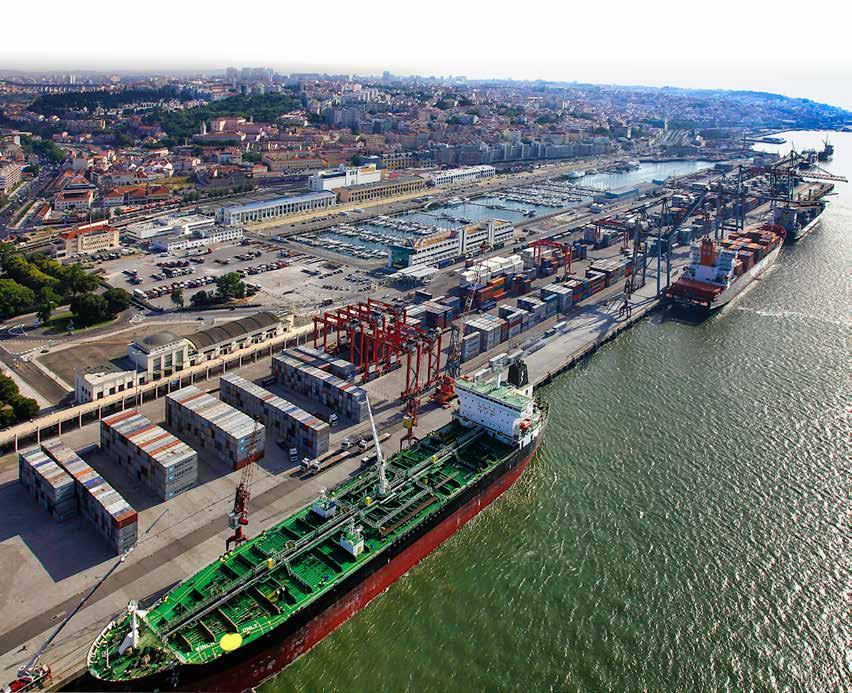
Downloads available now on balancing environmental challenges with economic demands.
60 Papers and Presentations
Plus On Demand Videos Now Available
Access Greenport Congress and Cruise complete download including on-demand content only €330 - Buy here.
Sponsored by:
Supported by:

Topics & Presentations cover:
Climate Change: Energy efficiency, GHG emissions reduction & adaptation
Cruise Infrastructure Development
Carbon Neutral Ports
Shore Power
Infrastructure Development for Ports
Offshore Renewables & Alternative Energies
Waste Management and Circular Economy
Blue Growth
Digitalization and Technology






Greenport Congress and Cruise offers a forum to meet and network with over 200 attendees representing port authorities, terminal operators and shipping lines.
Date for next year - 16th to 18th October 2024.
visit: greenport.com/congress
tel: +44 1329 825 335
email: congress@greenport.com
Media Partners:






#GPCongress
EUROPE: EMISSIONS TRADING SYSTEM
ETS: COMPLEX AND CHANGING
The European Union’s Emissions Trading System (ETS) became applicable to shipping from January – just as the crisis in the Red Sea was escalating. Felicity Landon addresses the key points
The introduction of the EU’s Emissions Trading System (ETS) for shipping already came with daunting new mountains of admin and significant uncertainty. There are complex issues and questions still not resolved, and that’s quite apart from the significant new costs involved. which themselves cannot be pinned down, and the threat of hefty fines for non-compliance.
Could this new carbon tax lead to a transshipment merrygo-round and/or entirely new trading patterns? Would owners simply deploy their best quality tonnage in Europe and send the rest elsewhere? Might some ship owners even opt out of Europe altogether?
Suddenly, the Houthi attacks in the Red Sea have thrown it all up in the air. At the start of the year, Lloyd’s List Intelligence reported that diverting away from the Suez Canal and around the Cape of Good Hope could cost up to US$1 million per voyage in ETS costs for certain container ships, as faster speeds and longer distances nearly double CO2 emissions. “Carriers will pass on the cost, but emissions will rise at a bad time for an industry trying to be greener,” said the report.
Under the EU ETS, ship owners must verify and report emissions data for every vessel of 5,000 gt and above entering EU ports. Owners are required to open a Maritime Operator Holding Account to transfer and surrender EU Allowances (EUA) – carbon credits – which must be purchased. However, the EUAs themselves are traded on the free market and therefore subject to price volatility.
Shipping companies must purchase EUAs for 10 per cent of emissions from voyages between EU ports or for ships docked at an EU port; or 50 per cent for voyages between an EU and non-EU port. The system is being phased in; 40 per cent of emissions reported in 2025 (for 2024) must be covered by EUAs. That rises to 70 per cent in 2026 (for 2025 reported emissions) and 100 per cent in 2027 (for 2026).
The rules apply regardless of the ship’s flag, and there are some strange winners and losers in the whole picture.
CONTAINERSHIPS MOST EXPOSED
Albrecht Grell, Managing Director, OceanScore, which offers an ETS management solution, says container ships are the most exposed to the system, accounting for 28 per cent of the total EUAs required by the industry, due to their size and speed. The most expensive according to vessel type will be ro-pax and cruise ships, he notes.
As for the proceeds of the ETS, 10 per cent of the total is destined for an EU fund for sustainability projects for shipping. Another 10 per cent will go to the EU’s social fund. The remaining 80 per cent goes “straight into national state coffers”, based on some complex calculations – with Greece, Germany, the Netherlands and Cyprus set to benefit the most.
The first winners within this 80 per cent are wherever the ship owner is based in the EU, or where the manager responsible for ETA compliance is based. In second place, where the owner or manager is outside the EU, the funds go to the state according to which port the vessel has made the most calls in the past five years. This would make the Netherlands a strong winner, said Grell. He said there might be an incentive here for states to attract more ship calls to a
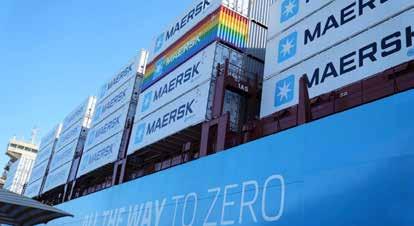
particular port in the hope of bringing in more ETA money for the treasury.
Overall, he says, “less efficient tonnage will suffer and more efficient tonnage will suffer less”. He said trading patterns will change but he does not see or expect substantial evasive behaviour. “Our experience is that shipowners are not obsessed with avoiding these fees. It is about making sure they work in an efficient way.”
There were fears last year that one unintended consequence would be a mass shift of container carriers from EU transshipment hubs to hubs just outside the EU in the hope of cutting the liability to 50 per cent. In this scenario, the big losers would be the southern EU ports in the Mediterranean. However, towards the end of last year (2023), the EU addressed these concerns, setting out criteria which designated Tanger Med and East Port Said as official ‘neighbouring transshipment ports’ and therefore included in the ETS regime.
Nigel Crawford-Brunt, CEO at Lookout Maritime and decarbonisation lead at the Baltic Exchange, said people have been “kicking the tyres” on potential diversions. “But the EU has a reasonable handle on it and understands liner shipping. It’s now official that Tanger Med is considered an EU port call.”
Yes, in theory (and notwithstanding the regional tensions), a container ship could take a stop in Saudi Arabia or Dubai and transship from there to Europe. “But at a certain point, all the hassle of doing that negates the cost being saved,” says Crawford-Brunt. He suggests there might be a move to truck goods out of the EU from Greece into Turkey for onward loading (and vice versa). “But again, there are a lot of diminishing returns.”
He believes there is “a substantial incentive to cheat – and shipping is nothing but creative”.
“I wouldn’t advocate it, of course. But if it does happen, it leaves the more established players that have reputations to manage in a less competitive position. But this is shorttermism, because the regulator has a very long memory. No one responsible, identifiable and professional would try it.”
Shipping lines were already publishing a range of surcharges to cover the ETS costs towards the end of last year. Now, of course, with the Suez Canal having waved goodbye to nearly a quarter of ship transits due to the Houthi attacks, all bets are open.
8 Albrecht Grell, Managing Director, OceanScore, suggests container ships are the most exposed to the system, accounting for 28 per cent of the total EUAs required by the industry, due to their size and speed
For the latest news and analysis go to www.portstrategy.com JANUARY/FEBRUARY 2024 | 35


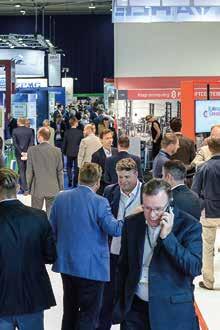
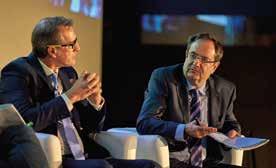



























JOIN US THIS JUNE! NEW FEATURES – GREATER OPPORTUNITIES NEW REGIONAL SPOTLIGHT THEATRE - NEW CONTENT THEMES - NEW EXHIBITORS 11 - 1 13 J June 2 2024 | Rotterdam Events | Live & Digital Content | Networking J o in the conversation online #TOCEurope www.tocevents-europe.com
BEWARE DATA SCRAPING
Unfair data scraping practices being deployed in the port, terminal and wider supply chain context can create something akin to the impact of a rush for Glastonbury tickets – except that it never ends. Felicity Landon reports
Don’t we all hate bots? Sometimes they are just an irritation –but in the context of a Port Community System (PCS) or other platform providing real-time or near-real-time information exchange vital to smooth cargo flows through ports, data scraping bots could bring things to a virtual standstill.
Parvez Mansuri, CEO, Advent eModal, says the practice of data scraping is causing increasing problems for genuine users of PCSs and other logistics information portals. But what exactly is data scraping and why does it matter?
In short, scraping is when a computer program can extract data from output generated from another program – mostly, it applies to web scraping, used to extract valuable information from a website.
“A lot of our solutions depend on fluid, efficient data flow between us and others’ systems, to facilitate the movement of the container across multiple stakeholders and avoid friction,” says Mansuri. “However, there is a mis-use of the data, scraping being one of them, that impacts our traditional partners who are sharing the data through a normalised channel. Indirectly we get impacted by unfair scraping practices by various stakeholders, and this increases the burden on our customers.”
Scraping of reasonably static data – for example, a fashion website, for use in a fashion catalogue – will likely not make a big impact, he says. But in the ports and logistics context, the data is changing all the time. “This means they have to keep continuously scraping, i.e. reloading that page every second. The result can be that humans/normal users trying to gather information in a rightful way always have latency on screens, slowness on the web – and sometimes that information becomes unavailable.”
THE TICKETS NEVER RUN OUT
There are parallels with a ticketing website for an in-demand festival or concert being jammed by customers – but with one difference. “In our context, the tickets don’t run out. It never ends, it is continuously ongoing.”
Imagine a PCS or other portal has been set up with the knowledge that it will be serving 10,000 truckers, each with ten despatchers, so 100,000 potential users. The system is designed and resourced to ensure an efficient and seamless experience on the website for those users. “Then suddenly one company is pulling your website every second – and instead of 10,000 you have a 10 million kind of consumption.”
The use of data scraping bots reflects a desire for ever more visibility, Mansuri notes. For example, a despatcher at a trucking company operating in a major port might be going to the websites of a dozen different terminals. “To make that efficient, truckers started deploying this scraping technology that was in use in other markets. It’s a very simplistic technology – but it is also a blunt tool for a significantly sophisticated problem.”
It’s easy for truckers or logistics providers that don’t have enough IT resources to outsource to scraping tech companies, he says. “Third party providers make it very easy and very cheap. It works 50-60 per cent of the time. But that is another part of the problem – consumers subscribe to
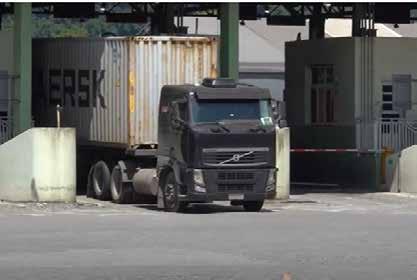
multiple scraping sources so they can validate that the information is accurate. This multiplies the impact.”
None of this is illegal per se – but it could be if the website’s terms of use specifically and explicitly prohibit scraping activities.
Many perfectly respectable entities will say they have a ‘visibility company’ providing visibility data but do not understand how this data is being collected, he says. Also, the information obtained in this way provides the basics (container unloaded, container in the yard) but not the detail (is the yard open or closed for delivery, can you pick up the container?).
‘‘
It’s a very simplistic technology – but it is also a blunt tool for a significantly sophisticated problem
What is the solution? “Terminals should have a secured website that requires users to identify themselves and accept terms of use. Put it behind a pay wall or security wall.”
Opting for APIs will provide a more secure approach, he adds. It’s also possible to put specific containers on a ‘watch list’ – so it’s clear who is watching each container, users can be tracked and there is no anonymous use. Advent eModal does get impacted by scraping but “we have good mechanisms to track who is doing this”.
Often, for the websites affected, this is a case of legacy practices and not understanding or quantifying the impacts – which can be considerable, says Mansuri. “Data scraping on your website can make its way into the wider IT system and slow everything. It depends on how networks are designed – some separate critical and non-critical infrastructure, but some don’t. In the latter case, it means that every time you have a scraper attacking your website, it’s possible your TOS is slowing down because of it.”
8 It’s easy for truckers or logistics providers that don’t have enough IT resources to outsource to scraping tech companies but this can have a negative impact
THE THREAT OF DATA SCRAPING
For the latest news and analysis go to www.portstrategy.com JANUARY/FEBRUARY 2024 | 37
BULK SHIPPING OUTLOOK
The dry bulks, liquid bulks and gas shipping sectors navigated ‘unprecedented global circumstances’ in 2023 – and 2024 promises a landscape of ‘continued change and evolution.’ Felicity Landon reports

War, inflation, trade upheavals, environmental pressures – the shipping industry must deal with it all. At a Drewry webinar focusing on bulk shipping, Drewry’s experts set out their views on the year ahead. They painted a challenging and uncertain picture.
Last year was a turbulent 12 months for the dry bulks sector, especially with the Ukraine war continuing and the new war in Gaza, said Rahul Sharan, Head of Dry Bulk Research, Drewry. The shortage of water in the Panama Canal added to the challenges, along with inflation and other geopolitical tensions.
In 2024, key factors driving the market will be China’s demand for coal and iron ore, and shipping supply side issues based on how ship owners will cope with the EU Emissions Trading System and IMO emissions requirements, said Sharan. “China will keep driving the coal shipping demand in 2024 as it did in 2023. In the past few weeks (late 2023), there have been a couple of mining incidents in China so that a couple of mines might be operating at a below par level, or not operating at all. That means domestic coal production might not be as high in 2024, so imports into China might go further up.”
Aside from China, most steel producing countries imported less iron ore. “However, we believe that with easing pressures on economies in 2024 there could be positive iron ore trade in all the major economies and the trade will grow more than we have seen in 2023.”
SUPPLY SIDE
On the supply side, the dry bulk shipping orderbook has been very low and remains so for 2024, he said. “Fleet growth will be very restricted, to 1.2-1.3 per cent in 2024. At the same time, because of environmental regulations we might see demolitions going up. The pressure of these regulations could see some older ships heading for the scrapyards.”
The expectation of higher rates might prompt more orders in 2024, he noted – this would have no impact this year but could affect overall earnings in the years to come.
Sharan was asked: “Are handysize vessels slowing leaving the market and being replaced by supramaxes and ports getting bigger? He replied: “Handysize vessels have been very important for specific segments and are not going to go away. Also, many smaller ports are not in the position to handle ships that are bigger than handysize.”
Another key question in dry bulks is what happens in the grain markets this year in the context of the Russia-Ukraine conflict? “We might see more grain coming out of the Black Sea in 2024,” he said.
As for the Red Sea, the diversions away from the Suez Canal come on top of the fact that a lot of cargo was being diverted away from the drought-hit Panama Canal to use the Suez Canal. This, said Sharan, added to overall tonnage demand for the longer voyages. Now, with many ships avoiding the Red Sea and therefore Suez, even more diversions will be required.
DREWRY BULK SECTOR ANALYSIS 38 | JANUARY/FEBRUARY 2024 For the latest news and analysis go to www.portstrategy.com
8 China holds the key to demand in the iron ore sector
DREWRY BULK SECTOR ANALYSIS
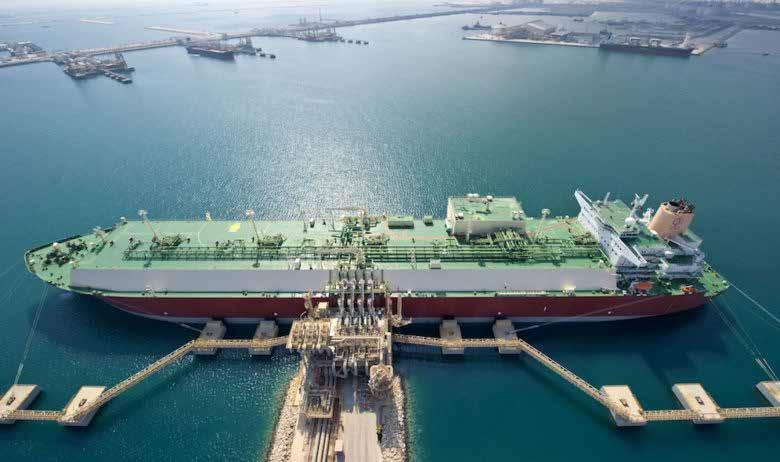
WET BULKS DEMAND
Last year was very strong for liquid bulk ship owners as rates surged, said Rajesh Verma. “There were three main reasons behind this. First, surging global oil demand, primarily driven by the return of demand post-Covid. Second, shifting trade patterns because of the Ukraine-Russia war, which mainly benefited mid-size tankers. The increase in China’s refinery capacity added to this. Third, there was a decline in deliveries (of new ships). There was no significant scrapping in the year due to the strong demand and high earnings for crude tankers.”
This year (2024) will see significant change in both demand and supply sides, said Verma. A tight supply of ships will keep rates buoyant despite a deceleration in demand, he predicted. The orderbook has ‘declined sharply’ to a level equivalent to four per cent of the current fleet.
“The fleet growth will shrink. Any increase in scrapping activities is unlikely, but the IMO regulations might have some impact – especially, for example, a slowdown in vessel speed. We believe that tanker owners will continue to enjoy higher rates.”
Although the market looks positive, there are major risks, he said, in the form of geopolitical tensions and any increase in the ‘grey trade’ of Iranian and Russian crude oil.
The product tanker market has been similar to the crude tanker market, with ‘astronomically high’ rates in 2023, said Verma. “In addition to the surge in demand, the shift in trade patterns has played a significant role in the product tanker market with a surge in tonne mile demand.”
An expected slowdown in crude oil demand will affect the product tanker market too, he added, while refinery capacity additions in key oil consuming countries such as Nigeria will also reduce shipping demand.
One unknown is what happens with oil-rich Venezuela. “If sanctions were removed, any recovery would be gradual but would have a positive impact on the demand for tankers to Asia. Any long-haul trade would increase. Similarly, any delay in the Dangote refinery in Nigeria would be positive for the crude oil tanker market.”
The LNG market will be volatile this year, with fleet growth surpassing trade growth, and hence putting pressure on charter rates, said Aman Sud.
He expects European storage levels to be at about 40 percent towards the end of the heating season, and therefore less hurry/urgency to refill. “Having said that, the region will be aware of what happened in 2022 with the energy crisis, so is putting a lot of importance on storage.”
The LNG fleet picture is entirely different to the dry and liquid bulk tankers scene. The fleet is expected to expand by nine per cent this year: “Expect charter rates to be a little bit subdued in the second, third and fourth quarters. After 2024, the phasing out of vessels due to the new environmental (EEXI) regulations and larger liquefaction plants coming on-line from 2025 will re-establish the equilibrium, and the market will then be very tight until at least 2028. We believe this is going to be a sector to watch out for over the next five years.”
‘‘
The LNG fleet picture is entirely different to the dry and liquid bulk tankers scene
The LPG market saw a surge in US-Asia trade in 2023 adding to tonne mile demand and the Panama Canal restrictions also affected LPG shipping rates, said Sud. “Restrictions due to draught limits in the Panama Canal are expected to persist through 2024.”
LPG growth is expected to slow to two per cent this year. Ammonia, however, is expected to increase by seven per cent as decarbonisation picks up speed. “A lot of companies are planning to increase their ammonia trade.”
The LPG fleet is expected to expand by four per cent in 2024, with 41 vessel deliveries – the majority being VLGCs.
Apart from the geopolitical tensions, Panama Canal limits and new deliveries, factors that could cause volatility in the LNG/LPG sector this year include fossil fuel reduction, internal threats and political risk – particularly in this ‘year of elections’ “Any changes in countries’ energy policies [post election] and how they view decarbonisation is going to affect the sector.”
8 Drewry anticipates LNG fleet growth of nine per cent in 2024
For the latest news and analysis go to www.portstrategy.com JANUARY/FEBRUARY 2024 | 39
BUENOS AIRES: WHAT NEXT?
The Port of Buenos Aires, with a reforming government in place, has an opportunity to get back on track. Will the new administration rise to the challenge? Mike Mundy reports
A new government is in place in Argentina, responsibility for Transportation has been moved to the so-called Finance and Economy Super Ministry but as yet no sign of what lies in store for the country’s containerports, particularly at Puerto Nuevo the scene of much heated debate about future container operations.
Elected in December last year, Argentina’s President Javier Milei has implemented a comprehensive package of austerity measures intended to mitigate what many view as a prevailing economic crisis. Spending cuts and a drastic currency devaluation are at the heart of these measures with the financial cuts including a temporary suspension of public infrastructure projects, reduction in energy and transport subsidies and an end to export and import quotas and licences. At the same time, what has become widely known as Milei’s “economic shock treatment“ also places great emphasis on the removal of excessive bureaucracy and the wider adoption of privatisation measures.
What this seems to suggest for the ports sector is that at least for the time being the new government is content to leave things the way they are with the two Puerto Nuevo container terminals continuing to operate on the basis of the 3 + 3 year extensions awarded to them, via Presidential Decree, just before the last government exited power.
In effect, this continues the controversy that has regularly dogged the Puerto Nuevo port area over the years – the diverse plans for redeveloping the area, the labour disputes and so on. There is a body of opinion that sees the latest extension of the two Puerto Nuevo concessions as a roadblock to the necessary rationalisation and upgrade of Argentina’s container handling sector to complement the consolidation that has taken place in the liner sector and the allied system changes, such as the steady increase in the size of vessels deployed in Latin America container trades. Further, the point is made that lobbying took place to achieve the presidential decree and that this avoided due process – a tender – which is open to question as a legitimate means of awarding concession extensions.
SHORT-TERM THINKING
Even before the Milei government came to power there was significant criticism of the situation in Puerto Nuevo. Back in 2021 Michael Kaasner Kristians, Owner/President of the Panama-based maritime consultancy CK Americas, voiced the view that, “This is not the way to run critical infrastructure,” i.e. with concessions running down to the final days with no constructive plan in place to take things forward.
Short-term thinking, the view is underlined, falls a long way short of the requirement for an informed long-term plan for the sector including realising the full potential of the other container terminal facilities located in the greater Buenos Aires area – La Plata Port located 60km south of central Buenos Aires, where the international operator ICTSI has developed and operates container terminal facilities, and also at Dock Sud where the PSA Exolgan terminal operates, and which has also been the focus of significant inward investment. These terminals are not without justification in wishing to see a better framework introduced by government to secure the sector’s long-term positive development.

surprise if Hutchison Ports Holdings (HPH), the former operator of the BACTSSA Terminal 5 in Puerto Nuevo, also took a dim view of the latest turn of events in Puerto Nuevo. At the time Michael Kaasner Kristians voiced his comments, back in 2021, HPH was active operating Terminal 5 at Puerto Nuevo. It was not, however, allowed to continue after the expiry of its extended concession in 2021.
In the end, HPH fulfilled its legal obligations but it sems it is open to question whether today the two remaining terminals are operating on a verifiable legal basis?
WHAT NEXT?
There has been no lack of criticism by President Milei of the actions of the previous administration and others before that. His plans for Argentina amount to taking a radical new direction – in summary his package of reforms aim to shrink the state, cut state spending by 15 per cent of GDP, slash the number of government ministries by almost half, put on a dollar footing the US$600 billion Argentine economy and eliminate the country’s central bank – but he does not have a majority in Congress which presents problems.
So, when it comes to the container sector it is not difficult to understand how deciding its future falls back down the pecking order. This said, the country’s ports in general and container handling facilities in particular are fundamental elements in facilitating international trade and with goals such as increased exports on the agenda the subject appears worthy of more attention than it is presently being given.
It is early days yet of course so the jury remains out for the time being on whether the government’s reforming mandate will extend into the port arena. The Government cites increased emphasis on privatisation and labour reforms as two priorities which perhaps sends a positive signal but against this, in January, the Argentine Foreign Ministry announced that the Argentine Delegation to the Administrative Commission of the Rio de la Plata had approved the plans for the widening and deepening of the Montevideo Port Access Channel to 14 metres, a step seen by many as acting against the best interests of key Argentine ports.
will government do?
CONTAINER OPERATIONS 40 | JANUARY/FEBRUARY 2024 For the latest news and analysis go to www.portstrategy.com
RO-RO TERMINAL BONANZA
Although car manufacturers in Mexico are deeply worried about the “invasion” of mostly smaller and cheap automobiles from China, port operators with ro-ro facilities are making hay while the Far East sun continues to shine on them. Rob Ward assesses the situation
Mexico is home to a number of vehicle manufacturers –including GM, Ford, Volkswagen, Nissan, Honda, Fiat, Kia, Toyota and Audi – and exports some 90 per cent of the units produced on its home soil (mostly to the United States and Canada). This makes Mexican-based manufacturers and government decision makers wary of Chinese car makers taking over the domestic market; especially if they have no plans to open up a plant in the Central American country.
One of the main beneficiaries of the Chinese “invasion” is the Mazatlan Maritime Terminal (TMAZ) which, during 2023, saw its auto handling jump a mammoth 1200 per cent, from 13,054 units in 2022 up to 166,304 units, according to official figures from the Mexican Navy.
“And we are going for even more this year,” said Mauricio Ortiz, CEO, TMAZ.
Ortiz, his commercial staff and TMAZ in general, have been cultivating close ties with Chinese interests, namely the Chirey Motor Company (which is one of four state owned auto makers) and the Chinese port of Anhui (which has a roro terminal that can handle up to 450,000 vehicles per annum). Building this relationship has been taking place for several years and over the past 12 months it has paid off Big Time. In fact, TMAZ has signed a “collaboration agreement” with the Anhui Provincial Port and Shipping Group.
‘‘
One interesting development for TMAZ over the past year is the use of container frames to import a growing proportion of the cars, especially from China
“Between both companies we have the common future of developing and continuing to pursue co-operation opportunities with the goal of mutual benefit and win-win results to develop the Port of Mazatlan as a distribution centre for Chinese automotive companies in Mexico,” he says on LinkedIn. Anhui Province is, of course, the home of Chery, which trades as Chirey in Mexico due to “US brand issues” and it only just started exporting to Mexico in 2022. Nissan was the first manufacturer to use TMAZ, back in 2015, and is still a mainstay, but Ford, regulars from 2016 to 2021, hasn’t been seen for the past two years. GM and MG have been added, however.
Among the regular car carriers calling TMAZ are Cosco and EUKOR.
Magdiel Lopez Tirado, Commercial Manager for TMAZ, explains that the massive jump in auto movements through the port – located around 400km north of Guadalajara, and 800km south of the US border (via Highway 15) on the Pacific Coast of Mexico – was partly due to a huge increase in demand but also as part of a recovery from the doldrums of the Pandemic and post-Pandemic period.
“Obviously we have very good business with China and it has been growing ever since we moved into ro-ro in 2015,”

she tells Port Strategy. “In fact, we closed 2019 with around 89,000 vehicles moved but then Covid hit us very badly.”
But now business is booming once again and both Lopez (correct surname) and Ortiz are forecasting that TMAZ will burst through the 200,000 units barrier by the end of this year.
TMAZ is currently owned by global carrier Hapag Lloyd, who bought the operation from Chilean port operator SAAM (spun off from Chile’s national flag carrier Compania Sudamericana de Vapores, or CSAV, back in 2012) in August of last year.
LAZARO CARDENAS NO 1
Although Mazatlan showed the largest growth of automobile movement in Mexico, in 2023 it still ranked only second in movement along the West Coast of Mexico. The port of Lazaro Cardenas – some 970km to the south of Mazatlan but better placed for the Mexico City market – came in first with 584, 559 cars up to the end of October (the latest figures available from the local port authority), and this entailed a 9.9 per cent increase over the same period in 2022. One Mexico watcher reports, however, that Lazaro Cardenas was suffering from congestion on the ro-ro front, and this was playing into the hands of TMAZ.
One interesting development for TMAZ over the past year, according to Lopez, is the use of container frames to import a growing proportion of the cars, especially from China. She says that four units can be fitted into each frame and that this method of transportation now makes up some 10 per cent of all imports.
TMAZ operates with three Gottwald Mobile Harbour Cranes, with 1.3km of pier and a draught of 11 metres. The port also handles break bulk (especially steel coils and equipment for the mining industry) and containers, where MSC and Hapag Lloyd make regular calls via a feeder service from Manzanillo, which also connects to Long Beach, in California.
8
AUTO OPERATIONS: WEST COAST OF MEXICO For the latest news and analysis go to www.portstrategy.com JANUARY/FEBRUARY 2024 | 41
Official throughput statistics for the Mazatlan Maritime Terminal record a phenomenal 1200 per cent growth in auto units handled in 2023 to 166,304 up from 13,054 in 2022
PARANAGUA PROSPECTS BRIGHT
Concerted action on infrastructure investment promises to open the door to an increasingly bright future for the port of Paranagua. Rob Ward maps out the plans and other positives

All the logistics and investment stars seem to be moving into alignment and making it likely that Brazil’s Terminal de Conteineres de Paranagua (TCP) will break even more throughput and effi ciency records this year as well as close in on its objective of becoming a key “Logistics Hub” for the region.
The state government of Parana, backed up by Brasilia and private financing, will oversee investment of up to Reais61 billion (US$12.4 billion) over the next few years that will “vastly improve rail and road links” from the state capital Curitiba (3000 feet above sea level), down to the ports of Paranagua and Antonina. It is also intended to facilitate improved connections to the border with Paraguay, as well as to the state of Sao Paulo and the landlocked states of Mato Grosso and Mato Grosso do Sul. TCP is additionally now the beneficiary of two new cabotage services, commencing activities after an absence of nearly three years.
Carlos Massa “Ratinho” Junior, Governor of Parana state, has announced a swathe of infrastructure investments and more than Reais3BN has already been committed as part of his plan to make Parana and Paranagua the “logistics hub for South America”, and thereby boost local industries; which include forest products, soya, automotive and various reefer exports.
Working with the port authority, Portos do Parana, and shipper organiSations such as Fecoopar and Fiep, the state government has already started spending on much needed improvements and maintenance for the main Highway, the BR 272, especially the 90km stretch from Curitiba down to Paranagua.
TCP, along with other Paranagua port operators, will be one of the main beneficiaries of these multi-billion dollar improvements as will shippers in Parana, adjacent states and, especially, Paraguay. More than US$5 billion will also be spent on upgrading rail links between the port and the rest of the Brazilian network: via the Ferroeste network.
HELPING HAND
In recent years, TCP has already been benefitting from the fact that Santos, South America’s largest port for container movement (with 4.75 million TEU handled last year, of which 2.45 million TEU comprised imports and the rest exports), is often “heavily congested”, and more and more shippers have been using the China Merchant Port Holdings, or CMPort, owned terminal, to move their boxes.
“One of the factors that shippers really like about TCP is that it has a lot of spare capacity,” underlines one Sao Paulobased ports and shipping consultant. “With Santos creaking at the seams, the fact that TCP has 2.5 million TEU of annual capacity and has not yet hit 1.5 million TEU yet is a major Pull Factor.”
TCP saw 1.25 million TEU pass through its berths last year, up 7 per cent over the 1.183 million TEU handled in 2022. This year it expects about the same despite forecasts of “difficult economic and trading conditions”.
“Last year we saw transshipment increase a lot owing to the heavy rains in Santa Catarina [the nearest state, to the south of Parana, which includes the ports of Itapoa, Navegantes and Itajai] during the beginning of last year which saw terminals there close for several days,” explains
8 TCP has added
17 new terminal tractors, is installing
11 new ZPMC-built RTGs taking its fleet up to 40 and has boosted the number of reefer plugs up from 3572 to 5126
PORT DEVELOPMENT: BRAZIL 42 | JANUARY/FEBRUARY 2024 For the latest news and analysis go to www.portstrategy.com
Giovanni Guidolim, Commercial, Logistics and Customer Services Manager, TCP. “And,” he emphasises, “we expect transshipment to grow even further this year as a result of the introduction of the two cabotage services.”
Since January, Log-In Logistica (MSC’s Brazilian flag coastal operation) has begun calling at TCP with its Amazon Express Service (labelled SEA which employs 2650TEU vessels). This is the first time in more than two years, and this month [February] also sees the start-up of a brand new cabotage joint venture – branded as Norcoast – operated by Brazilian breakbulk and solid bulk operator, Norsul Navegacao, along with global carrier Hapag-Lloyd. Deploying four 3500TEU ships it is the first entry into South American waters of a cabotage service from the German company, following in the wake of rival global carriers like MSC (Log-In Logistica), Alianca Navegacao (Maersk/Hamburg Sud), and Mercosul Line (bought by CMA CGM from Maersk Line seven years ago). Mercosul Line, as well as Log-In, both halted their cabotage services to TCP in October 2021.
Guidolim points out that TCP has the greatest number of deep-sea liner services out of all the individual terminals in Brazil: Some 16 in total, with 20 regular calls, which is even more than the Big Two – BTP and Santos Brasil’s Tecon Santos terminals – in Santos. For this reason, the lack of cabotage services has been hurting TCP in recent years because many shipping lines and shippers require transshipment options. A new deep-sea service – the ZGT service from ZIM – is starting up early this year bringing the number of such services up to 16.
The TCP executive would not be drawn as to why the cabotage services disappeared a few years ago, but the Sao Paulo consultant, a regular and reliable source for Port Strategy, notes:
“Basically, MSC and Maersk have been focusing their feedering on their own backed terminals – Portonave for MSC and Itapoa for Maersk and BTP, in Santos, for both of them. This has led to neutral, White Flag terminals, like TCP and DP World in Santos, plus un-affiliated carriers, such as Hapag Lloyd, ONE and Cosco, having to make do without so many transshipment options, especially to Paranagua, and this despite it becoming increasingly attractive in recent years.
“This very clever move from Hapag Lloyd,” he elaborates, “will plug most of the transshipment gaps along the Brazilian coastline, give a welcome boost to ‘neutral’ terminals like TCP, Wilson, Sons and Santos Brasil, DP World, etc as well as give even more options to shippers and will, I am sure, eventually drive down freight costs.”
Another reason for growing throughput at TCP has been a strong commercial push that has taken cargoes from the port of Santos; some 200 nautical miles to the northeast (and 275 miles by road), from Paranagua; especially from those shippers located in the western sectors of the state of Sao Paulo.
PLETHORA OF PROJECTS
Getting back to the road, rail and port investments, Governor Ratinho’s office and Portos do Parana, are working on a plethora of multi-million dollar projects to boost the state’s infrastructure – which is not among the worst in Brazil – to help along the “logistics hub ambitions” of its governor.
Although the frequently occurring “heavy rains” in South Brazil – some caused by the El Nino Effect in the Pacific – in recent years have not led to TCP closing its gates, the main Highway, the BR 277, connecting to the port was closed for a period (for a few weeks from early 2023) and even after it was re-opened was reduced to just one lane in either direction, for half of last year.
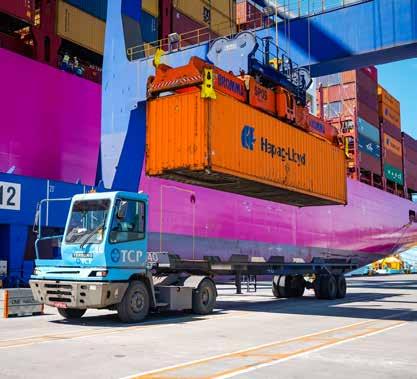
“We are back to two lanes now and the new road concessions have been awarded so works will start very soon, hopefully in April,” explains Guidolim. “The new concessionaire will improve access to the port by by-passing the city of Paranagua, and there are stipulations too about improved maintenance of the highways. It looks very positive.”
Paranagua has been a common gateway for both dry bulk (especially grains), breakbulk and containerised cargoes to land-locked Paraguay and the “Integration Ring” of roads has been bolstered by the “Integration Bridge”(connecting Foz do Iguacu, in Brazil, with Cidade Del Este, in Paraguay). This has been built by the Itaipu Dam bi-national hydro-electric company primarily for trucks and freight - at a cost of US$73.23 million – and will greatly facilitate even more boxes moving to/from Paraguay for TCP.
‘‘
TCP, along with other Paranagua port operators, will be one of the main beneficiaries of the multi-billion dollar infrastructure improvements
Guidolim sees the billions being spent on Parana infrastructure and the bridge to Paraguay as being of a “huge benefit” both to TCP and the Paranagua port community in general as Paraguay is a “huge market”, and shippers are increasingly using the “Paranagua Gateway”, rather than the longer haul, via river to Buenos Aires.
“We have increased our business so much with Paraguay in recent years,” he adds. “In 2014 we handled just 40 containers per month for Paraguay, and today it is always between 400 and 500 per month. It’s a huge business for us.
“All these developments added together are positive not just for us but for the entire Paranagua port community and for the city as a whole. It will improve the traffic flows for everybody, for the state of Parana and Brazil as a whole; not just for containers but also for breakbulk.”
PORT DEVELOPMENT: BRAZIL For the latest news and analysis go to www.portstrategy.com JANUARY/FEBRUARY 2024 | 43
8 To handle the growing volume TCP is also adding 100 new equipment operators
GETTING READY FOR COASTLINK
Maurice Delattre, Regional Director, Port of Amsterdam International, talks one to one with Port Strategy highlighting short sea shipping as being key to sustainability, as the port readies to host this year’s Coastlink conference
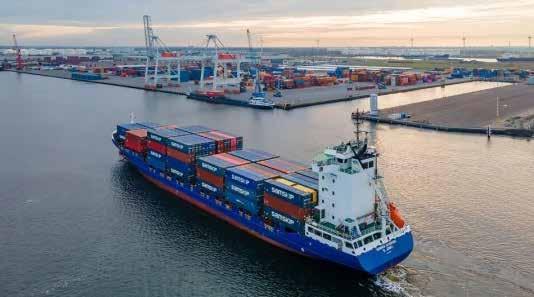
Q A
With regard to short sea, can you explain the port’s offering and give some context on market share?
As a European port with a strong international network of partners, short sea shipping is of strategic importance to us and our customers. Facilitating multimodal transport between various European regions is a key component in ensuring more sustainable supply chains and ports play an important role as hubs for feeder and short sea connections for all kinds of cargo flows. Historically, our customers have established strong ties with i.e. Scandinavia and the Baltic region, as well as the UK and Ireland.
Our service offering is therefore mainly concentrated on facilitating trade between these regions, the Netherlands and Germany and continental Europe via short sea, rail and inland shipping. Via our port, partners such as Thor Shipping, Samskip and DFDS operate weekly services with fast turnaround times and a customer-oriented approach characterised by high flexibility. In this context, we are continually working on the expansion of our European network by adding capacity to existing liner services or by developing new connections together with our partners.
Q A
What makes Amsterdam unique in its approach to short sea?
The geographical location of the Netherlands, and the North Sea Canal Area (NSCA) in particular are key advantages when it comes to accommodating the individual service and logistics needs of shippers and service providers. Our region is historically characterised by strong industrial activities, international logistics hubs and the metropolitan region Amsterdam being the largest economic cluster in the Netherlands. This constellation bears great potential in facilitating trade via short sea shipping.
Next to extensive terminal capacity, cross-docking, as well as all-weather handling and storage facilities, our customers are able to provide a wide range of specialised services. On top of that, the close proximity to Europe’s fourth largest airport and its surrounding logistics cluster enables our customers to combine all modes of transport. In recent years, we have seen steady growth in our general cargo segment, as a result of strong demand for intra-European transport in both, containerised and bulk commodities.
Due to capacity requirements, the need for fast transit times and as well as thanks to our strategic partnership with duisport, the port of Amsterdam was able to gradually develop its hub function helping facilitate efficient and sustainable transport across Europe.
Q A
What is the port’s current focus in terms of business strategy, is short sea one of them?
Short sea shipping is a key pillar in our business strategy.
As a partner, we are involved in several initiatives to promote new and existing network connections in the market. We do so by working closely with the Federal Ministries, as well as our customers and other relevant stakeholders to ensure that short sea shipping receives the desired attention in the market.
Based on recent studies and given the anticipated increase in cargo volumes towards 2030 and beyond, it is expected that consolidation of cargo flows and transport via short sea will become even more important in the near future. Therefore, we are investing in our port infrastructure to make it fit for the longterm. In addition, we are currently working on our new business strategy 2025-2030 in which short sea shipping plays a prominent role being a key modality linking to all general cargo segments modality linking to all general cargo segments.
8 The Port of Amsterdam has under development its new business strategy 2025 –2030 in which short-sea shipping figures large
SHORT-SEA SHIPPING UNDER THE SPOTLIGHT 44 | JANUARY/FEBRUARY 2024 For the latest news and analysis go to www.portstrategy.com
With regard to green hydrogen, which we know is big on the port agenda, how does this fit in with short sea and the overall decarbonisation objectives at the port?
Together with our international partners and various stakeholders we are involved in various strategic initiatives in the context of the production, import as well as distribution of renewable hydrogen and synthetic fuels to the respective end-users.
We believe that all kinds of initiatives leading to reduced CO2 emissions are necessary in order to be able to work towards our joint global emissions reduction targets and adhere to the EU guidelines as part of the “Fit for 55” package.
To meet these ambitious targets, ports play a crucial role in facilitating the energy transition, especially when it comes to providing space and infrastructure, but also in creating private and public partnerships between multiple industries. Moreover, ports serve as central nodes for sector coupling and energy system integration which directly contributes to the transition towards more use of renewable energy products.
In the last couple of years, we have seen an increasing number of promising developments, strategic partnerships and (pre-)investment decisions being made. Our teams at Port of Amsterdam are interacting with various stakeholders to help drive these kind of initiatives forward. For this reason, we are working closely together with strategic partners, such as Samskip, on the development of green corridors and the supply of renewable hydrogen and e-fuels in the foreseeable future.
These kind of partnerships not only strive for the decarbonisation of transport chains, where ports have an important function, e.g. as hubs for multi-fuels bunkering facilities, but also for the development of new energy ecosystems in providing land for production, jointly developing low carbon energy projects or supplying large volumes of renewable energy carriers to help decarbonise hard-to-abate industries. In order to strengthen Port of Amsterdam’s leading position as a European energy port, these activities focus on the reduction of CO2 emissions within transport chains. Hence, they are also directly contributing to our overall goal: To achieve net carbon neutrality by 2050.
What about other alternative fuels, what other activities are taking place at the port which are helping bolster the energy transition and the move to alternative fuels?
As a large energy hub with more than 50 per cent of our total cargo turnover coming from energy products, naturally we aim to take on a leading role in expanding our product portfolio and thereby increasing the share of bio and synthetic fuels as part of the total energy mix.
For example, Amsterdam is currently one of the largest gasoline ports in the world with an extensive network of partners active in liquid bulk, such as petrol, diesel, kerosine, LPG, chemicals, biofuels and renewable hydrogen. By making use of this existing network, as well as the energy infrastructure inherent in the port area, the port of Amsterdam has unique prerequisites to transform towards a renewable energy port in the near future.
In recent years, the product variety in the energy cluster has expanded with an increasing share of biofuels. By 2025, our target is to grow the percentage of total turnover of alternative fuels and energy sources, such as biofuels and hydrogen to 12.5 per cent. In this context, Port of Amsterdam is actively involved in the development of new value chains for hydrogen and its derivatives by actively collaborating with international partners on establishing up, mid- and downstream activities along the entire chain.
SHORT-SEA SHIPPING UNDER THE SPOTLIGHT
In recent years, the product variety in the energy cluster has expanded with an increasing share of biofuels
For this purpose, the “H2A Foundation” was founded in 2023 which enables various local companies and international partners to join forces in realising the largescale import of renewable hydrogen through multiple vectors via the port of Amsterdam. The H2A consortium has been initiated by Evos, SkyNRG, Port of Amsterdam, Zenith Energy Terminals, Hydrogenious (Germany), Electriq Global (Israel), the Municipality of Amsterdam and the Project Office North Sea Canal Area. All of these parties share a common vision focused on the development of new value chains with the aim to meet the anticipated high demand for renewable hydrogen and e-fuels in the near future.
Ultimately, we are actively engaging in strategic projects with terminals, suppliers, off takers, technology providers and public stakeholders in order to develop the port into a renewable energy hub for Northwest Europe in the coming years.
Q A
How does short sea fit in with the port’s overall environmental targets and the demands of the supply chain?
Short sea shipping has a vital role in making shipping and transportation more sustainable. On the one hand, it helps increasing the reliability of international supply chains and on the other hand, in light of steadily increasing cargo volumes, it provides a great solution for shipping goods over longer distances and arranging the first and lastmile transport by truck.
In today’s fast-paced environment, smart logistics solutions are needed to satisfy customer demands and short sea is a key enabler in transporting large volumes of goods between European regions in a reliable and sustainable manner. Thereby, it actively contributes to a reduction of CO2 emissions, especially with an increasing share of renewable fuels being used in the coming years which is a key requirement for customers in modern supply chains.
Q A
Lastly, in your own words, why should people attend the Coastlink Conference this year?
Coastlink offers a unique network of professionals from all over Europe who are jointly engaging and interacting with each other during the conference. The programme is highly interesting for anyone active in our industry as it touches on all relevant topics in the field of transport & shipping, business & logistics as well as sustainability and energy transition. Coastlink therefore offers a unique opportunity to meet in person with business professionals, shippers, representatives of shipping lines, terminals and ports, but also industry experts and consultants who are all working in the same field of business.
Coastlink is a neutral pan-European network dedicated to the promotion of short sea and feeder shipping, and the intermodal transport networks through the ports that support the sector.
It takes place this year from 24 to 25 April at the Port of Amsterdam.
For the full programme, info on delegate or exhibitor places, visit https://www.portstrategy. com/coastlink or email info@coastlink.co.uk
For the latest news and analysis go to www.portstrategy.com JANUARY/FEBRUARY 2024 | 45
Q A Q A
‘‘
DATA AND DECARBONISATION

SECTOR ANALYSIS: ALTERNATIVE POWER/NEW DIGITAL SOLUTIONS
Growing demand for green technology, fuel efficiency and data driven solutions are powering the reach stacker market. As terminals strive to decarbonise their cargo handling equipment, manufacturers are meeting these demands with electric, hybrid and biofuel powered options. There is also an emerging market for hydrogen fuel power. Last year Spain’s Port of Valencia welcomed a hydrogen fuel cell powered reach stacker developed by Hyster. Over the next decade, APM Terminals estimates it will need to buy or retrofit over 2650 pieces of electric heavy port equipment, including 500 electric reach stackers as part of its US$60 million electrification pilot to speed up the decarbonisation of terminal equipment. The global terminal operator says that a key challenge is the availability of “competitively priced” heavy-duty equipment such as reach stackers. It says: “Research and development in this area has been
slow off the mark and for ports around the world looking to make eye-watering investments in new electric equipment, numerous questions remain unanswered.” Elsewhere, US-headquartered Transparency Market Research’s Reach Stacker Market report, released in October 2023, highlights the development of data solutions. “Reach stackers are increasingly equipped with advanced digital systems and telematics for realtime monitoring and data-driven decision-making,” it says. There has also been a growth within autonomous reach stackers, including advanced sensors and AI. The study says that as the variety of cargo types expands, there has been increased emphasis on specialised reach stackers that cater to unique handling requirements, such as oversized loads. Such themes are highlighted in the below company by company review of recent and planned innovations.
SUSTAINABILITY, EFFICIENCY & REAL-TIME MONITORING UPTAKE
8 Camblift: Sweden-headquartered Camblift launched its first product in 2022 - a reach stacker that is available with an electric or diesel driveline. It has a reach depth of three to four rows, a lifting capacity of
8 CVS FERRARI: The Italy headquartered company scooped an Italian Terminal and Logistic (ITALA) for its reach stacker Energy Saving package. The awards ceremony was held by crane and aerial lift exhibition GIS 2023 at Piacenza Expo, Italy, in October 2023. CVS FERRARI won the ITALA 2023 Green Award because its hardware and software solution package eliminates fuel wastage and excess consumption, boosting fuel efficiency by up to 25 per cent without any
46,000kg and a stacking height of five to six containers high. Carl-Olof Eckerbom, CEO, Camblift says that the reach stacker enables a “high output in a sustainable and reliable way”.
reduction or limitation of the reach stacker torque and power. Recent uptake of its Energy Saving package can be seen by Salerno Container Terminal in Italy, which in August 2023 took delivery of three CVS FERRARI E-series reach stackers, fitted with the Energy Saving package. CVS FERRARI was founded in 1974 and manufactures heavy capacity lift trucks and reach stackers for container handling and industrial applications.
REACH STACKERS 46 | JANUARY/FEBRUARY 2024 For the latest news and analysis go to www.portstrategy.com
8 Kalmar has officially handed over its first fully electric reach stacker to Cabooter Group’s Greenport Venlo terminal in the Netherlands
8 Hyster: Hyster has embraced a strategic initiative which will see Hyster RS45 ReachStackers provided from production locations in both Nijmegen, the Netherlands, and Fuyang, China from this year. The US headquartered company explains: “This dual source supply chain helps meet the needs of the global market, enabling customers to benefit from time efficient delivery for economically viable trucks”. Hyster RS45 ReachStackers feature Stage IIIA compliant engines, which Hyster says makes them well suited to non-regulated markets, such as those in the Middle East and Africa. Elsewhere, in October 2023, the iTerminals 4.0 Project, in which Hyster is a participant, won Best Innovation Project at the Waterborne Awards. The iTerminals 4.0 project includes pilot programmes where digital technologies are deployed in real operations at European ports. Hyster is currently involved in two pilots around preventative maintenance for port
8 Kalmar: Finland’s Kalmar, part of Cargotec, has introduced a range of new sustainability options for its eco-efficient electric reach stacker. Launched last year, Kalmar customers now have the option of having their electric reach stacker constructed with 47 per cent SSAB Zero™ steel, which is made from recycled steel and produced using fossil-free electricity and biogas. Customers can now replace standard oil with PANOLIN biodegradable hydraulic oil and extend the tyre lifetime through eco driver training and a tyre pressure monitoring system. Kalmar is also introducing a new emission-reducing counterweight made from unprocessed naturally heavy material to replace the standard cast-iron counterweight. It has extended the market reach of its electric reach stacker, which was launched in 2021. In December it announced that it was beginning production of
8 Konecranes: Konecranes has launched a reach stacker to handle heavier empty containers. Last year the Finland headquartered company introduced its SMV 128 TC6 reach stacker for semi-laden and empty containers that can handle up to 12 tonnes. In addition, a new, stronger combi spreader, for the handling of laden ISO containers and trailers, is now available for Konecranes reach stackers designed for intermodal operations. These lift trucks combine a long wheelbase for maneuverability and can now add one additional metric tonne to their lifting capacity on each row. Konecranes notes: “The ability to handle bigger loads adds strength and flexibility to daily operations, raising productivity by moving more in less
8 Sany: China headquartered Sany, which also operates in Europe as Sany Europe, introduced its electrically driven port machinery, including reach stackers, in Europe last year. This port equipment has previously been available in China and other Asian countries and has been adapted to European standards and operator habits. SANY offers a hybrid reach stacker, with its two drive types (combustion engine and simple hydro-pneumatic drive) contributing to a 20 per cent
8 Terminalift LLC: US based Sigma Powertrain has entered into a client supplier partnership to supply its EMAX Transmissions into Terminalift’s reach stackers. Sigma describes its EMAX multi-ratio gearbox as a “power dense, high torque, rugged solution for the demanding duty cycle of reach stacker vehicles”. “Sigma Powertrain is pleased to play a role in electrifying port vehicles with Terminalift. We are a natural fit. These reach stackers have incredible loads up to 300,000 lbs, and the EMAX is a perfect fit for these extreme operating conditions,” says John Kimes, Founder and CEO, Sigma Powertrain, at the time of announcing the agreement,
REACH STACKERS
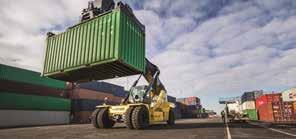
equipment such as reach stackers, one which is focused on smart tyre pressure monitoring, and the other on dynamic oil monitoring. The iTerminals 4.0 project has led to the creation of TIC 4.0 (Terminal Industry Committee), of which Hyster is co-founder. See also p32 & 33 for Hyster’s hydrogen fuel cell powered reach stacker.
this model at its Shanghai manufacturing plant. Alf-Gunnar Karlgren, VP, Counter Balanced, Kalmar explains that this is an “important step” as Kalmar is “electrifying and expanding our global delivery capability.” And in January this year, Kalmar announced that it had received a large order from Norwegian logistics service provider Wallenius Wilhelmsen to supply equipment including two electric reach stackers for the company’s US logistics network, which includes eight terminals. This represents the first sale of its electric reach stacker to a customer in the USA. Another milestone is the handing over of its first all-electric reach stacker to longterm partner Cabooter Group following a six-month testing period, in May last year. The reach stacker is continuing operations at Cabooter Group’s Greenport Venlo intermodal terminal in the Netherlands.
time.” Intermodal reach stackers are available with Ecolifting options to lower carbon emissions. Flow Drive reduces CO2, fuel consumption and costs by up to 25 per cent using a hydromechanical variable transmission and what the company describes as a “unique” engine compartment design. All new generation Konecranes’ reach stackers can also be run on HVO100, a 100 per cent renewable and fossil-free chemical copy of regular diesel that can reduce fossil-based carbon emissions by up to 90 per cent. New intermodal reach stackers are fitted with TRUCONNECT® basic hardware, allowing users to monitor their fleet in near real-time and get insights on the asset conditions, operational efficiency (including emissions) and productivity.
reduction in emissions. Furthermore, all SANY mobile port machinery that is equipped with a Stage V engine can run on biofuels in addition to conventional fuels. As part of its US$60 million electrification pilot project to speed up port equipment decarbonisation, APM Terminals recently signed an agreement with SANY for a long-term collaboration on the further development of electric port equipment. This includes electric reach stackers.
in June 2022. Sigma Powertrain develops electric powertrain technology for commercial trucks. It says its clutch technology for electric commercial vehicles, enables faster shift times and improved efficiency. The fully electric MID and EMAX powertrains provide solutions for Class 1-6 and Class 6-8 commercial vehicles and use a common chassis configuration with central drive, with a powertrain no bigger than a traditional transmission. California-based Terminalift LLC is a cargo handling equipment company which offers fully electric heavy-duty equipment and e-mobility and hydrogen conversion kits.
8 Hyster has adopted a dual source supply chain for its RS45 ReachStackers to boost efficient delivery times
For the latest news and analysis go to www.portstrategy.com JANUARY/FEBRUARY 2024 | 47
ENGINE INNOVATION BUILDS

SECTOR ANALYSIS: RACE FOR REDUCED EMISSIONS IS ON
Sector analysis: engine manufacturers are launching new solutions to reduce emissions from port cargo handling plants, with hydrogen being a prime candidate.
Hydrogen is emerging as a front runner as engine manufacturers and terminal operators strive for engines that reduce emissions from port cargo handling plant. As the below company profiles illustrate, there are a range of pilot schemes, developments and initiatives to power port cargo handling equipment with hydrogen. Key to these is industry collaboration, spanning engine makers, hydrogen technology producers, ports and equipment manufacturers. The benefits of hydrogen are highlighted by a whitepaper from Hyster, Raising the Bar, which says:
“Compared to lithium-ion battery power, hydrogen fuel cells possess key differences, along with an important similarity. Fuel cells do not need to be recharged. Instead, operators refuel a tank of hydrogen, more
similar to the process and time spent refuelling an Internal Combustion Engine (ICE) than lengthy battery charging. But while diesel-powered vehicles produce GHG emissions during operation, equipment powered by hydrogen fuel cells only emits water and heat.” There is likely to be an increasing amount of port equipment engines fuelled by hydrogen, as the supply chain strengthens. “Major companies are joining forces to build a regional hydrogen network to produce and distribute hydrogen fuel at scale,” says the report. But hydrogen is not the only cleaner fuel on the cards – there has also been a focus on using bio diesel options for port equipment engines. Rolls-Royce highlights the advantages of deploying HVO – a reduction of CO2 emissions by up to 90 per cent compared to fossil diesel, it could drive competition and thus improve pricing.
COLLABORATION, INNOVATION, R&D AND RETROFITS
8 Cummins: US-headquartered Cummins has struck a letter of intent with Taylor Machine Works Inc to integrate its hydrogen engines into the company’s product line. Taylor Machine Works plans to integrate the Cummins 6.7-litre and 15-litre hydrogen engines as part of its “Beyond Clean Lifting” commitment to a sustainable future. This effort includes battery electric trucks, hydrogen fuel cell trucks, and now hydrogen internal combustion engines (H2ICE) for the heavy lift, including port operations, market. Taylor Machine Works says that hydrogen combustion engines will “create a zero-carbon fuelled solution that provides cost effective equipment for high load factor, high utilisation applications”. Adding H2ICE to the mix of zero carbon
solutions will also reduce the load required from “already stressed” utility grids. Commonalities with traditional internal combustion equipment will provide solutions that are dependable and easy to service and maintain. Antonio Leitao, Vice President Off- Highway Engine Business, Cummins, says of the plans: “We see hydrogen internal combustion engines as a solution to help drive sustainability improvements in our industry. Hydrogen power will help both OEMs and end-users looking to making carbon emissions reductions on their paths to zero.” Cummins engines power a large portion of more than 100 different models of lift trucks manufactured by Taylor Machine Works.
CARGO HANDLING PLANT: ENGINES 48 | JANUARY/FEBRUARY 2024 For the latest news and analysis go to www.portstrategy.com
8 The Duisburg Gateway Terminal, under construction, is partnering with Rolls Royce to achieve hydrogen powered container handling
8 Nuvera: US-headquartered fuel cell engine manufacturer Nuvera is working with Hyster-Yale Group to develop alternatives to diesel port equipment. Two Nuvera E-45 fuel cell engines are powering the first real-world pilot of a hydrogen fuel cell-powered container handler at the Port of Los Angeles. The Hyster-Yale Group fuel cell-powered Hyster top-pick container handler is part of a project funded by the California Air Resources Board (CARB) and managed by the Center for Transportation and the Environment (CTE). The machine is being operated by Fenix Marine Services, a terminal operator owned by CMA
8 Perkins: Perkins has launched a collaboration to develop and produce an advanced multi-fuel ‘drop-in’ hybrid integrated power unit. The power unit will be able to directly replace its diesel equivalent in terms of power density and response, enabling a wide range of off-highway industrial OEMs to accelerate their transition to lower-carbon intensity or zero carbon fuels such as hydrogen, methanol, bio-ethanol and other eFuels and harness electrification. The design will support several fuel types with the initial demonstration deploying hydrogen. Project Coeus - Perkins’ collaboration with electric engineering specialist Equipmake and Loughborough University’s Mechanical, Electrical and Manufacturing Engineering School – will develop a 7-litre Perkins® 1200
8 Rolls-Royce: Germany headquartered Rolls-Royce Power Systems has taken a step towards a more climate friendly future with the approval of its mtu Series 1000, 1100, 1300 and 1500 engines for sustainable fuels. Used within industrial applications including port cargo handling equipment, the engines have been released for use with EN15940 paraffinic diesel fuels following bench testing. Sustainable synthetic fuels include BtL (Biomass to Liquid), HVO (Hydrotreated Vegetable Oil) and PtL (Power to Liquid) such as e-diesel. Rolls-Royce explains that to convert from conventional diesel fuel made from fossil petroleum to synthetic fuels of the EN15940 standard, no adaptation of existing engines is necessary. “The use of sustainable fuels enables our industrial customers to significantly reduce
8 Scania: The Swedish manufacturer has developed an inline engine platform set that it says offers major CO2 emissions improvement. “This is our most fuel-efficient engine ever, with more torque, more power and up to 50 per cent longer base engine lifespan. A game-changer for power solutions,” says Joel Granath, Senior Vice President and Head of Power Solutions, Scania. Scania explains that the enhanced gas exchange system, reduced internal friction, and increased turbocharger efficiency all have a positive impact on the fuel-efficiency of the engines, that
8 Volvo Penta: A hydrogen dual fuel generator set for port operations that deploys a Volvo Penta Stage V D8 industrial engine was launched in September last year. The Sweden headquartered engine manufacturer has partnered with NENS Power, CMB.TECH and e-power® International to develop the 250kVA generator. Applying CMB.TECH’s hydrogen dual fuel technology, it can operate in either full diesel mode or in dual fuel mode, where hydrogen can replace up to 80 per cent of the diesel consumption, thereby reducing CO₂ emissions. NENS Power is trialling the generator in various locations to accumulate the necessary experience and validation for this new product. The aim is to bring the hydrogen dual fuel generator set to market. “This pilot is an exciting development in our
CARGO HANDLING PLANT: ENGINES
CGM Group. Elsewhere, Nuvera’s E-60 fuel cell engine will power an empty container handler that Hyster is developing for Hamburger Hafen und Logistik AG (HHLA) in Hamburg, to run on hydrogen fuel produced locally at the HHLA Hamburg Green Hydrogen Hub. Nuvera’s E-45 fuel cell engine will also power a zero-emissions terminal tractor that is being developed by Hyster along with yard truck brand Capacity, for HHLA. Nuvera’s E-series fuel cell engine has been used in the Port of Valencia’s ground-breaking Hyster Hydrogen Fuel Cell ReachStacker.
Series industrial power unit with hybrid-electric components and advanced controls to enable operation on hydrogen fuel. The 45-250 kW hybrid powertrain system will be configured with factory-installed ECM sensors, radiators, cooling packs, filtration, control systems and after treatment hardware in a complete, integrated package that minimises OEM development timelines and reduces engineering and assembly costs. Supported by UK Government funding of £11.14 million, the three and a half-year project will be led by Perkins’ global engineering headquarters in Peterborough, UK, with Equipmake providing epowertrain technology and Loughborough University supporting through advanced engine analytics and emissions control.
greenhouse gas emissions – without compromising performance compared to conventional diesel,” said Dr Lei Berners-Wu, Vice President Global Industrial, Power Systems, Rolls-Royce. Port operator Duisburg has developed a partnership with Roll-Royce as part of the goal for Duisburg Gateway Terminal to be carbon-neutral. Most of the electrical energy required to power the port’s operations will be generated on demand on site using hydrogen. The power installation will comprise two cogeneration plants based on mtu Series 4000 hydrogen engines (2 MW total installed capacity) and three mtu fuel cell systems (1.5 MW total installed capacity). The applications to be powered by electricity generated with hydrogen include the unloading, storage and handling of containers.
have been developed for industrial applications. For the 13-litre engine, this means up to seven per cent improvement in fuel consumption compared to the current generation at the same power output, translating to four litres of diesel saved per engine hour at full load. The engines are compatible with biodiesel blends and HVO. The 13-litre engine has a power range from 368 kW to 450 kW and delivers up to 11 per cent more power and 21 per cent more torque than the current generation. The 11-litre engine has a power range from 202 kW to 368 kW.
stepwise approach to adopting renewable fuels such as hydrogen in our combustion engine production portfolio. We will be able to gain collaborative insights into operations, accessibility, and various other elements that will improve future endeavours in the domain of power generation on top of off-road applications,” says Anders Wernersson, Product Manager, Volvo Penta Industrial. This collaboration follows a partnership agreement between Volva Penta and CMB.TECH to accelerate the development of dual-fuel hydrogen-powered solutions for both on land and at sea applications. Announced in October 2022, the collaboration covers pilot projects and small-scale industrialisation of a hydrogen dual-fuel solution for selected customers.
For the latest news and analysis go to www.portstrategy.com JANUARY/FEBRUARY 2024 | 49
11
TO JUNE
13
202 4 Southampton United Kingdom


Marine Civils is co-located with Seawork
Marine Civils in association with Seawork, Europe’s leading commercial marine event. Dedicated to showcasing the latest equipment and solutions for marine, coastal and other challenging civil engineering projects with unique landscape features.
Reach
a larger audience than ever before
Reserve now for 2024 and make the most of year round marketing support from Marine Civils, Seawork and our leading commercial marine magazines. In print, online, eNews and social media channels.
Marine Civils attracts representatives from:
• Civil engineering
• UK port authorities
• Energy companies
• Conservation organisations, amongst others
With a big overlap in content and business for companies involved in marine construction, the event is uniquely positioned to provide invaluable opportunities to access wider relevant audiences via Seawork and Maritime Journal.
For more information visit: seawork.com
contact: +44 1329 825335 or email: info@seawork.com



Media partners:
#Seawork
MARITIMEJOURNAL COMMERCIAL MARINE BUSINESS PORTSTRATEGY INSIGHT FOR PORT EXECUTIVES
Supporters

A UTOMATION TECHNOLOGY

ifm electronic gmbh ifm is one of the world’s leading sensor companies in the automation of measurement and control, optimizing technical processes in almost all industries.
+49 201 24 22 0 info@ifm.com www.ifm.com
B ULK HANDLING

Bedeschi S.p.A
For more than a century, Bedeschi is providing effective and reliable solutions in a wide variety of industries (bulk handling, marine logistics and mining), capitalizing on synergies and cross competences.
Via Praimbole 38, 35010 Limena (PD) – Italy
Tel: : +39 049 7663100
Fax: +39 049 8848006
Email: sales@bedeschi.com
Web: www.bedeschi.com
B ULK HANDLING

Telestack are a leading global manufacturer of equipment for the bulk material handling industry including Ship Loaders/Unloaders, Hopper Feeders, Truck Unloaders, Bulk Reception Feeders, Stockpiling Conveyors, Link Conveyors and Telescopic Stackers.
Tel: +44 (0)2882 251100
Email: sales@telestack.com
www.telestack.comw
#WeHaveTonnesToTellYouAbout
C ARGO HANDLING SYSTEMS

LASE Industrielle
Lasertechnik GmbH
LASE offers innovative and productive solutions for ports by combining state-of-the-art laser scanner devices and sophisticated software applications. We are specialised in the fully automated handling of containers, cranes or trucks.
Rudolf-Diesel-Str 111 D-46485 Wesel, Germany
Tel: +49 (0) 281 - 9 59 90 - 0 info@lase.de
www.lase.de
Telestack Directory June 2021.indd 1 26/05/2021 12:20
DRY AGRIBULK MATERIALS
HANDLING SYSTEMS :
– Portable grains pumps
– Pneumatics continuous barge and ship unloaders 100-1200 tph
– Simporter twin-belt unloader up to 2500 tph
– Loaders up to 2500 tph
Complete turnkey projects
VIGAN Engineering S.A. Belgium
Tél.: +32 67 89 50 41 www.vigan.com/info@vigan.com

The BEUMER Group is an international leader in the manufacture of bulk material handling systems:
Overland Conveyor
Pipe Conveyor
Stacker & Reclaimer Shiploader
Tel.: +49 2521 240
E-mail: info@beumer.com
Web: www.beumer.com

Rohde Nielsen A/S Specialising in capital and maintenance dredging, land reclamation, coast protection, Port Development, Filling of Caissons, Sand and Gravel, Offshore trenching and backfilling
Nyhavn 20
Copenhagen K.
DK-1051
Denmark +45 33 91 25 07 mail@rohde-nielsen.dk www.rohde-nielsen.dk

DELLNER DAMPERS AB
Customised damper and buffer solutions for container spreaders and ship-to-shore, rail mounted gantry and process crane’s. When fitted to spreaders, our dampers protect the hydraulics’ and reduce noise. Our HYBUFF buffers protect operators and prevent damage in the event of an involuntary impact.
P.O. Box 51, SE-642 22, Sweden +46-(0)157-45 43 40 www.dellnerdampers.se/
E LECTRIFICATION SOLUTIONS
VAHLE PORT TECHNOLOGY
VAHLE is the leading specialist for mobile power and data transmission
VAHLE provides the solutions to reduce the carbon footprint while increasing the productivity.
RTGC electrification including positioning and data transmission making RTGC ready for Automation.
Westicker Str. 52, 59174 Kamen, Germany
Email: port-technology@vahle.de
Web: www.vahle.com
F
ARGO HANDLING EQUIPMENT

Vigan ID.indd 1 25/01/2022 12:03
Over 60 years supporting Container Terminals in port operations: we create strategic value and increase profitability through solid and reliable STS Portainer® and RTG Transtainer® cranes, services & Advanced Port Technologies.
PACECO® CORP.
World Headquarters
25503 Whitesell Street Hayward, CA 94545
Tel (510) 264-9288
email@pacecocorp.com
www.pacecocorp.com


Jan 2021.indd 1 27/01/2021 11:29
SAMSON Materials
design and manufacture of mobile
materials handling equipment for surface installation across multiple industrial segments. Designed for rapid onsite set-up and continuous high performance SAMSON equipment provides an excellent return on investment.
Gemini House Cambridgeshire Business Park, 1 Bartholomew’s Walk, Ely Cambridgeshire CB7 4EA England, United Kingdom (UK)
Gemini House Cambridgeshire Business Park, 1 Bartholomew’s Walk, Ely Cambridgeshire CB7 4EA England, United Kingdom (UK)
Tel: +44 1353 665001

Taylor Machine Works, Inc.
Taylor Machine Works designs, engineers, and manufactures more than 100 models of industrial lift equipment with lift capacities from 4,000-lbs. to 125,000-lbs.
YOU CAN DEPEND ON BIG RED!
3690 N Church Avenue
Louisville, MS 39339 USA
+1 662 773 3421
Fax: +44 1353 666734 sales@samson-mh.com www.samson-mh.com
Tel: +44 1353 665001 sales@samson-mh.com www.samson-mh.com
contact_sales@taylorbigred.com
www.taylorbigred.com
Heavy duty rol e-chain® P4HD.56R
The new heavy-duty rol e-chain meets all the relevant requirements for container cranes of the next and next-but-one generations. Longer and longer travels, greater dynamics, short stress cycles, zero failures.
P4.1 e-chain® Energy chain with optional intelligent wear monitoring for double the service life, travels of up to 1.000 m, speeds of up to 10 m/s and fill weights of up to 50 kg/m.
ENDER SOLUTIONS

ShibataFenderTeam Group
SFT is the leading fender manufacturer with +60 years of group experience in the design of safety critical fender system that protect vessels, port infrastructure and people.
igus® GmbH Spicher Str. 1a D-51147 Köln, Germany
igus® GmbH Spicher Str. 1a, 51147 Köln, Germany
Tel. +49-2203-9649-0 info@igus.eu igus.eu/P4.1
Tel. +49-2203-9649-0 info@igus.eu igus.eu/P4.1

As one of the leading manufacturers of quick connector systems,Stäubli covers connection needs for all types of fluids, gases and electrical power.
Tel: +33 4 50 65 61 97 connectors.sales@staubli.com www.staubli.com/en-de/ connectors/
F
IRE SUPPRESSION SYSTEMS
We offer the full range of customized fender solutions and maintain production facilities for high-quality rubber products, steel panels and foam fenders. Join the safe side. contact@sft.group www.sft.group

Fogmaker develops, manufactures, and markets fire suppression systems for engine compartments with high pressure water mist. Fogmaker is a market leader for automated fire suppression systems with 200,000 installations in more than 50 countries since 1995.
Tel: +46 470 77 22 00 info@fogmaker.com www.fogmaker.com
& SERVICES DIRECTORY
PRODUCTS
C
OMPONENTS D REDGING
Beumer
Directory
C
Handling Ltd specialises in the
bulk
SAMSON Materials Handling Ltd specialises in the design and manufacture of mobile bulk materials handling equipment for surface installation across multiple industrial segments. Designed for rapid onsite set-up and continuous high performance SAMSON equipment provides an excellent return on investment.
Staubli_Directory Mar 2021.indd 1 25/02/2021 15:49
ONNECTION
For the latest news and analysis go to www.portstrategy.com JANUARY/FEBRUARY 2024 | 51
C
SOLUTIONS
Fogmaker Directory.indd 1 01/02/2021 13:12
G RABS

MRS Greifer GmbH
Grabs of MRS Greifer are in use all over the world. They are working reliably and extremely solid. All our grabs will be made customized. Besides the production of rope operated mechanical grabs, motor grabs and hydraulic grabs we supply an excellent after sales service.
Talweg 15-17, Helmstadt-Bargen 74921, Germany
Tel: +49 (0)7263 - 91 29 0
Fax: +49 (0)7263 - 91 29 12 info@mrs-greifer.de
www.mrs-greifer.de

Orts GMBH Maschinenfabrik
Over 40 years experience constructing and manufacturing a wide range of grabs, including electro-hydraulic grabs (with the necessary crane equipment) radio controlled diesel hydraulic grabs, 4, 2 and single rope grabs all suitable for bulk cargo.
Schwartauer Str. 99
D-23611 Sereetz • Germany
Tel:+49 451 398 850
Fax: +49 451 392 374 soj@orts-gmbh.de
www.orts-grabs.de








TPORT AUTOMATION








Künz GmbH
Founded in 1932, Künz is now the market leader in intermodal rail-mounted gantry cranes in Europe and North America, offering innovative and efficient solutions for container handling in intermodal operation and automated stacking cranes for port and railyard operations.
Gerbestr. 15, 6971 Hard, Austria T: +43 5574 6883 0 sales@kuenz.com www.kuenz.com

SANY Europe GmbH
offers a broad spectrum of high-performance mobile port machines such as Reach Stacker, Empty Container Handler, Heavy Duty Forklift Trucks and Material Handler
M OORING SYSTEMS
VISYOy
VISY takes pride in solving operational problems, specialising in gate automation and access control solutions in ports and terminals. Their solutions streamline processes resulting in saving money and increasing productivity.
Visy systems reduce expenses, optimize safety & security, and increase throughput capacity via process automation. Our singleplatform gate operating system and OCR solutions manage all cargo, assets & personnel movements via quay, rail or road to keep operations moving.
Tel: +358 3 211 0403
Email: sales@visy.fi
Web: www visy fi/
Portchain is the leading provider of berth alignment solutions for container terminals and carriers. Portchain works with leading container carriers and terminal operators to create sustainable win-win solutions to improve operational efficiency for container shipping. Founded in 2017 and based in Copenhagen, Portchain works on a global scale serving container terminals and carriers across Europe, Asia, North America, South America and Africa. Amaliegade 14A, st, 1256 København, Denmark sales@portchain.com www.portchain.com

P OWER TRANSMISSION
Conductix-Wampfler
The world specialist in Power and Data Transfer Systems, Mobile Electrification, and Crane Electrification Solutions. We Keep Your Vital Business Moving!
Rheinstrasse 27 + 33
Weil am Rhein
79576 Germany
Tel: +49 (0) 7621 662 0
Fax: +49 (0) 7621 662 144 info.de@conductix.com
www.conductix.com
R EFRIGERATED TRANSPORT

Reefer Monitoring Solutions
Increase efficiency. Reduce costs. Improve safety.
RTE’s 40 years of innovation and experience deliver the most complete system of reefer monitoring solutions for today’s growing terminal operations. Discover what over 80 reefer terminals already have. Visit us at: rte-usa.com
Or email us at: info@rte-usa.com
New York | Panama
Sany Allee 1
Sany Allee 1
D-50181 Bedburg
50181 Bedburg, Germany
Tel: +49 2272 90531 100
Tel: +49 2272 90531 100
Email: info@sanyeurope.com
Email: info@sanyeurope.com
www.sanyeurope.com
www.sanyeurope.com
Taiwan is a major maritime hub on the world’s ocean shipping routes and, because of its strategic location, it has developed into a transshipment hub for East Asian near- and ocean-going ships. In the last few years Asian ports are up against intense rivalry as a result of the economic growth of China and Southeast Asia as well as the expanding trade network in Greater East Asia. No.10, Penglai Rd Gushan Dist. 804004 Taiwan www.twport.com.tw/en/
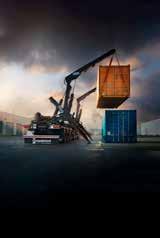
The world leading manufacturer of Sideloaders, self-loading semi-trailers for versatile & efficient container handling.
www.hammarlift.com
info@hammarlift.com


Sany ID.indd 1 25/01/2022 11:42

IDENTEC SOLUTIONS is an industry-leading, trusted partner in managing and monitoring reefer containers and optimizing entire terminal operations through solutions like Reefer Runner and Terminal Tracker.
Contact: Stephan Piworus, Global VP Sales Marine & Ports, spiworus@identecsolutions.com; Mobile: +49 151 74122606 www.identecsolutions.com
S PARE PARTS

TVH is a global player in the field of spare parts and accessories for heavy forklifts, reach stackers, container handlers, spreaders and terminal tractors. With over 96,000 references in stock and more than 644,000 known references, TVH offers quality replacement parts for many brands and makes, including the hard-to-find ones.
Tel: +44 2476 585 000 sales.team.uk@tvh.com www.tvh.com
PRODUCTS & SERVICES DIRECTORY 52 | JANUARY/FEBRUARY 2024 For the latest news and analysis go to www.portstrategy.com
H ANDLING
I NSURANCE P ORT AUTHORITY S IDELIFTER/SIDELOADER TT Club Directory March 2021.indd 1 01/03/2021 14:40 I
EQUIPMENT
To advertise in the Port Strategy Directory Contact Arrate Landera +44 1329 825335 www.portstrategy.com
For more information visit: seawork.com contact: +44 1329 825335 or email: info@seawork.com 11 13 TO JUNE 2024 Southampton United Kingdom Seawork directory.indd 1 25/07/2023 11:27 For more information visit: seawork.com contact: +44 1329 825335 or email: info@seawork.com 11 13 TO JUNE 2024 Southampton United Kingdom Seawork directory.indd 1 25/07/2023 11:27
P ORT AUTOMATION
T
S PREADERS

ELME Spreader AB
ELME Spreader, world’s leading independent spreader manufacturer supports companies worldwide with container handling solutions that makes work easier and more profitable. Over 21,000 spreaders have been attached to lift trucks, reach stackers, straddle carriers and cranes.
Stalgatan 6 , PO Box 174
SE 343 22, Almhult, Sweden
Tel: +46 47655800
Fax: +46 476 55899 sales@elme.com
www.elme.com
T ERMINAL OPERATIONS SYSTEMS

The Brain of Logistics
With more than 30 years experience in IT Solutions and Business Operation Consultancy DSP offers a large portfolio of professional services and products to support terminal operations processes and system.
DSP Data and System Planning SA
Via Cantonale 38 6928 Manno, Switzerland
Tel: +41 91 230 27 20
Fax: +41 91 230 27 31 info@dspservices.ch www.dspservices.ch
ERMINAL OPERATIONS SYSTEMS
Solvo Europe B.V.
Solvo’s software solutions such as TOS or WMS help container and general cargo terminals take full care of their cargo handling processes and make sure the clients expectations are exceeded.
Prinses Margrietplantsoen 33, 2595AM, The Hague, The Netherlands
Tel: +31 (0) 702-051-709
Email: sales@solvosys.com
www.sovosys.com



11





1329 825335 or email: info@seawork.com
T ERMINAL OPERATIONS SYSTEMS

Tideworks Technology provides comprehensive terminal operating system solutions for marine and intermodal terminal operations worldwide. Tideworks works at every step of terminal operations to maximize productivity and customer service.
info@tideworks.com
+1 206 382 4470
www.tideworks.com
T RACTORS
MAFI Transport-Systeme GmbH
Specialised in the development and production of heavy-duty equipment for transporting containers, semi-trailers, cargo/roll trailers and special container chassis in ports and industry.
Hochhäuser Str 18 97941 Tauberbischofsheim, Germany
Tel: +49 9341 8990
sales@mafi.de www.mafi.de
TGI Maritime Software is a Terminal Operating System editor and integrator specialized in the support of Small to Medium Terminals. Its expertise is built on 34 years of experience within the maritime sector. TGI provides comprehensive services to its customers all along their projects. OSCAR TOS and CARROL TOS have already been successfully handled by 40 container and RoRo terminals worldwide.
Tel : +33 (0)3 28 65 81 91 contact@tgims.com www.tgims.com
Brunton Shaw UK is a successful manufacturer of high quality wire ropes for a wide range of applications.
The company effectively combines more than 130 years of experience and tradition with an up to the minute range of products, and a customer service package ideal for the modern market place.
Tel: +44 1909 537626
Email: info@brunton-shaw.co.uk
www.brunton-shaw.com


PRODUCTS & SERVICES DIRECTORY
For the latest news and analysis go to www.portstrategy.com/news DECEMBER 2019 | 53
go to www.portstrategy.com/news DECEMBER 2019 | 53
w
IRE ROPES For more information visit: seawork.com contact: +44
Kingdom visit greenport.com email subscriptions@greenport.com or call +44 1329 825 335 greenport.com port and terminal professionals around the world Informing over 11,300 to receive a digital issue of GreenPort SUBSCRIBE NOW GreenPort magazine provides key insights into environmental best practice and corporate responsibility centred around the marine ports and terminals industry. • Instant access to industry news • Expert opinion • Quarterly features • Weekly eNewsletter TO RECEIVE THE DIGITAL MAGAZINE GREENPORT INSIGHT FOR PORT EXECUTIVES
13 TO JUNE 2024 Southampton United
‘‘
The newly appointed International Maritime Organization Secretary-General, Arsenio Dominguez, has called on Member States to step up and help tackle the issue of an expanding ‘shadow fleet’ of vessels operating around the globe
POSTSCRIPT
SHADOW FLEET TARGETED

It is well known that a growing number of ships are operating outside IMO regulations, evading safety conventions and operating without proper insurance cover, while breaking international sanctions to carry, for example, Russian, Iranian or Venezuelan oil cargoes.
All Member States, when carrying out inspections of vessels calling in their ports, have the opportunity to tackle this situation, said Dominguez. “They have Port State Control capabilities – Member States have to verify compliance with IMO instruments.”
Speaking about the shadow, or dark, fleet at a press conference at IMO headquarters in London, the Secretary-General said: “We call on Member States to uphold their responsibilities when it comes to implementing regulations and we continue communications with all of them to enhance this part of the organisation.”
Dominguez, who took up his new role at the beginning of 2024, set out the IMO’s plans and focus areas for the next four years, including around safety, decarbonisation and environment, supporting Small Island Developing States and Least Developed Countries, improving public awareness and image, and enhancing relations with people and stakeholders. However, the more immediate challenges of the Red Sea and the Black Sea dominated the discussions.
He condemned the attacks on international shipping in the Red Sea and highlighted in particular the impact on seafarers.
“The seafarers are innocent victims being affected by this situation,” he said. “They are doing their daily job in order for all the goods to be transported around the world for the benefit of the whole population – and they should not be targeted.”
The focus of news coverage of attacks on shipping and the diversion around the Cape of Good Hope continues to be on trade and the economy, he observed. While emphasising the importance of freedom of navigation and calling for the deescalation of tensions, he said: “But my first and main message is the seafarers. We need to think about them and what they are going through.”
Asked about the ongoing seafarer shortage and the likelihood that this will be exacerbated with the transition to new fuels, Dominguez outlined the work of the international task force to analyse training and safety regulations, and an ongoing study into ways of attracting new seafarers into the industry. However,
he admitted: “The current situation doesn’t paint the best picture and we have an uphill battle to attract seafarers. We have to enhance the credentials of the industry.”
UNPRECEDENTED TIMES?
With the shortage of water in the Panama Canal and the crises in the Red Sea and the Black Sea, is shipping facing unprecedented times? “I have been in the job for a month but I have been part of this amazing organisation and sector for over 25 years. We have had challenges in the past. But it is unprecedented,” he said. “However, this industry is resilient and continues to demonstrate how it is ready to serve the world.”
He told journalists: “Shipping is resilient and has been for many years. We saw it through the financial crisis and the Covid pandemic and we see it now. It is how we face these challenges. It is also important that we continue to regulate shipping for safety and security.”
While solutions to issues are sometimes not just within the remit of the IMO, he said: “We can contribute to solutions by reaching out to relevant parties and bringing everyone to the table.”
In the Red Sea, practical solutions have included exchanging information to analyse risks, assessing additional security and speaking to the countries in the region which are mostly affected in relation to trade. Egypt, for example, is suffering the economic impact after 24 per cent of Suez Canal traffic has ‘disappeared’.
Dominguez said he wanted to work on the ‘image’ of the IMO. “We normally tend to be on the news when something wrong happens, an incident or accident. But there is not enough highlighting all the good things that happen.”
He praised the achievement of the IMO in adopting the revised Greenhouse Gas Strategy in 2023, which is “giving that certainty that the industry was calling for” and also highlighted the success of the sulphur cap introduced in 2020.
The Secretary-General said he appreciates every opportunity to highlight the seafarers and the work they do. To coin a phrase, he said: “No seafarers, no shipping, no shopping.”
8 Arsenio Dominguez, Secretary General, IMO has called on Member States to address the growing presence of the dark fleet, an entity described by many as an ‘accident waiting to happen’
54 | JANUARY/FEBRUARY 2024 For the latest news and analysis go to www.portstrategy.com


Promote your business to the right audience in the right place at the right time.
Engage with our international audience of decision makers and buyers. The Port Strategy multi-media platforms offer our commercial partners a wide range of opportunities for campaign delivery. We provide bespoke marketing packages with quantifiable ROI.
Port Strategy’s valued content is dedicated to the international ports and terminals business and is delivered through multiple channels.
Arrate Landera, Brand Manager t: (+44) 1329 825 335 e: sales@portstrategy.com www.portstrategy.com Contact us today PORTSTRATEGY INSIGHT FOR PORT EXECUTIVES MAGAZINE RECIPIENTS DECISION MAKERS PAGEVIEWS PER MONTH 17,800 72% 36,240 Reach industry professionals with Port Strategy
202 3
Hamburg Germany

Powering shipping’s emissions-cutting ambitions
Did you miss it?
Downloads available now on powering shippings emissions cutting ambitions.
60 papers and presentations, plus on-demand videos available now.
Access Propulsion & Future Fuels complete downloads for only €330 - Buy here
Sponsored by:

Supported by:

Topics & Presentations cover:
The Cost of Decarbonisation & Who is going to Pay The Solutions for 2030
The Motorship Awards
Safety Challenges for New Technology
LNG Beyond Transition
Alternative Fuel Streams including Methanol, Retrofit, Carbon Capture and many more






Propulsion & Future Fuels is the longest-running technical conference in the maritime sector, providing senior executives with a meeting place to learn, discuss, and share knowledge of the latest developments in efficient propulsion technology and low flashpoint, low carbon fuels.
Visit: motorship.com/propulsion-and-future-fuels-conference
Contact: +44 1329 825335
Email: conferences@propulsionconference.com







2023 44TH 23
NOV
TO
21
#MotorshipPFF
MOTORSHIP MARINE TECHNOLOGY THE Media partner: Media supporters:






 MIKE MUNDY
MIKE MUNDY












 Liebherr Container Cranes Ltd.
Liebherr Container Cranes Ltd.


















































































































